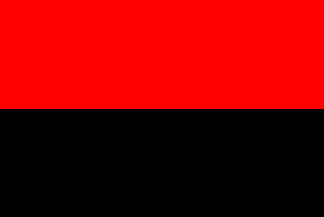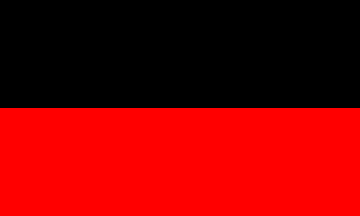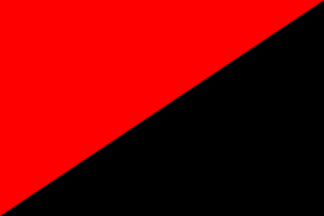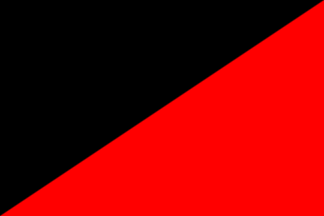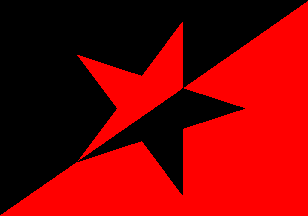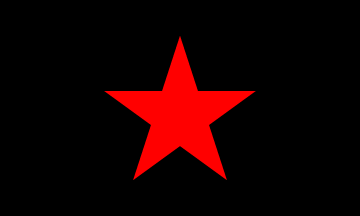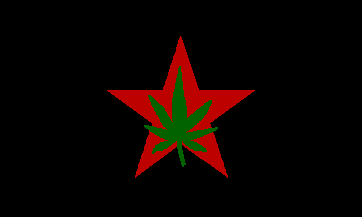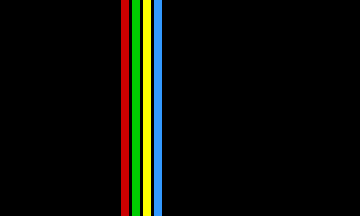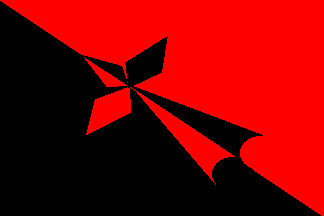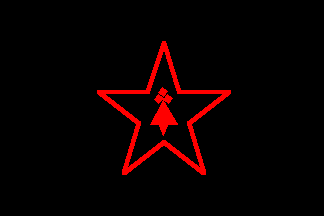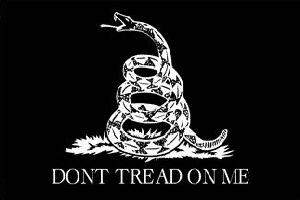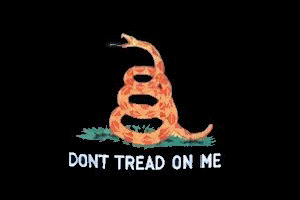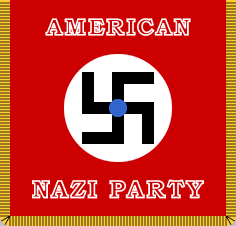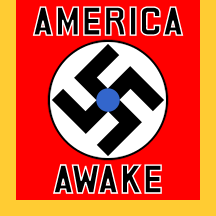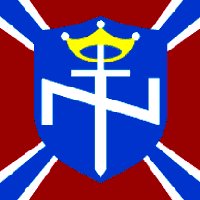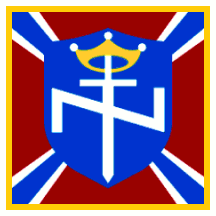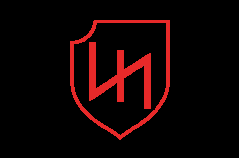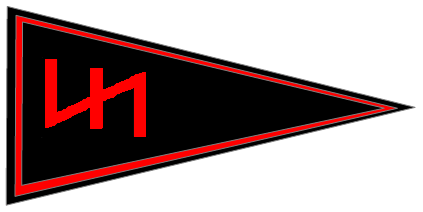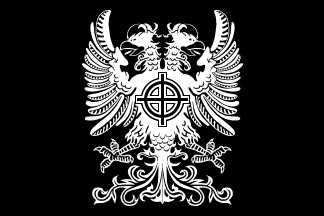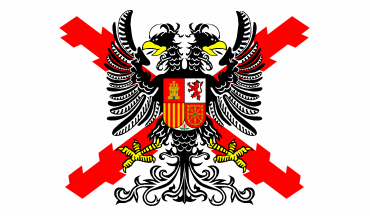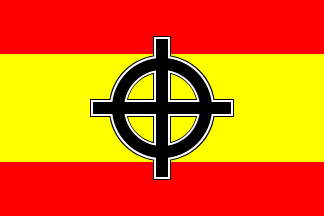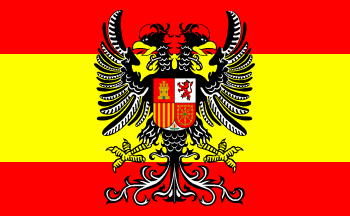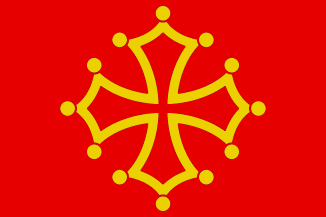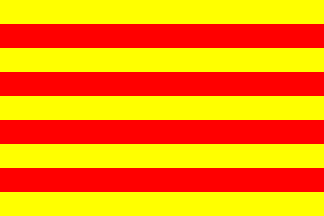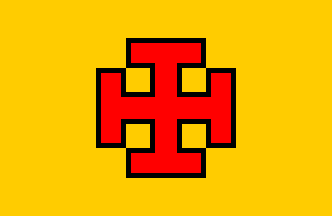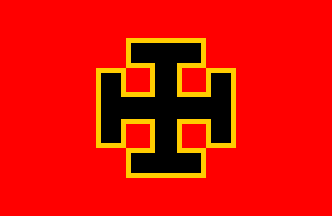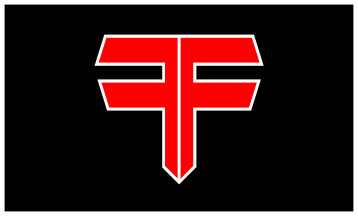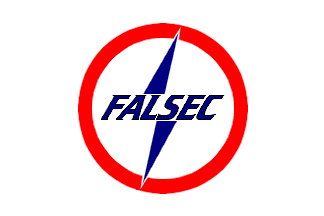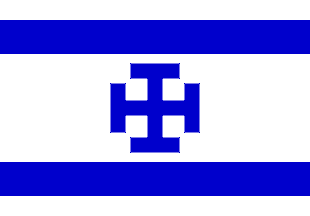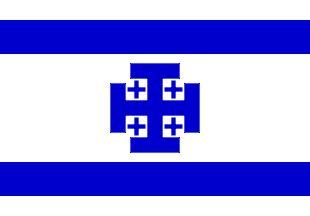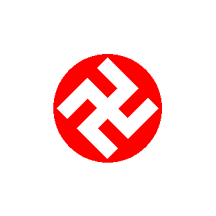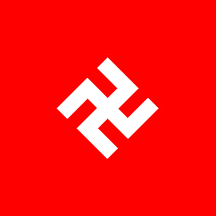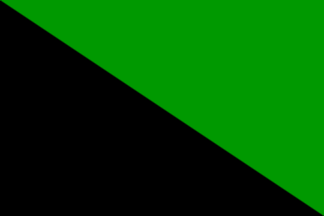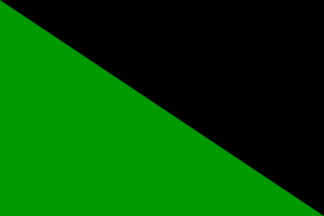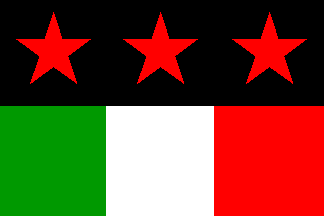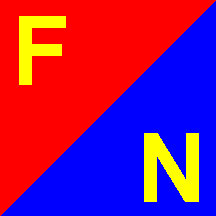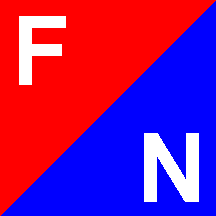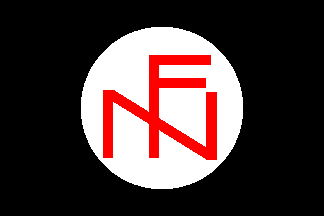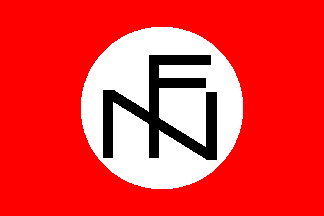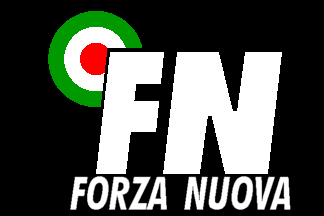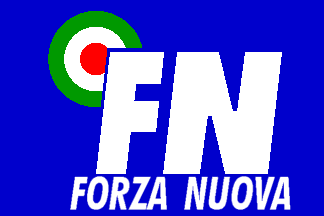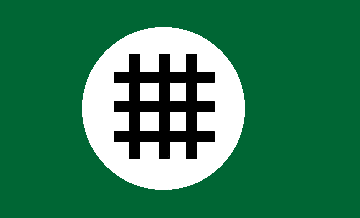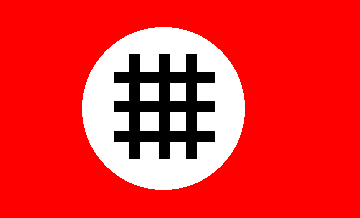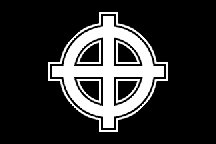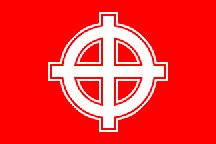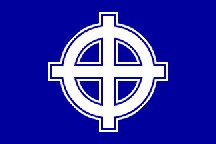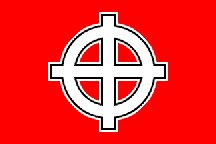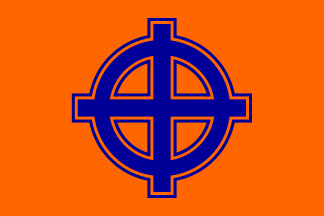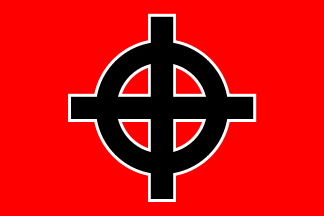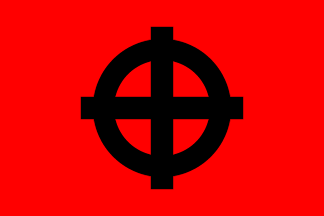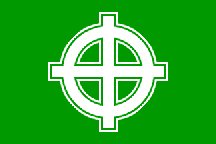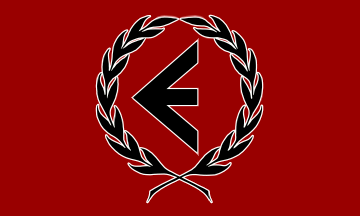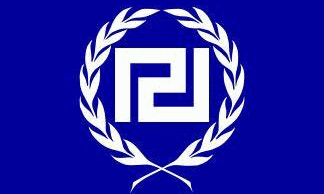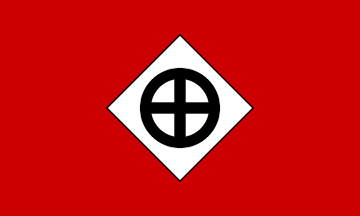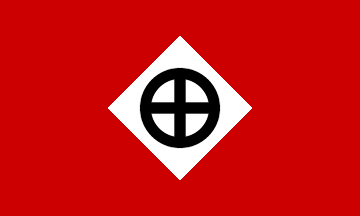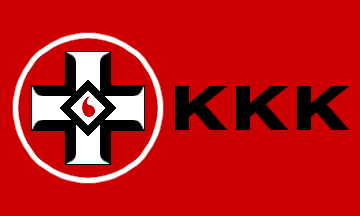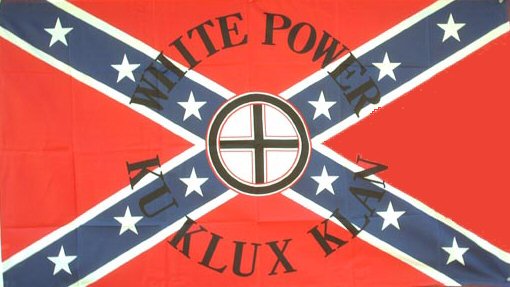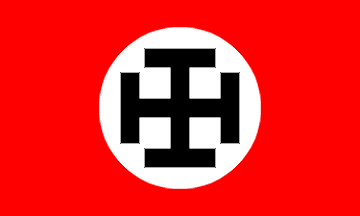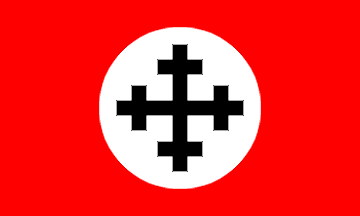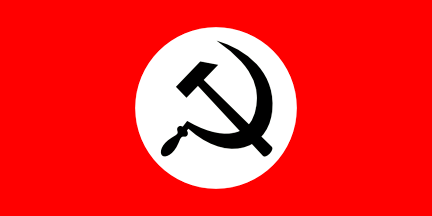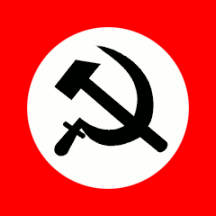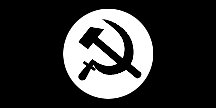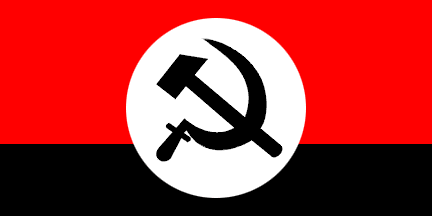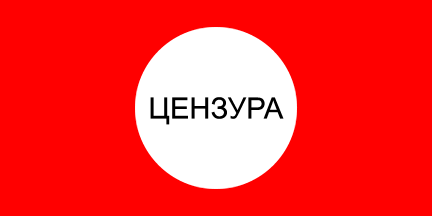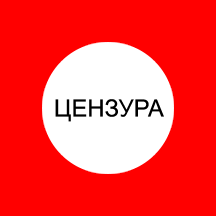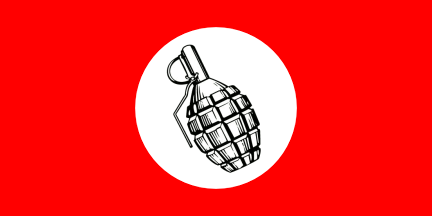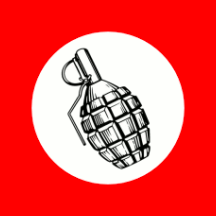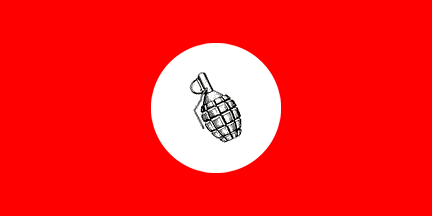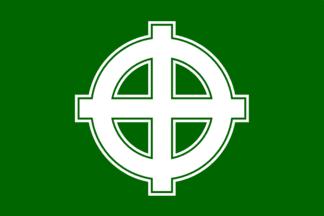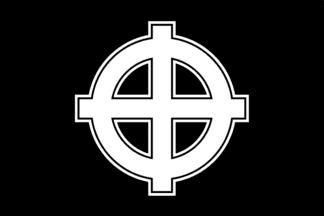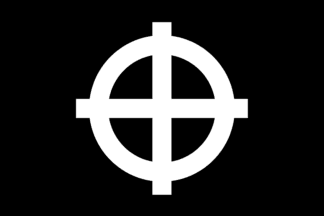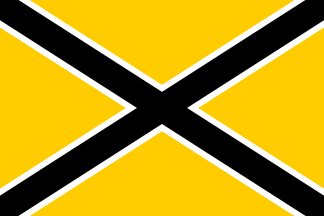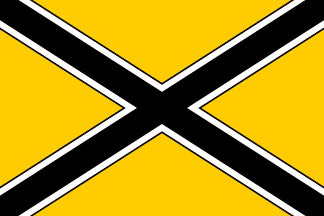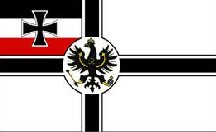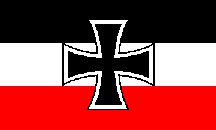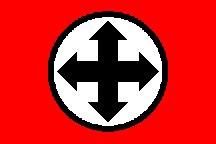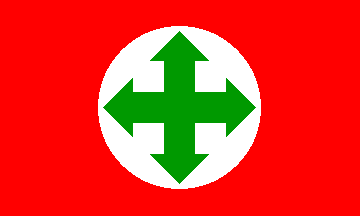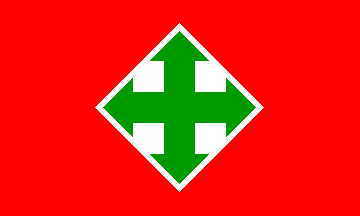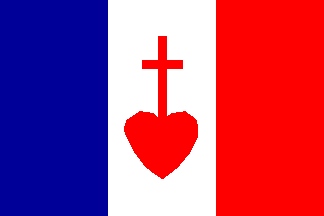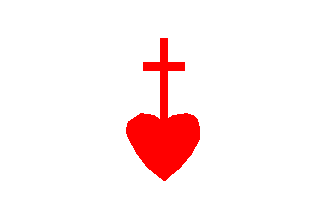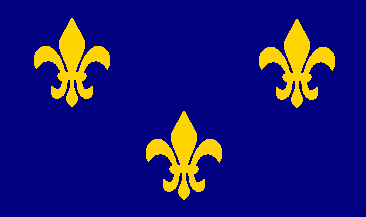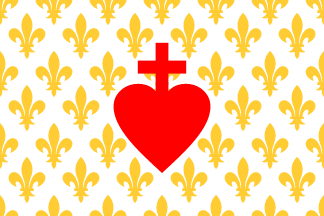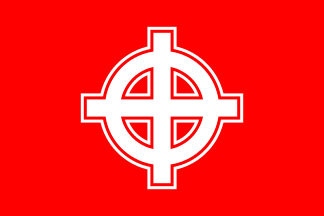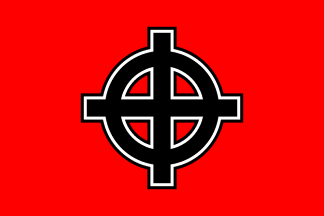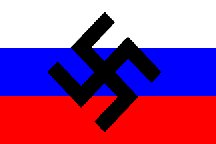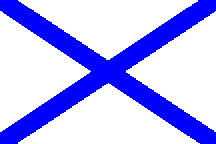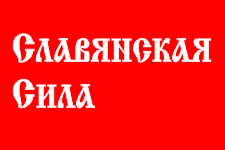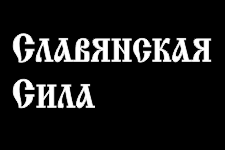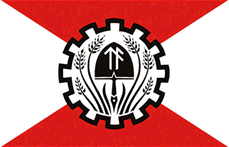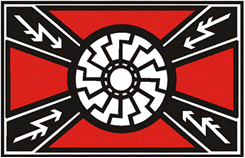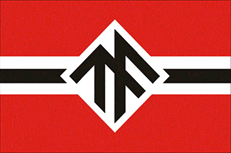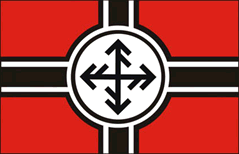Movement Flags

I agonized over these sections. Whether to ignore these flags and what they stand for, or include them was a tough decision. I feared including them would constitute legitimizing them, and certainly didn't want to do that. In the end I thought it important that they be identified for what they stood for, because many times they have been unknowingly displayed or incorrectly identified as historical by unsuspecting or uninformed individuals or flag companies.
These are flags that many times "migrate" from group to group, many of which rapidy appear and disappear as they change their names, and this makes identification even more difficult. Many of these groups were (and are very small) and don't exist any longer, but their flags continue to be used by other modern extremists. Unfortunately, there are a number of people who, like Ayn Rand's characters in "Atlas Shrugged," think there is something wrong in the world, that the world isn't following the right value system. As an alternative, they get into extremist politics like anarchism, environmentalism, neo-fascism, and radical traditionalism. The scary part is that this page only identifies a small portion of the Flags of Extremism being sold today. The sad truth be known, any flag or cultural symbol's true meaning can be used, then distorted and eventually destroyed by their misuse by these extremists groups.
Please be aware that in NO WAY does this site support the beliefs, policies, or philosophies of these organizations, nor encourage the displaying of these flags.
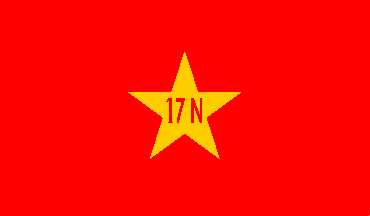 17-N Flag |
November 17 (Greece)
November 17 took its name from the date of an uprising of a group of students at the Polytechnical School in Athens in 1973. The student uprising was crushed by the Greek Military Junta (1967-1974) led by Colonel Georgios Papadopoulos, who had seized dictatorial powers in the coup d´état of 1967. The 17-N group was founded in 1975, one year after the fall of the military junta. Their first act of terrorism was the assasination of Richard Welch, the head of the CIA bureau in Athens. Over 21 people were later added to the murder and kill list of 17-N, including American, British and Turkish diplomats as well as Greek policemen, businessmen and politicians. The group was dismantled with the help of an international task force led by Scotland Yard in 2002. The leaders of the group were Alexandre Giotopoulos, arrested in 2002 on the Island of Lipsos, and Dimitris Koufondinas, known as "the man with a thousand faces," who surrendered to police the same year. |
||||||||||||||||||||||||||||||
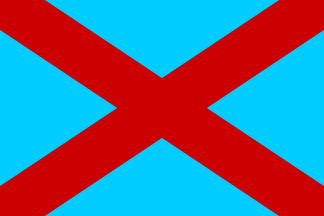 ACA Flag 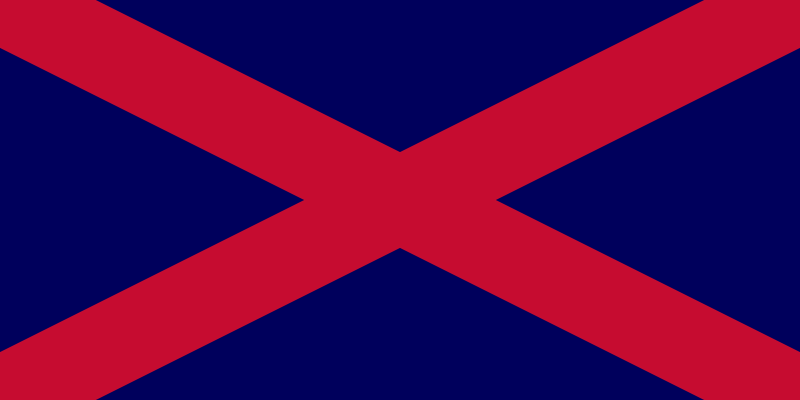 Variant ACA Flag (questionable ratio and color) 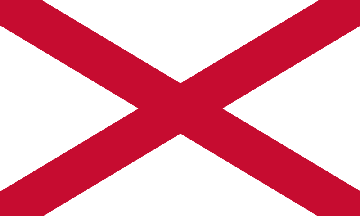 Saint Patrick's cross/saltire - Traditional Irish Flag - (use by the Greenshirts unverified) |
Army Comrades Association (Ireland) National Guard - Blueshirts (Na Léinte Gorma) In 1932, a right-wing Irish organization, first called the Army Comrades Association (ACA), then the National Guard, and eventually merged into the Fine Gael Party, was started by Thomas F. O'Higgins and "General" Eoin O'Duffy, who where the first two leaders. Because the membership wore "St. Patrick´s blue," (sky blue) shirts, they soon became more popularly known by their nickname of "The Blueshirts." The Blueshirts, at least on the surface, appeared to be the Irish equivalent of the German Brownshirts or Italian Blackshirts; they wore paramilitary-style uniforms, greeted each other with Roman salutes, and participated in street violence and fights, usually against the IRA. Although they didn't seem to completely follow Fascist doctrine and didn't engage in political terrorism, the Blueshirts were declared an extremist and illegal organization by the Irish government. After the banning in 1933, the National Guard has merged into the newly founded Fine Gael party, with O'Duffy as its first president who, after serious disagreements with other party leaders, resigned in 1934 and left to form the National Corporate Party, an openly Fascist organization nicknamed the "Greenshirts", in 1935. Only a minority of former Blueshirts followed him; most of them remained in the Fine Gael, which soon distanced itself from the extremism and evolved into a modern party of the center-right, participating in several coalition governments, including the current one (2011-present). O'Duffy later led Irish volunteers to aid the Nationalists in the Spanish Civil War (1936-1937) and had contacts with the Third Reich until his death in 1944, but his "Greenshirt" party was defunct by the end of 1937. The actual flag the Greenshirts used is currently unknown, although one undocumented source indicates they simply used the traditional Saint Patrick's Cross/Saltire Flag. The Blueshirts´ flag, later also used briefly by the Fine Gael Party, was charged with the red saltire of St. Patrick on a field of light sky blue, the same color as used on the Blueshirts´ uniforms. Contemporary black and white photos clearly show flags with dark saltire on a light field that match their shirts, which were worn with dark ties, trousers and caps. The surviving Blueshirts' uniforms confirm the use of the light sky blue. |
||||||||||||||||||||||||||||||
 Anarchist Flag Generic Type #1 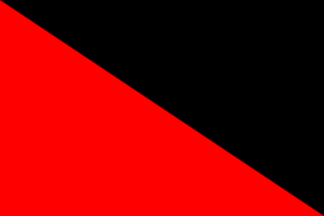 Anarchist Flag Generic Type #2 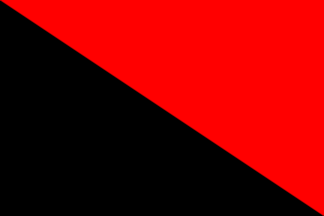 Anarchist Flag Generic Type #3 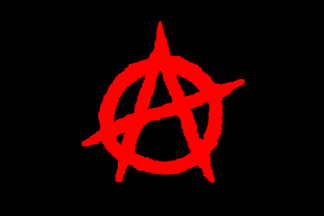 Anarchist Flag Generic Type #4 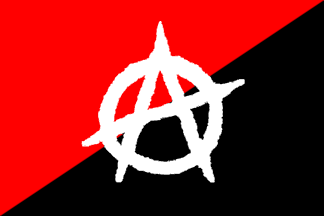 Anarchist Flag Generic Type #5 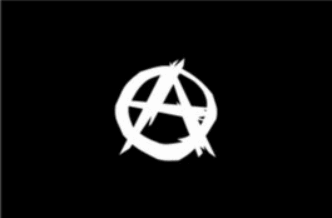 Anarchist Flag Generic Type #6 |
Anarchist Movements (worldwide)
There are probably as many different kinds of Anarchist Movements as there are different ideologies or traditions in most normal societies. The term "anarchism" is basically used by people who want to abolish the government, abolish capitalism, abolish violence, abolish technology, abolish large-scale production, or abolish as existing society as whole. They seek to overturn, by violence if necessary, all constituted forms and institutions of society and government, with no plans for establishing any other system of order in the place of that destroyed. Basically, an anarchist is a person who promotes disorder or revolt against any established rule, law, or custom.
These flags are examples of hundreds of flags used by a wide variety of Anarchist movements world-wide. The generic ones can be found with a large variety of defacements, usually with white lettering, messages, or emblems. The flag of the Youth International Party (late 1960s-early 1970s) is an especially interesting combination: black field for anarchy, red star of socialism, and green Marijuana leaves. Not surprising since the party leaders were Abby Hoffman and Jerry Rubin. |
||||||||||||||||||||||||||||||
 Anarcho-Feminists Flag |
Anarcho-Feminists Flag (worldwide)
The Anarcho-Feminism movement (Anarcha-feminism, anarchist feminism) basically combines anarchism with feminism. It views all "male dominated" society (patriarchies) as an "involuntary and coercive hierarchy" that should be replaced by "decentralized free association." Anarcho-feminists believe that the struggle against patriarchy is an essential part of class struggle and the state. Because of the very nature of Anarchism itself, we included the Anarcho-Feminist's flag here, but there has been few documented examples of any violence associated with this movement. |
||||||||||||||||||||||||||||||
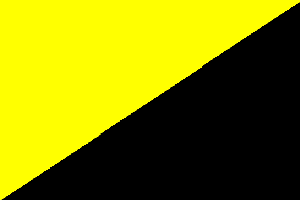 Market Anarchist Flag ("Black & Gold" Flag) 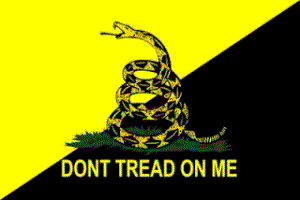 Anarcho-Capitalist Flag ("Rattlesnake" Flag) |
Anarcho-Capitalists/Market Anarchists (USA)
Anarcho-capitalism (also known as Free-Market Anarchism, Market Anarchism, Anarcho-Syndicalism, Private-Property Anarchism, and a host of other names) basically wants some sort of stateless society, where an economic system based on uncontrolled market interactions exist without regulation. Within these divergent groups there are a multitude of views on property and labor relations that differ significantly, and while many consider themselves simply anti-capitalists and oppose private ownership of the means of production, others stress the necessity of protecting private property, describing this as an integral component of individual rights and a free market economy. In short, there seems to be little agreement among the groups about what happens when government ceases to exist, nor the means of accomplishing it.
In the United States combining the Market Anarchist Flag with the Gadsden Flag favored by the Tea Party seems to have caught on, although no connection between the two groups is apparent, and many variant designs exist. The Market Anarchist flag is also known as the "Black & Gold" or "Black & Yellow" flag, with the black representing Anarchy and the yellow/gold representing physical gold itself. |
||||||||||||||||||||||||||||||
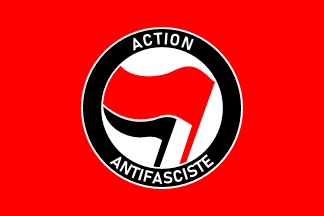 Antifas Flag 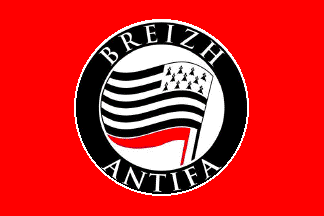 Breizh Antifa Flag |
Anti-Fascist Action (France) Action antifasciste The Anti-Fascist Action (Action antifasciste), founded in 2008, is a network of French autonomous (extreme-leftist) antifascist groups. These groups and their members are known as antifas. The French antifas are "affiliated" to an informal group of similar movements that emerged all over Europe (Denmark, Netherlands, Sweden, Czech Republic, Slovakia, and Spain) in the 1990s. They are based on the German Communist Antifaschistiche Aktion movement of the 1930s which was crushed by the Nazis after they got into power in 1933. Their main goal is to get rid extreme-rightist and neo-Nazi movements, stopping at nothing, including street violence and illegal acts. The flag of Action antifasciste is red with the movement's logo, a red and a black flag placed on a white disk surrounded by a black ring charged with the name of the organization, written in white letters. The emblem is a modernisation of the emblem used by the German Antifaschstische Aktion in the 1930s, originally with two red flags and a red ring. The black color was added by the modern antifa movements, symbolizing the union of Communists and anarchists against fascists. Most European antifa movements use a same emblem and flag, with appropriate indentifying text. The flag of the Breton branch of Action Antifasciste is a good example of this. Notice the upper, red flag has been replaced by a Breton flag and the ring around the emblem is inscribed with the name of the group Breizh Antifa. |
||||||||||||||||||||||||||||||
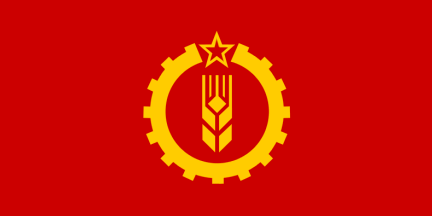 APL Flag "The Grain and Gear" |
American Party of Labor (USA)
The American Party of Labor (APL) is a Communist organization started in the United States in 2007. The party platform was established at the new Party’s First General Congress on December 6, 2008, held in Milwaukee, Wisconsin. Although the party claims membership across the United States, the largest party activity seems to be in the Atlanta and Milwaukee areas. The current APL General Secretary is Alexander I. Serpov. Although the APL has not been linked with any violent activities, the party draws its inspiration from the teachings of Marx, Engels, Lenin, Stalin and Hoxha and calls for a workers' revolution to end national control of the rich "ruling class." APL activities include a webpage, a newspaper called "The Red Phoenix," and the Red Star Library where they maintain a collection of Marxist-Leninist texts assembled or published by the APL to promote their version of Marxist-Leninist history and theory. The APL version of "Marxism-Leninism" seems to be closer to that of "Stalinism" and the "Hoxhaism" of Enver Hoxha of Albania. The APL party calls its red flag "The Grain and Gear" because an ear of grain and a incomplete gear wheel are combined with the star of Communism into their emblem. |
||||||||||||||||||||||||||||||
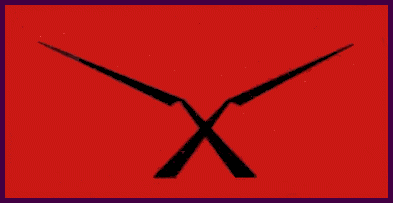 ARNE Flag |
Ecuadorian Nationalist Revolutionary Action (Ecuador) Acción Revolucionaria Nacionalista Ecuatoriana The Acción Revolucionaria Nacionalista Ecuatoriana (ARNE) was a political movement founded in 1942; it was organized and militant, strongly doctrinaire; very unlike other movements and Ecuadorian political parties of the period who lacked a proper structure. In 1942, a group of students founded the "Companies Functional National Revolutionary Offensive" (CONDOR). This organization soon became the ARNE political movement, which supported revolutionary nationalism - Falange, fascism, etc. It was led by George Moon Yépes and under his leadership developed very rapidly among young Catholics and the industrial sectors. ARNE is regarded as one of the three major political forces of Ecuador in the second half of the 20th century. However in 1979, with the fall of the dictators, ARNE was denied legal recognition, and although somewhat active during the early 80s it never again was a political force of any importance. |
||||||||||||||||||||||||||||||
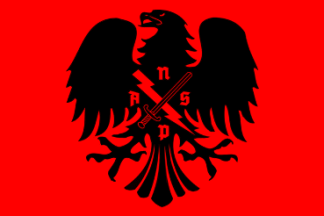 ANSP Flag |
American National Socialist Party (USA)
In this country, the neo-Nazis keep splitting up and forming new factions. The American National Socialist Party (ANSP) is one such splinter group. Their motto is "Raising up from the ashes, rebuilding the white race, one person at a time." They maintain several similar websites including "the one and only true Aryan Nations," and another for a youth group called "The Werewolf Youth Legion." They are headquartered in Chillicothe, Ohio. The ANSP flag is slightly reminiscent of the flag of the short-lived West German Socialist Reich Party of Germany of the early 1950s. It has a red field with a fearsome-looking black eagle centered on it. The eagle is defaced with a crossed sword and lightning bolt providing a frame for the red letters ANSP. |
||||||||||||||||||||||||||||||
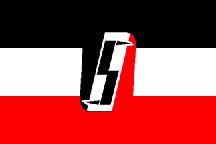 ANS-NA Flag 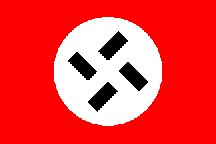 ANS-NA Flag Variant |
Action Front Nationalist/National Activists (Germany) Aktionsfront Nationaler Sozialisten/Nationale Aktivisten The Aktionsfront Nationaler Sozialisten/Nationale Aktivisten (ANS-NA) was a very active and violent German neo-Nazi organization. They were originally founded in 1977 by Michael Kühnen under the name of the "Action Front of National Socialists" (ANS). By 1979, their violent policies resulted in most of their leaders being arrested and jailed. In 1983, they merged with the Nationale Aktivisten (National Activists), an organization led by Thomas Brehl, and combined the names to form the Action Front of National Socialists/National Activists, or ANS/NA. The ANS/NA was in turn banned in 1983. At the time it had about 240 members. The group used two different flags. One had a black-white-red horizontal triband with a rune-like "S" in the center; the other was a variant of the National Socialist flag called the "reverse swastika." It is the red flag with the white disk, in which a hidden white swastika appears in parts with black accents in the background, shown to the left. Squint your eyes and you'll begin to make out the hidden white swastika. |
||||||||||||||||||||||||||||||
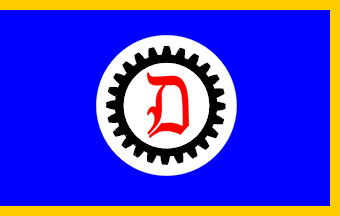 AV (New Jersey Bund) Flag 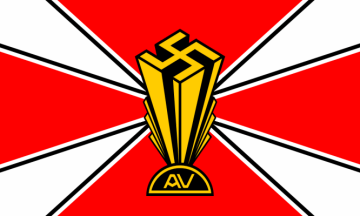 AV (New York City Bund) Flag  AV Youth Unit Flag (assumed to be a unit flag) 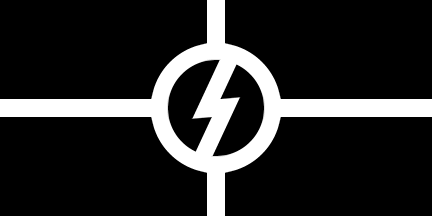 AV Youth House Banner (assumed to be the general Flag) |
German American Bund 1936-1941 (USA) Amerikadeutscher Volksbund (AV) The German American Bund (AV), or "German American Federation," was a pre-World War II American Nazi organization active in New York between 1936-1939, whose roots can be found in the earlier Teutonia Club (1924-1933) and in the FDND ("Friends of New Germany" - Freunde Des Neue Deutschland) movement between 1933-1936. An internal power struggle fought for control over the Friends in 1934 resulted in Heinz Spanknöbel, Alter Kämpfer, and Fritz Julius Kuhn starting the new German American Bund in Buffalo, New York. The Bund established training camps in New Jersey, New York, and Wisconsin. Fritz Julius Kuhn was named Bund Leader (Bundesfûhrer), and under his leadership the Bund held rallies complete with Nazi insignia, emblems and rituals. They vocally attacked and held demonstrations against Jews, Communist, trade unions and the Roosevelt administration. In the process they claimed their main goal was to promote a favorable view of Nazi Germany. However, the Bund received no financial or verbal support from Germany, and in 1938, the Nazi government actually declared that no Nazi emblems could be used by the organization. This was done to distance Germany from the Bund which had become an embarrassment to the then current German government policies with some of its rhetoric and actions. Naturally, the AV's public activities pretty well ended with the declaration of war against Nazi Germany in December of 1941. The first two Bund flags shown here were seen at German-American Bund activities in New Jersey and in New York City. The second flag seems to have been modeled after German military flags. Naturally, there were also large displays of both the Stars and Stripes and the NSDAP Swastika flag displayed at AV events. The activities of the German-American Bund included several Bund Youth Groups, or DJ (Jugendschaft), who had (assumed) unit flags on black fields mirroring the German Youth Troop flags (Fahnleinfahne). These unit flags were of simple design and consisted of a single runic "S" thunderbolt on a black background. (The assumption they were unit colors is based on the fact that this flag many times had unit numbers inscribed in red in the canton) The second type of Bund Youth Group flag consisted of a white runic "S" thunderbolt centered on the black field, surrounded by a white circle which was centered on a white cross. This elongated banner seemed to have served the purpose of a general Bund Jugendschaft, or house flag, since no unit designations were present. |
||||||||||||||||||||||||||||||
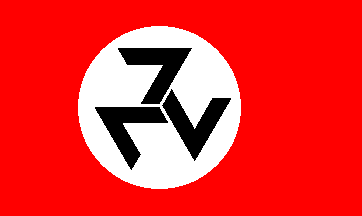 AWB Flag - Type #1 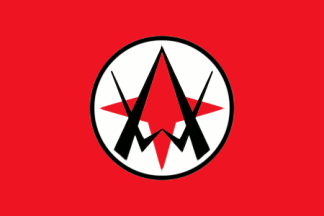 AWB Flag - Type #2 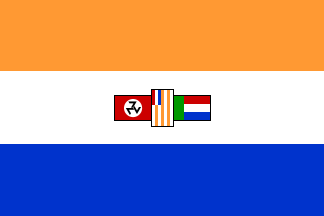 AWB Flag - Type #3 - Front 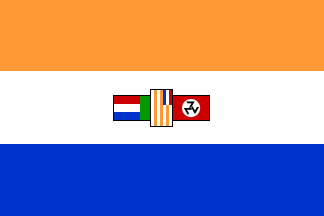 AWB Flag - Type #3 - Back 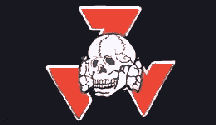 Modern Afrikaner Resistance Aryan Guard - Blood and Iron (Calgary, Canada) |
Afrikaner Resistance Movement (South Africa) Afrikaner Weerstandsbeweging Essentially a variation on the swastika, and popular for that reason, the triskele was a symbol occasionally used by the Nazi regime, most notably as the insignia for a Waffen SS division composed of Belgian volunteers. After World War II, the "Three Sevens" version of the triskele was popularized by white supremacists in Europe and South Africa. The symbol is also used as part of the logo of the international racist skinhead group, "Blood & Honour." The Afrikaner Weerstandsbeweging (Afrikaner Resistance Movement) or AWB, is a far right political organization and former paramilitary group in South Africa under the leadership of Eugène Terre'Blanche. The AWB claims that the three sevens symbolized supremacy over the devil. They are committed to the restoration of an independent Boere-Afrikaner republic or "Boerestaat" within South Africa. In their heyday they received much publicity both in South Africa and abroad as an extremist white supremacist group. The AWB Flag (Type #2) was introduced in 1979, but was withdrawn from official use after a short time in favor of already well-established flag with three 7's. The star was said to have represented the Star of Bethlehem, and the Christianity in general. The flag with three 7's (Type #1) was the original flag of the movement; although it was replaced with the flag charged with the stars and letters AW in 1979, it was reintroduced in same year and used ever since. The flag was designed by Jan Groenewald, one of the founders of the movement, and slightly modified by Dries Albert, who was in charge of the movement's propaganda. According to Groenewald himself, the inspiration for the design did come from the Nazi flag, however, the three digits were always described as a Christian symbol, the number 777 having been described as the biblical symbol of perfection and of God himself, as opposed to the number 666 which symbolizes the Antichrist. According to Groenewald, the color red on the flag stood for blood, white stood for the purity of the White race, and black stood for bravery. The previous national flag of the South Africa was not much used by the AWB, having been generally considered the symbol of subjugation of Boer independence by the British Empire, so the flags of Boer republics were usually used instead. A flag derived from the national flag was used sometimes, on which the Union Jack was replaced with the AWB flag. The reverse of this flag was not identical to the front because three 7's were not mirrored, although the position of the whole AWB flag was (flags of the Boer republics were mirrored completely). Modern White Supremacist supporters still occasionally fly a flag with a Nazi-like death head skull centered over the "Three Sevens" symbol. Its most recent appearance is in Canada, where it is being used the neo-Nazi group "Blood and Iron," a successor group to the Aryan Guard, under the leadership of Kyle McKee, who has been called the "micro-furhrer of Calgary" by the police. |
||||||||||||||||||||||||||||||
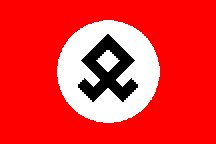 ASF Flag 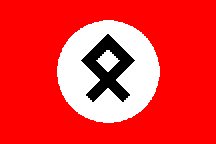 ASF Flag (variant) |
Afrikaner Student Federation (South Africa) Afrikaner Studentebond The odal rune is used by the South African African Student Federation. It is the last letter of futhark, the "modern" 16 letter viking rune set. It was originally used by ethnic Germans (Volksdeutsche) from the Yugoslavia SS-regiment (The 7. SS Freiwillingen-Gebirgs — Division Prinz Eugen) operating during World War II in the Nazi Germany sponsored State of Croatia. Today the odal rune is widely used by right-wing nationalist youth groups like the Wiking Jugend in Germany and other counties. It was banned in Germany in 1994. The flag used by the Wiking Jugend was black with a red odal rune in its center. The odal Rune is sometimes referred to as "Odin's Rune." It is a symbol of a Pagan Religion called Odinism. Neither the religion nor the symbol is racist, but both have been co-opted by certain sectors of the Far Right. |
||||||||||||||||||||||||||||||
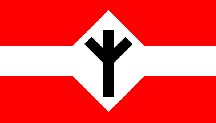 AHF Flag 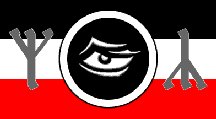 DHF Flag |
All-Germanic Heathens Front & German Heathens Front (Germany) Allgermanische Heidnische (AHF) & Deutsche Heidnische Front (DHF) The Allgermanische Heidnische Front (AHF) was a far right militant Neopagan international organization espousing a philosophy influenced by Ásatrú (Odinism). Notice the strong resemblance of their flag to the flag of the Hitler Jugend, with the alghiz rune replacing the swastika. The AHF was founded and initially led by Norwegian black metal musician and heathen Varg Vikernes, who founded the Norsk Hedensk Front (Norwegian Heathen Front), which soon evolved into the AHF. (Varg Vikernes later ceased to be involved with the organization) The group seeked to restore ancient Germanic religion of Odinism and was strongly anti-Semitic. In 2001, the AHF claimed chapters in Norway, Sweden, Denmark, the Netherlands, Germany, the USA, Canada, Russia, and Flanders, but since 2006, the Allgermanische Heidnische Front is apparently defunct. The German chapter, Deutsche Heidnische Front (DHF), was founded in 1998 by avowed neo-Nazi Hendrik Möbus. The group publishes a magazine "Tuisto," which deals with pagan, cultural and historical themes. Their flag's central image is the Eye of Wotan (Odin), and like the AHF flag, also uses the algiz rune, in this case both upright and reversed. |
||||||||||||||||||||||||||||||
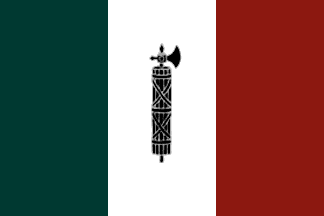 AFM Flag 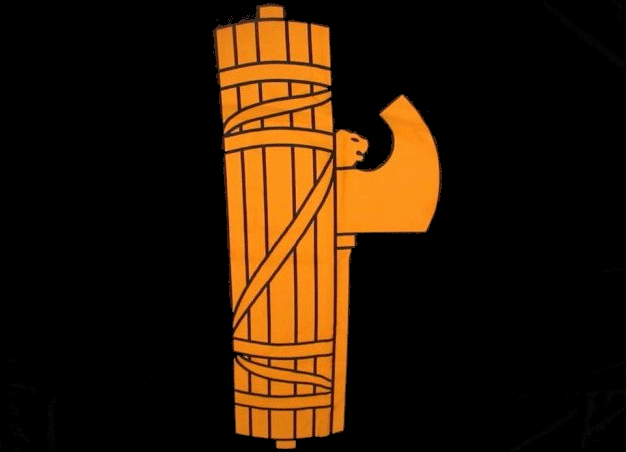 AFM Flag 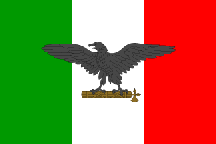 Italian Social Republic Flag 1944-45 |
American Fascist Movement Flags (USA)
Lawrence Dennis, an American diplomat and author, advocated fascism and talked of founding the "American Fascist Party" in the years following the Great Depression, but the group never materialized. Dennis and others were later tried for sedition under the Smith Act in what became known as "The Great Sedition Trial of 1944." The case ended in a mistrial when the judge died of a heart-attack. The presence or absence of elements of fascism in the United States since World War II has been a matter of continuing dispute. Groups identified as neo-fascist in the United States generally include neo-Nazi organizations such as the National Alliance and the American Nazi Party. Some say the Fascist Movement is a secret group of Americans who want a strong military government to take control of the United States and put down the protesters, greeners, and ultra-liberals. Others say an American Fascist party doesn't actually exist and its name is used just as a marketing ploy to sell Fascist memorabilia. On their website, the current American Fascist Movement claims to be against racism and Nazism, materialism, globalism, capitalism and communism, and superficiality. They claim they are for meritocracy, timocracy, sacrifice, nationalism, cooperation (State Corporatism), and virtue. A large section of their website is dedicated to merchandising. It is also interesting to note, that at the American Fascist Movement's website store, three flags are offered for sale, including a modern replica of the "Italian Social Republic Flag (1944-45)," a modern variant of the "Italian National Fascist Party Flag (1922-1943)," and what appears to be an Italian national flag with the fasces superimposed in black on the white vertical stripe. |
||||||||||||||||||||||||||||||
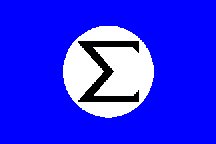 AIB Flag |
Brazilian Integralist Action (Brazil) Ação Integralista Brasileira (AIB) The Ação Integralista Brasileira (AIB), also called the "Green Shirts" after their uniform shirt color, was a fascist movement founded in 1932 by Plínio Salgado after the 1930 revolution that brought Getúlio Vargas to power. Vargas banned all parties in 1937 and foiled an Integralist plot to seize power by force during the 1938 elections by declaring a state of siege. The AIB was revived in the guise of the PRP, one of the legal parties permitted after World War II, which were in turn abolished when the armed forces seized power from the elected civilian government in 1964. Plinio Salgado was an admirer of Mussolini and Hitler. He tried to adapt some of the Nazi-Fascist elements into Integralism. The Green Shirts had a salute similar to the Nazi salute, but instead of the straight hand, they pointed the palm of the hand to the front and said "Anaue," meaning "You are my brother" in the native indian Tupi language. |
||||||||||||||||||||||||||||||
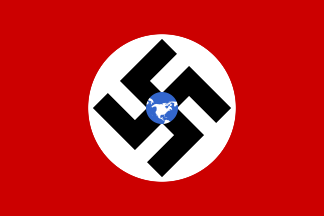 ANP Flag (original) 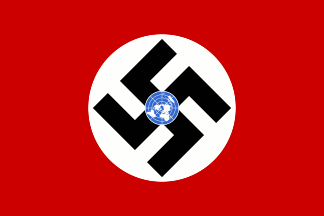 ANP Flag (variant globe) (also used by the new ANP) 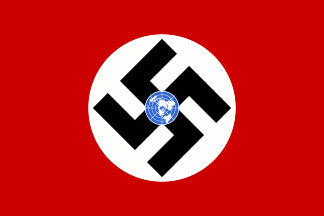 ANP Flag (variant globe) (rarely used) 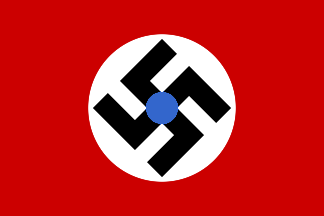 ANP Flag (blank globe variant) (frequently used) 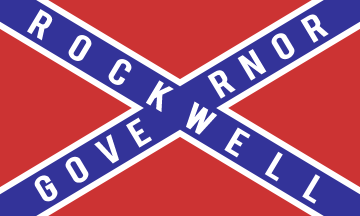 Rockwell's Campaign Flag 1965 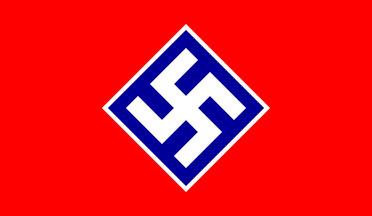 NSWPP Bicentennial Flag 1976 (ANP reorganized as NSWPP) 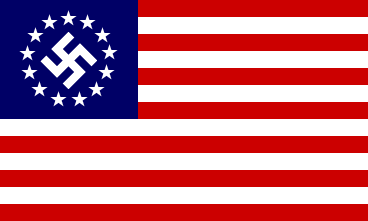 13-Stars and Stripes Flag (rarely seen or used) |
American Nazi Party (USA)
The American Nazi Party, founded by George Lincoln Rockwell in 1959 and led by him until his death, had a flag like that of Nazi Germany with a small blue globe in the center of the swastika, representing the world being consumed by the swastika. The depiction of the globe on party flag and emblem varied: sometimes it was showing only the North America and some of neighboring regions, but it was sometimes also showing all continents, together with the meridians and parallels as in the current United Nations flag, and there were few of its depictions as in the original United Nations flag. On many occasions, the globe was simplified to a blank solid blue circle, as can be seen in some early color photographs. Rockwell initially called his party the "World Union of Free Enterprise National Socialists" (WUFENS), but later renamed it the American Nazi Party in 1960 to attract maximum media attention. The party, headquartered in Arlington, Virginia, largely based its platform upon the ideals and policies of Adolf Hitler's NSDAP, but added a policy of Holocaust denial, and expressed allegiance to the Constitutional principles of the American Founding Fathers.
In a "Keep the Redskins White!" demonstration members of the American Nazi Party demonstrated against desegregating the Washington Redskins football team in October of 1961. At the time the Washington DC pro-football team was the last remaining all-white team in the league, and although desegregated today, it remains the only team in the NFL whose name is considered a racial slur. In 1965, Rockwell ran for the governor of Virginia, finishing last among the four candidates. Although the ANP had already existed for six years, he ran as an independent candidate, probably in order to make himself more acceptable to the voters, and used a flag in his campaign which was derived from the Confederate flag by replacing the stars with the words ROCKWELL GOVERNOR in white. The flag was actually made from a real Confederate flag on which the stars were painted into blue before the letters were added. In 1967, Rockwell was killed by John Patler, a former party member whom Rockwell had ejected from the party for allegedly trying to introduce Marxist doctrine into the party's platforms. The ANP name was changed to the National Socialist White People's Party (NSWPP) in 1967 shortly before Rockwell's assassination. The so-called Bicentennial Flag of the National Socialist White Peoples Party was first seen in a demonstration in 1976 on the Fourth of July outside the White house. The NSWPP party claimed the flag celebrated America's Bicentennial and had nothing to do with any bicentennial of the National Socialist Movement which, of course, began in 1919. The red-white-blue Bicentennial flag was designed by Matt Koehl, the current leader of both the New Order and the World Union of National Socialists (WUNS). Koehl has a long history of being in leadership positions in various extremist groups, including the National Renaissance Party (NRP), the United White Party (UWP), the National States' Rights Party (NSRP), and the American Nazi Party (ANP). In August 1967, Koehl succeeded the George Lincoln Rockwell as "Commander" of the National Socialist White People's Party (NSWPP), and renamed it the "New Order" in 1983. By then, several splits resulted in formation of new neo-Nazi groups, mostly due to Koehl's policies, based on his vision of Nazism as a religious movement rather than a political one. Since mid-1980s, the New Order has been headquartered in New Berlin, Wisconsin, preaching Nazism as a pseudo-religion, without any public political activities. Today, the name "American Nazi Party" has been adopted by an organization led by Rocky J. Suhayda, a former member of Rockwell's original party in 1960s, and headquartered in Westland, Michigan. Rocky Suhayda was later affiliated with a group in Detroit called the SS Action Group led By Ted Dunn in the 1980s. Dunn ran a kind of a soup kitchen operation feeding those who "fought" under his leadership. The new group claims George Lincoln Rockwell as their founder, but there seems no actual connection to the original ANP, apart from the fact that their website sells nostalgic reprints of Rockwell's 1960s-era magazine "The Stormtrooper" and replica flags of the original party. The new American Nazi Party uses a version of the original ANP Flag (shown top left, with blue UN-style globe) on their website and a vertical banner (shown left) at their rallies. However, a few years ago, they sold flags of various countries and states with a swastika superimposed on their designs, including the 13-star United States flag shown on the left. |
||||||||||||||||||||||||||||||
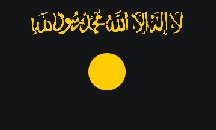 al-Qaeda Flag 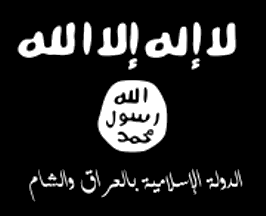 Syria-Iraq al-Qaida Flag (ISIS) |
al-Qaeda "The Base" (Saudi Arabia) al-Qaeda This flag sometimes has been used by cells of the extremist Arab terrorist organization al-Qaeda, who have been responsible for many senseless bombings and deaths. It is black with the "long version" of the Shahada in a yellowish color and a yellowish circle in the center. A variant has the lettering and circle in white. The flag is never flown, but usually hung on a wall. This flag was used in the background of several beheading videos. In the videos it is not clear enough to tell whether the lettering and circle is white or yellow, but it probably differs depending on who made the particular flag. The flags are not machine-produced, but hand-made, usually from two pieces of black nylon with embroidered lettering and circle. The second flag shown here is an example of an al-Qaeda flag that is seen in many parts of the Middle East, with variants displaying differing Arabic text. Normally the text on the top reads "There is no god but God." The white circle appearing in the center with inscription Muhammad Rasul Allah is the seal of Messenger of God which he used on his letters. The text on the bottom of this example reads: "The Islamic State of Iraq and Ash-Sham." The Islamic State of Iraq and the Levant (ad-Dawla al-Islamiyya fi al-'Iraq wa-sh-Sham) abbreviated as ISIS and ISIL (Da'ash), was established as an umbrella organization of Iraqi insurgent groups in 2006 by al-Qaida supporters and members. The symbolism (in particular in the black flag and so-called seal of Muhammad) are modern-era inventions of jihadists that have neither historical basis nor islamic tradition truly supporting them. |
||||||||||||||||||||||||||||||
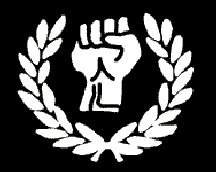 The Aryan Fist |
Aryan Fist (USA)
The Aryan Fist symbol is a twist on the fist representing the Black power movement and the battle against racial oppression. White Power (U.S. Nazi Skins) uses a logo consisting of a white fist upwards on a black field. The Aryan fist is a symbol of white power used by hate groups who promote their racist agenda as white pride activism. The laurel wreath appearing in the "Aryan fist" Flag is actually not a racist symbol itself, but rather a separate common skinhead symbol stemming from the logo of a line of British clothing that became popular among skinheads. It is the white fist itself that is the symbol of intolerance. |
||||||||||||||||||||||||||||||
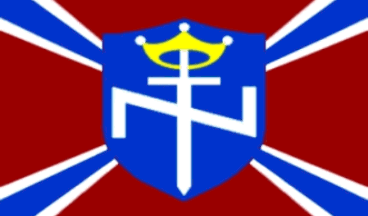 AN Flag (oblong variant) 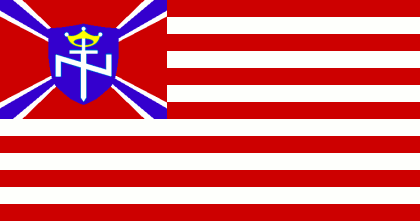 AN Flag (13-striped variant) 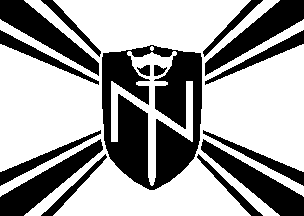 AN Flag (black and white variant) 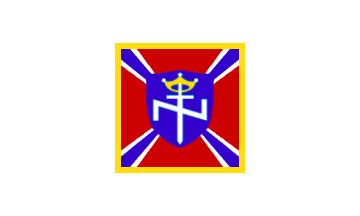 AN Flag (white flag with "The Shield" logo) 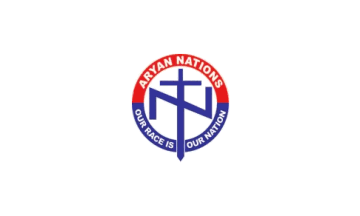 AN Flag (white flag with newer alternate logo) |
Aryan Nations (USA)
Aryan Nations (AN) is a white nationalist neo-Nazi organization founded in the 1974 by Richard Girnt Butler as the political arm of the Church of Jesus Christ-Christian (CJCC). As of December 2007 there were two main factions that claimed descent from Butler's group. Aryan Nations was called a "terrorist threat" by the FBI, and the RAND Corporation called it the "first truly nationwide terrorist network." The organization has been at the center of violent racist activity since its inception in 1974. During the 1980s and early 1990s, neo-Nazis, racist skinheads, Klansmen and other white nationalists convened regularly at the Aryan Nations’s Idaho compound for its annual "World Congress." However, during the early 2000s the group lost a very costly civil lawsuit against the Southern Poverty Law Center that depleted the AN´s finances, and a slow decline followed that cumulated with the 2004 death of their founder Richard Butler. Today Aryan Nations has splintered into several smaller groups with various people in competition for the leadership of the movement.
The AN flag has appeared in both a square and rectangular shape, and is sometimes displayed with a gold fringe when used indoors. The square variant is called the Aryan Nations "Shield" and was carried in demonstrations in the form of a vertical banner. The AN also used a stripped version of the AN flag, as well as re-purposing for their demonstrations the more traditional Confederate Naval Ensign, the Christian Church Flag, and various versions of the Confederate Stars and Bars. The Aryan Nations also uses several white fielded flags: the first charged with "The Shield" and the second charged with an alternate emblem (sword over the letter N, both in blue, surrounded with a bicolor ring, top half of which is red and charged with the inscription ARYAN NATIONS, and bottom half is blue and charged with the inscription OUR RACE IS OUR NATION; the tip of the sword is set over the bottom of the ring, dividing it into two).
The Werewolf Youth Legion (CJCC/AN-WYL) is the Aryan Nations Youth division whose purpose is to attract and sell to American youths the doctrines of their versions of National Socialism and White Supremacy. |
||||||||||||||||||||||||||||||
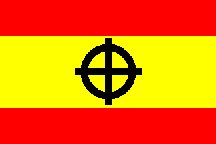 BBAA Flag (Type 1) 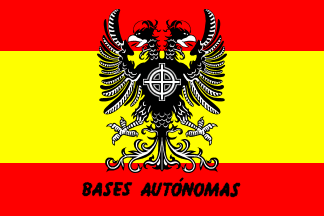 BBAA Flag (Type 2) 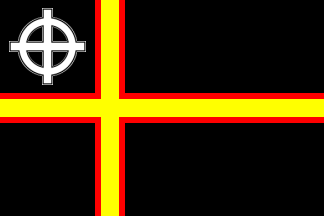 BBAA Flag (Type 3) This group was very active hanging a wide variety of hate posters in the streets of cities like Madrid and Sevilla in the early 1990s |
Autonomous Bases (Spain) Bases Autónomas (BBAA) The Spanish red-yellow-red flag defaced with a Celtic Cross (Sun Wheel) and/or a Carlist-like double eagle are flags of Bases Autónomas (BBAA), a loose almost defunct neo-Nazi organization. Although the BBAA disbanded, some sleeper cells are rumored to still exist in several cities, especially Madrid and Burgos. Most of the militant leaders of this neo-Nazi, anarchist, violent and clandestine organization now conduct their militant activities from within other groups, such as Resistance, the DN, NuevOrden, Falangists and the Revolutionary Nationalist Coordinator. Some BBAA-like Spanish cell organizations still exist, such as Hermandad Nacionalsocialista Armagedón (Armageddon National Socialist Brotherhood), which is active in the Valencia area and split from Acción Radical in 1998. The Armageddon Brotherhood has claimed responsibility for Molotov cocktail attacks against branches of the Popular, Socialist and Izquierda Unida parties in some towns near Valencia.
Other variant flags reported as being used by the Bases Autónomas
Other rumors about the Bases Autónomas still circulate, such as ex-members of this defunct Spanish hate organization still allegedly having links to other fascist groups still operating in Italy. These various variants of their flags are still manufactured for ignorant tourists who still buy them as historical Spanish flags in souvenir shops throughout Spain. |
||||||||||||||||||||||||||||||
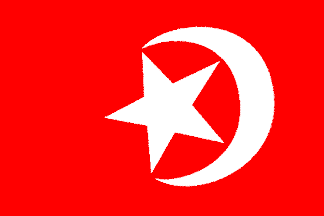 Black Muslim Flag |
Black Muslim Movement Flag (USA)
Today, the Black Moslems are known as the "Nation of Islam" and are directed by Reverend Louis Farrakhan. They are not the militant organization of the past. In the early 60s, the Black Muslims were very active and violent extremist. In fact, Middle East Muslims rejected the American Black Muslim version of Islam, which was pretty much just a hate the white man movement. Malcolm X, perhaps their most well-known leader, eventually abandoned many of these violent ideas and converted to true Sunni Islam. Because of this, he was gunned down in a mosque by two black men wielding shotguns. Today, they describe their flag as "the symbol of unity of all Muslims throughout the World." It basically is a mirrored version of the Turkish national flag with an enlarged crescent and star. The star is oriented with two points inside the crescent. The symbols of the sun, moon, and the stars, represent the universe. The flag differs slightly from their logo which has the individual letters "F, J, E, and I" placed in the four corners. They are said to stand for Freedom, Justice and Equality, and Islam. |
||||||||||||||||||||||||||||||
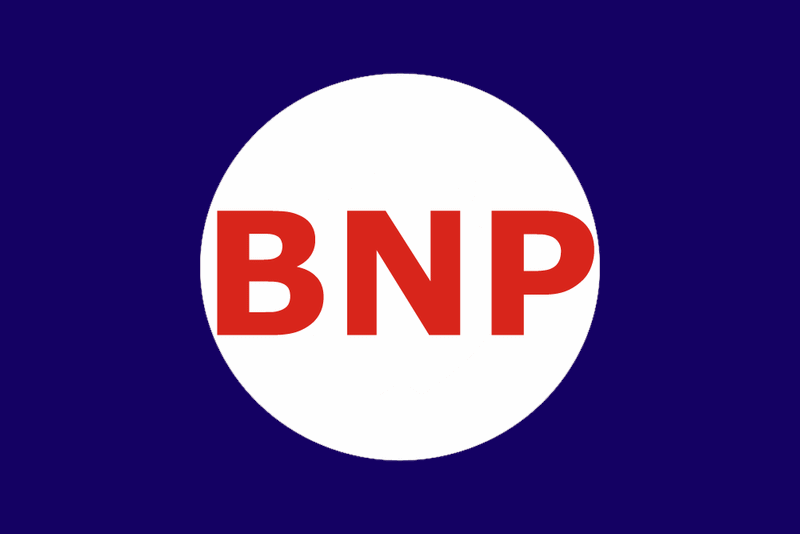 BNP Flag 1982 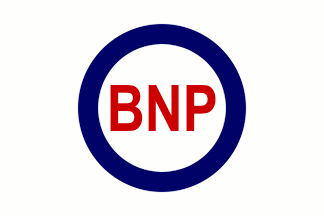 BNP Flag 1999 |
British National Party (Great Britain)
The British National Party is a far-right political party founded by John Tyndall in 1982 by merging several similar fascist parties including the old National Front. The BNP identified with Nazism with its activities, associations and publications, and its active denial of the Holocaust. Tyndall exclaimed "Mein Kampf is my bible." In 1999, Nick Griffin became the new leader of the BNP party and continued its policies of right-wing populism, white nationalism, and calling for "ethnic cleansing." Although the BNP has described itself as British nationalist, racial nationalist and "ethno-nationalist." They still call for a "voluntary resettlement" of all immigrants and their descendants back to the countries of their origins, support all anti-immigration policies, demand a return of capital punishment, oppose all forms of gay and same-sex marriage, and what they call the "Islamification" of the UK. In recent years the party has also concentrated on opposing Islam and actively campaigns against the establishment of mosques, halal meat and what it calls the "Islamification" of the United Kingdom. The original BNP party flag had a white circle centered on a blue field, with the block letters "BNP" in red centered in the circle. After Nick Griffin took over the leadership of the party the flag was design was changed to a plain white field, less bold lettering in red with a blue circle drawn around it. |
||||||||||||||||||||||||||||||
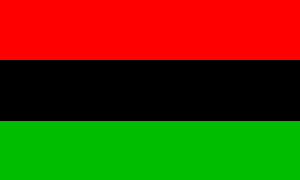 Afro-American Flag 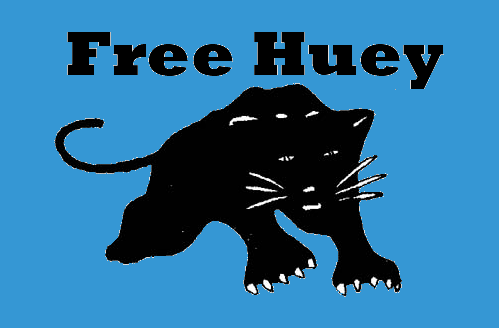 The "Free Huey" Flag 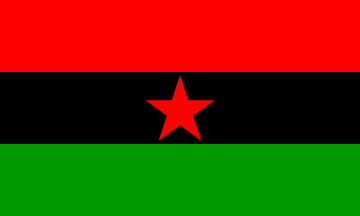 Afro-American Variant |
Black Panther Party (USA)
The Black Panther Party, originally known as the Black Panther Party for Self-Defense, was an African-American revolutionary leftist organization founded in Oakland, California, by Huey Newton and Bobby Seale in 1966. The Black Panther Party achieved national and international notoriety through its involvement in the Black Power movement and in U.S. politics of the 1960s and 70s. The organization initially claimed to be protecting the African American neighborhoods from police brutality, but the leaders soon claimed to be followed socialist and Maoist communist doctrines. It was active in the United States from 1966 until 1982. 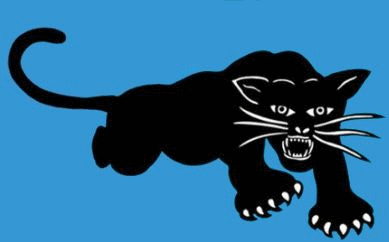 George Jackson Funeral Flag 1971 Although the Black Panthers were not noted for showing flags at their many rallies and demonstrations, the flag that is most associated with them was the Afro-American Flag. Another flag featured a springing black panther (the Party Logo) under the words "Free Huey" used at demonstrations against his imprisonment. There were variants of this flag with differing fonts and panther designs, including one with simply the words and no logo at all. A plain white flag with just the springing Black Panther logo centered on it was used at George Jackson's Funeral in Oakland (shot to death by prison guards in San Quentin Prison during an escape attempt) in 1971. Sometimes the Black Panthers put their emblem on flags of yellow or light blue. The yellow was the same as used on the Gadsen Flag, which in the Sixties and Seventies was used by radicals at the opposite end of the spectrum from the Tea Party. The light blue was the same as used on the VC flag. The last variant shown at the left is an Afro-American Flag with the addition of a red star on the black strip that was reportability first seen in Oakland, California, in 1989 at the funeral of Huey Newton. Also see Black Liberation Flag 1920 on Modern American Protest and Message Flags page. |
||||||||||||||||||||||||||||||
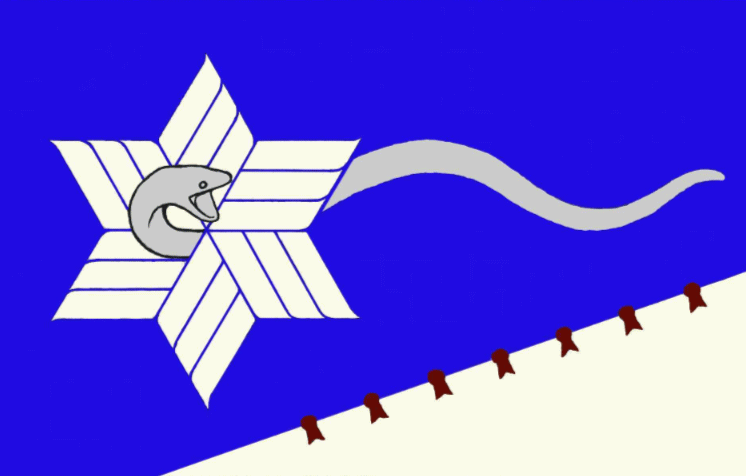 The Branch Flag |
The Branch Davidians (USA)
This is the flag flown at the Mt. Carmel Branch Davidian Compound during the infamous Waco Siege in 1993. The Branch Davidians, or simply "The Branch," were an extremist religious group that split from the Seventh-Day Adventist Church in 1930s. The Davidians believed themselves to be living in the time of the Biblical Final Judgment and Christ's Second Coming. The group and its members were "excommunicated" by the Adventist Church after the split. The Mt. Carmel Branch flag featured a stylized six-winged fiery serpent flying over the white earth below with the "Seven Seals" of Biblical prophecy lined up on the horizon in position to trigger the Apocalypse. They gained national notoriety for their violent 51 day stand during the "Waco Siege of 1993." During the seige, the FBI, ATF agents, and the Texas National Guard lay siege on the Mount Carmel Center near Waco, Texas, resulting in the deaths of their leader, David Koresh, and 82 of his followers, plus four Bureau of Alcohol, Tobacco, and Firearms (ATF) agents. |
||||||||||||||||||||||||||||||
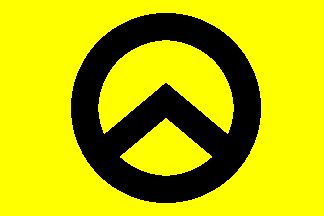 BI Flag (yellow) 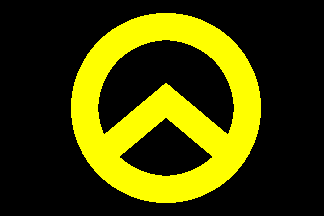 BI Flag (black) 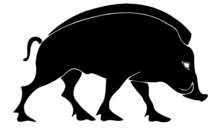 Current BI Logo |
The Identity Block (France) Bloc Identitaire The Bloc Identitaire is an extreme right French nationalist political group. It was founded in 2003 by former members of Unité Radicale and several other nationalist groups. The Bloc Identitaire claims to represent all "young French and Europeans who are proud of their roots and of their heritage." It opposes what it calls "miscegenation" and "imperialism" (both American and Moslem), and has organized campaigns and demonstrations, sometimes violent, against Moslems, Jews, Communists, and other non-white ethnic and political groups. The Bloc identitaire runs the Nationalist Press Agency and website called Novopress, and identifies itself with other neo-Nazi and extremist groups in other parts of Western Europe and North America. One of their more imaginative, and less violent, activities was the use of soups with pork as "identity soups" (soupes identitaires) to attack and belittle certain ethnic groups. The group has been banded as "discriminatory and xenophobic" by HALDE (High Authority for the Struggle Against Discrimination and for Equality - Haute autorité de lutte contre les discriminations et pour l'égalité) a French "independent administrative authority" which "has the right to judge all discrimination, direct or indirect, that is prohibited by law or an international agreement to which France is a signatory."
The flag most commonly attributed to the Bloc Identitaire has either a yellow or black field, with the symbol of the lambda Spartan centered on it in contrasting black or yellow. A number of these flags were used by the BI at the "Pigs' March," organized on May 14, 2011, in Lyon. The BI, like many extremist groups, is perfectly willing to "hijack" traditional flags and symbols for their use. The traditional flags of Languedoc and Roussillon Provinces would be perfect examples of this "borrowing to legitimize" by the Bloc Identitaire, who have displayed these flags during their demonstrations and parades. The newest BI Party symbol/logo is the black boar, but has yet failed to materialize on any flag. |
||||||||||||||||||||||||||||||
 BR Flag |
Red Brigades (Italy) Brigate Rosse The Red Brigades was an Italian Marxist-Leninist terrorist organization that was behind numerous violent incidents, assassinations, acts of sabotage, bank robberies, and kidnappings. The Red Brigades attained notoriety in the 1970s and early 1980s with these violent attempts to destabilize Italy. First formed in 1967, this violent left wing extremist organization sought to create a "revolutionary" state through armed struggle, and to force Italy to leave the North Atlantic Treaty Organization. In the late 1980s, the group was broken up by mass arrests and then slowly faded into insignificance as the leadership turned on each other. |
||||||||||||||||||||||||||||||
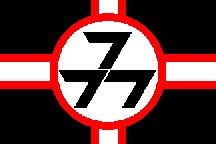 BWB Flag (under von Maltitz) 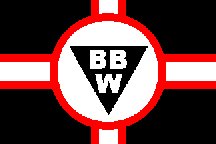 BWB Flag (under Ford) 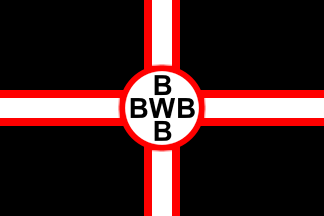 BWB Flag (current variant) |
Boer Resistance Movement (South Africa) Boere Weerstandsbeweging (BWB) This was the flag of Boere Weerstandsbeweging (BWB) which was black with white cross fimbrated red; in the center of the cross is a white circle fimbrated red with three black "7"s. The BWB was initially led by Eddie von Maltitz and subsequently by Andrew Ford. This flag and its symbol are now also being used by European Nazis as they have volunteered to fight in a race war in South Africa. When Andrew Ford took over the leadership the flag was replaced by a similar one instead of having the three 7s, bears the letters BWB in white arranged in a triangular fashion (pointing downwards) on a similarly directed black triangle. The group appeared either to have gone underground or had ceased to exist, because their public activities were curtailed after 1999, but a new website has appeared in 2012. Until the appearence of this new website, their last public activity as the Boer Resistance Movement was when they offered to send a force of 35 volunteer soldiers to Yugoslavia in 1999 to help defend Serbia against "NATO aggression." It is unknown if anything ever came of this offer. Their current BWB flag, which is featured on their website, has a cross composed of five black letters, four B's and one W, arranged on the white disc so as to give the abbreviation BWB both horizontally and vertically. The white cross is described as the symbol of faith and purity, its red borders as the symbol of both the blood Christ shed on the cross and the blood Boer people shed in struggle for freedom, and the black field as the symbol of courage and determination of Boer people. How viable this new rebirth of the BWB is cannot yet be determined, but the website seems to be a serious recruitment effort. On their website they state they hope to bring the Boer nation together, and point to the current South African government as "a sadistic and racist regime" that must be stopped, stating their main goal is to free the three Boer republics (Transvaal, North Natal, Free State) from the "Afrikaner betrayal." |
||||||||||||||||||||||||||||||
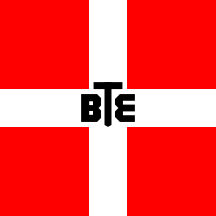 BTE Flag 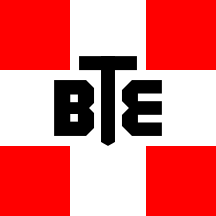 Closeup of Initials |
League of True Confederates (Switzerland) Bund treuer Eidgenossen (BTE) The full name of this Swiss extremist party was Bund treuer Eidgenossen nationalsozialistischer Weltanschauung, which translates loosely into the "League of True Confederates of the National Socialist Ideology." The party was founded in March of 1938 by former members of the Swiss National Front, who thought that their old party was no longer truly following the Nazi ideology. It was led by Alfred Zander, who in September of 1938 attended the Nuremberg Rally (the annual convention of the Nazi party) and spoke in favor of the idea that Switzerland should join the Reich. In May of 1938, Bruno Oswald in Berne founded a local chapter with about 25 members, while the "national" membership of BTE would eventually reach about 175 members. In July of 1939 Zander was arrested on his return from Germany and sentenced to jail, together with other BTE leaders and party members. In October of 1940 the party was disbanded and most of its remaining members joined the National Movement of Switzerland (Nationale Bewegung der Schweiz), another similar group which intended to become a unified Swiss Nazi party. The Swiss Government banned the group the following month. Their flag was derived from that of the National Front, adding the initials BTE to the center of the cross, thus employing the full color set of colors used on the German NSDAP flag. |
||||||||||||||||||||||||||||||
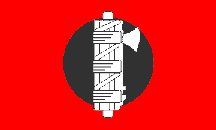 BUF Flag 1932 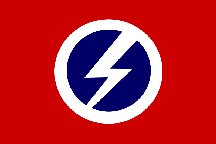 BUFNS Flag 1935 |
British Union of Fascists 1932-1940 (United Kingdom)
The British Union of Fascists (BUF) was founded in 1932 by Sir Oswald Mosley, a former Labor government minister and former MP of the Conservative Party. BUF's emblem was the one used by Italian fascists and by other fascist movements, the fasces. In the British flag the fasces was white placed over a gray disk on a red field. In 1935, the party changed its name to the British Union of Fascists and National Socialists (BUFNS). Along with this name change appeared a new flag with the lightning flash emblem and the flag colors of the United Kingdom. The flash was white, set on a blue disk edged in white, appeared in the center of a red field. When the emblem was changed from the fasces to the circle and lightning flash, the symbolism was stated to be "the flash of action, within the circle of unity." Opponents of the party quickly named it "the flash in the pan." This flag was used until the party was dissolved in 1940. Mosley modelled himself after Benito Mussolini and the BUF on Mussolini's National Fascist Party in Italy. Mosley instituted black uniforms for members, earning them the nickname "Blackshirts." The BUF was anti-communist and proposed replacing parliamentary democracy with elected executives having jurisdiction over specific industries, and by 1934 it had adopted antisemitism as official policy. In 1940, the BUF was banned outright by the government, and Mosley, along with 740 other fascists, were interned for much of World War II |
||||||||||||||||||||||||||||||
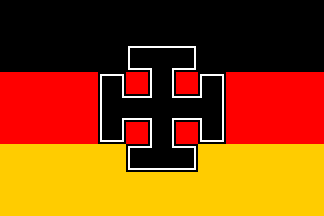 CFPD Flag (2006-2009) Type #1 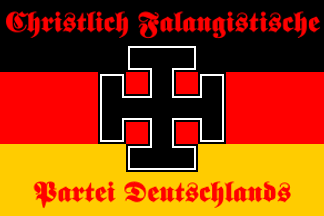 CFPD Flag (2006-2009) Type #2 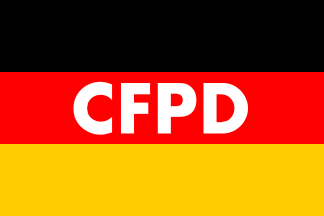 CFPD Flag (2006-2009) Type #3 (unverified) 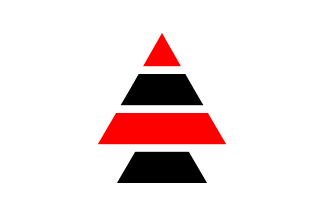 CFPD Flag (2006-2009) Type #4 |
Christian Falangist Party of Germany (2006-2009) Christlich Falangistische Partei Deutschlands (CFPD) The Christian Falangist Party of Germany was founded in 2006, with the aid of the Christian Falangist Party of America, which saw it as the first step in transplanting of its ideas to other countries. However, it turned to be the last step as well, because the party has not been very successful and was disbanded in 2009, not long before its model. The party seat was in the city of Ingolstadt. The Christian Falangist Party of Germany flags and emblems were derived from those of the Christian Falangist Party of America, whose leader Pat Bridges claimed to have designed them after having posted to a Flickr gallery several images showing different combinations of a modified German heraldic eagle with a CFPA crutch-cross. On the CFPD party website, which is no longer online, a German tricolor, charged with the large black crutch-cross fimbriated in white and black (Type #1) was used. A variant flag (type #2) was also shown with the party name inscribed in red, above and beneath the cross. A third tricolor (Type #3), had large initials CFPD, inscribed in white on red field. The Type #4 CFPD Flag uses a stylized tree centered on a white background and is obviously derived from the flag of the original Lebanese Falange. It is the only party flag not employing the national colors, gold being replaced with white.
The Type #5 and Type #6 CFPD flags use a fimbriated crutch-cross symbol centered on a plain fields using variations of the German national colors. 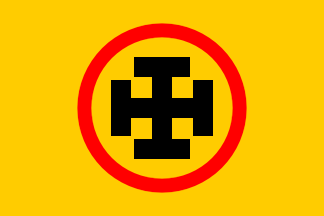 CFPD Flag (2006-2009) Type #7 The last CFPD flag (Type #7), has a crutch-cross symbol centered within a ring and is based on the 2003-2009 Christian Falangist Party of America flag, It simply replaces the United States national colors with those of Germany. |
||||||||||||||||||||||||||||||
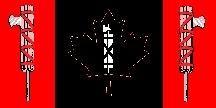 CFP Flag |
Canadian Fascist Party (Canada)
The Canadian Fascist Party (CFP) was a fascist political party based in the Canadian city of Winnipeg. Although the party was a splinter group from the Canadian Nationalist Party and claimed to base its platform on the principles of corporativism, rather than the largely racial motivations of the Nationalist Party, many of the party membership were racially motivated. The party was founded as the British Empire Union of Fascists and was affiliated with the British Union of Fascists. It later became known as the Canadian Union of Fascists and Canadian Union, for short. It published its own newspaper called "The Thunderbolt." |
||||||||||||||||||||||||||||||
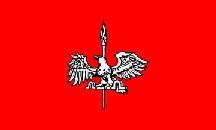 CEDADE Flag |
Spanish Circle of Friends of Europe (Spain) Círculo Español de Amigos de Europa (CEDADE) The flag of the Círculo Español de Amigos de Europa (CEDADE) was probably the first "modern flag" of an European neo-nazi organization. The official flag of CEDADE was all red with a golden eagle, holding a yoke in its claws and with a golden torch behind it. CEDADE was founded in 1966 and formally disbanded in 1993. |
||||||||||||||||||||||||||||||
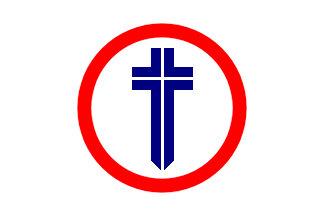 CFPA Flag (2000-2003) (Blue Battle Cross within a red ring) 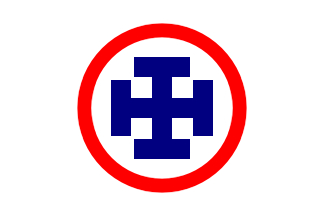 CFPA Flag (2003-2009) (Based on the Austro-Fascist flag) 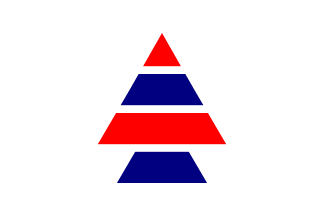 CFPA Flag (2003-2009) (Based on Lebanese Falange flag) 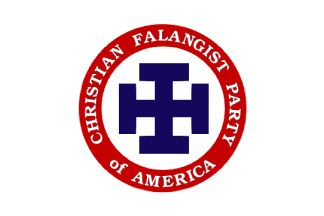 CFPA Flag (2007-2009) (Crutch Cross Flag variant) 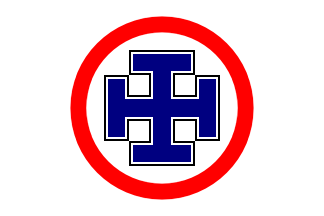 CFPA Directors Flag (2007-2009) 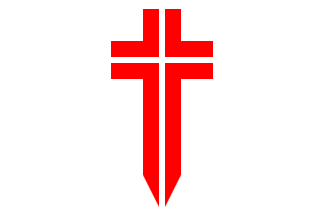 "Christian Forces" Flag (Red Battle Cross) 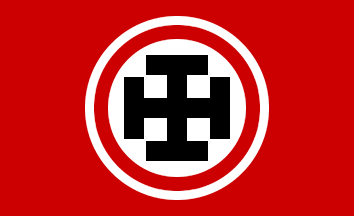 "The flag we can never use" 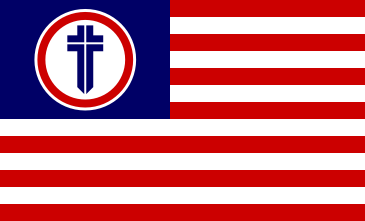 Naval Jack (2000-2003) 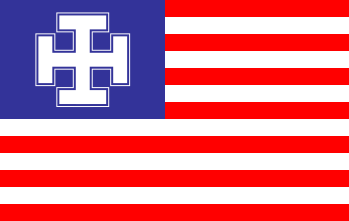 Naval Ensign (2003-2009) |
Christian Falangist Party of America (USA)
The Christian Falangist Party of America (CFPA) was founded in Philadelphia in 2000 to replace the National Syndical American Falangist Party (NSAFP). They claimed to be dedicated "to fighting the "Forces of Darkness" which seek to destroy all of Western Judeo-Christian Civilization. This new Falangist organization claimed that they no longer would condone acts of violence or hatred towards those of differing or opposing viewpoints and lifestyles, and they would no longer tolerate racism or anti-Semitism among their membership in any form. They severed their former ties to the Spanish Falange and all other "neo-Nazi/anti-Democratic/third position groups" who used the name Falange or Falangist. Instead of claiming succession from the NSAFP, they claimed to have derived their name from the Lebanese Falange, one of the oldest and strongest Christian parties from Lebanon, which, in fact, were originally modelled after the Spanish Falange, but gradually got rid of the Fascist "appearance" through the years, although its members still use a form of Roman salute. This new Christian Falangist Party claimed they believed only in the teachings of Jesus Christ and the Holy Bible. They supported the Constitution, the Bill of Rights, and nationalistic loyalty to the United States of America. Unfortunately, in practice, it soon turned out to be business as usual. The original party flag was charged with a blue "Battle Cross" within a red ring, all on white field. The cross was derived from a similar one which was used by the Lebanese Forces, a former militia and current political party of Lebanese Christians, which was also partly modelled after the Lebanese Falange (borrowed their form of Roman salute, etc.). In 2003, The "Battle Cross" was replaced with a crutch-cross. This emblem was derived from that of the Fatherland Front (Austria 1934-1938), whose ideology was known as the Austro-Fascism, but although it was authoritarian and corporativist, it was generally less oppressive than most similar contemporary European regimes. It certainly was anti-Nazi and opposed the Anschluss; their first leader, Chancellor Engelbert Dollfuss, was killed by the Austrian Nazis during an unsuccessful coup in 1934 and his successor, Chancellor Kurt Schuschnigg, was sent to a concentration camp after the Anschluss. After the war, Schuschnigg moved to the USA and became a US citizen and the professor of Political Science at Saint Louis University. The Christian Integralist and anti-Nazi ideology of the Fatherland Front was chosen by the CFPA to be their new source of inspiration. It should be pointed out here that the Crutch Cross a simplified version of the "Jerusalem Cross," or the "Crusader's Cross." They are a heraldic cross and a Christian symbol consisting of a large Greek cross surrounded by four smaller Greek crosses, one in each quadrant. They, like many other historical symbols, have been commandeered by extremist groups in an attempt to legitimize their existance. The Jerusalem Cross is also used on the flag of Georgia. Along with the Fatherland Front, the Lebanese Falange remained the model for the CFPA and an alternative party flag was introduced after 2003, using a stylized tree like the cedar of the Lebanese Falangists, but striped in red and blue on white field so as to display the US national colors. The "Battle Cross" has reappeared, in a slightly modified form and painted in red, on white flag of the "Christian Forces", a would-be militia or social organization which seems to never have been really operative (which makes it difficult to decide about their real nature), although an address was reserved for their planned website which never appeared, only their flag having been regularly presented along with the party flags. A rarely used variant of the official party flag was introduced in 2007, with much darker shades of blue and red and charged with the party name inscribed in white over the ring.
During the CFPA's active existance, their private militia security force called FALSEC (Falangist Security) has used three different flags. These were produced as a part of a whole range of flags, including a naval flag, called "jack" before the 2003 flag change and "ensign" afterwards, and a standard for the Directors (national and state heads of the party) since 2007. Probably the strangest flag was "The flag we can never use", which was declared as banned on the party website because its design resembled some far-right flags too closely and might have misled visitors to attribute the site to a neo-Nazi group.
In accordance with their anti-Muslim and pro-Israeli attitude, CFPA started a partner organization, the Christian Zionists of America (CZA), which adopted a flag derived from that of Israel. A second partner was planned, the Christian Zionist Roman Catholics (CZRC), which would use a flag similar to that of the Christian Zionists of America, but with a Jerusalem Cross instead of the crutch-cross. The CZRC was never started, because the CFPA was officially disbanded in 2009. It has since re-invented its self as the Christian Phalange Organization. Between 2006-2009, an associated Christian Phalange group called the Christian Falangist Party of Germany was organized in Germany, without much success. |
||||||||||||||||||||||||||||||
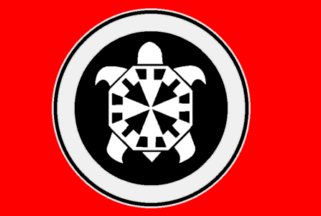 CPI Flag |
CasaPound Italy (Italy)
The neo-Fascist CasaPound Italy Movement began in 2003 with the occupation of a state-owned building in the Esquilino neighborhood of Rome. Their name referred to the American poet Ezra Pound who praised Mussolini's regime in the 1930s. Before 2006, CasaPound was associated with neo-Fascist Tricolour Flame Party, but has since become an independent movement. In 2011 it was estimated the CPI had as many as 5000 members. Their flag is definitely Nazi-inspired, showing a black-white symbol on a red field. The symbol is a stylized tortoise, representing the ancient Roman battle tactic called the testudo (Turtle), a formation where the soldiers would form a protective shield wall overhead and around themselves as protection from arrows and thrown spears. |
||||||||||||||||||||||||||||||
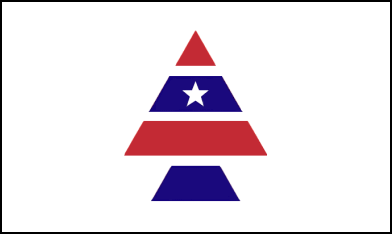 CPO Flag 2009 Based on the Lebanese Falange Flag 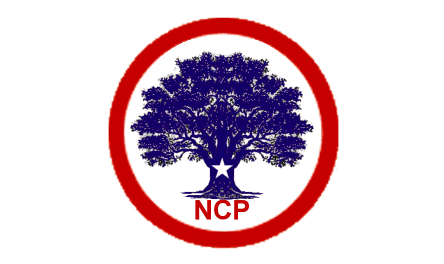 NCP Flag 2012 |
Christian Phalange Organization Flag (USA)
Formerly known as the Christian Falangist Party of America, the new Christian Phalange stated they were no longer a political party, but "a politically active social organization" in 2010. They claimed they changed their name because too many people associated the word "Falangist" with the neo-Fascist Spanish Falange and the neo-Nazis. They now invited any Christian of any race or nationality to join the Christian Phalange and that their new goal is to stop the spread of Islam. Despite the name and goal change, they still remain, however, an extremist and very radical Christian Conservative organization. Although they say they are pro-Israeli and not at all racist or Nazi, their membership still really seems to have it in for gays and Muslims. As the Christian Phalange cut back on their ultra-nationalistic symbolism, they also have abandoned their previous flags with the neo-Nazi-like appearance in favor of the one using a tree like the cedar of the Lebanese Falangists, but striped in red and blue, with a white star added on upper blue field. However, the newest variant of the Christian Phalange flag to appear has a more natural looking tree (oak?) in blue, with a white star on its trunk, and the initials "NCP" (National Christian Phalange) placed in a centered red circle on white background. It appears to be the work of Pat Bridges, the leader of the CFPA/CP. |
||||||||||||||||||||||||||||||
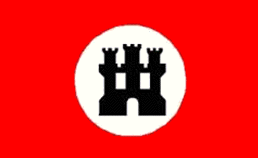 CNSC Flag 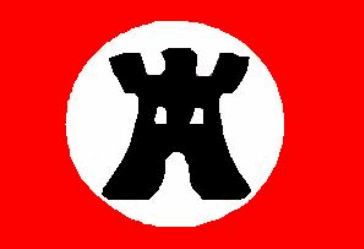 CNSC Flag (variant) |
The Castilian Council of Madrid (Spain) La comunidad Nacionalsocialista Castellana The La comunidad Nacionalsocialista Castellana (CNSC), also known simply as the "Council of Madrid," is a Spanish neo-Nazi group centered around the Madrid area which maintains an active Spanish website/blog filled with the usual articles warning about the "Zionist Red Army," "archaeological evidence" to support their beliefs, a future National Socialist Iberian state, various racial theories and distinctions, the Castilian solar wheel (the Broquel, or Castilian swastika), the British control of Gibraltar, the destruction of the Spanish States, Portugal, and a possible European Empire. They discuss a manifesto for forming an autonomous "Castilla-La Mancha," to include the provinces of Ciudad Real, Albacete, Cuenca, Guadalajara and Toledo. They tie themselves into National Socialism through their Germanic customs (Visigoths) and what they call the "Spanish epic." Their site abounds with slogans such as "Alive Iberia Unite!", "Alive The Socialist Struggle and Patriot!", and "Live Free Europe!" Their flag, using traditional National Socialist design and colors, features a traditional Castellan Castle instead of swastika. |
||||||||||||||||||||||||||||||
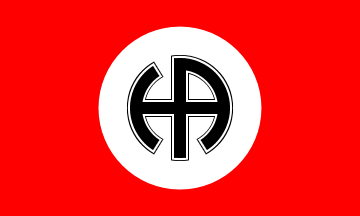 CEI Flag |
Circle of Indo-European Studies (Spain) Círculo de Estudios Indoeuropeos (CEI) The Círculo de Estudios Indoeuropeos (CEI) is a national-socialist organization founded in 1997. The organization claims to be a cultural movement and is considered by most to be a continuation of the "Spanish Circle of Friends of Europe. (CEDADE)" They use a "neo-Nazi style" flag: red field, central white circle with black symbol. The central emblem is composed of the joined letters "H" and a "A," standing for "Hereditas Ambitusque," which is Latin for "Inheritance and Scope." |
||||||||||||||||||||||||||||||
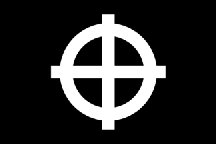 Celtic Cross Flag (Variant) |
Celtic Cross (Sun-Wheel) Flag
Although not explicitly a racist symbol, the Celtic cross, or more properly the "Sun-Wheel," is often used by people in the white power movement, especially skinheads. The cross pictured here is one most often used by racist groups. Many New Right groups began using this type of flag, with the main symbol being the Celtic Cross, because it isn't outlawed in most countries and they can claim it as a heritage symbol. The term "New Right" is used as a descriptive term for various policies and/or groups that are to the extreme "far-right." It has also been used to describe the emergence of extremist Eastern European parties after the collapse of communism. |
||||||||||||||||||||||||||||||
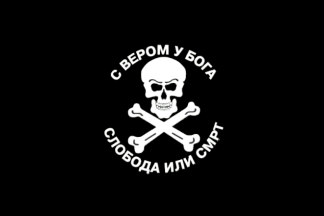 Chetnik Flag (Type #1 - 1991-present) 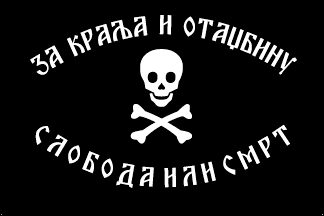 Chetnik Flag (Type #2 - 1991-1999) 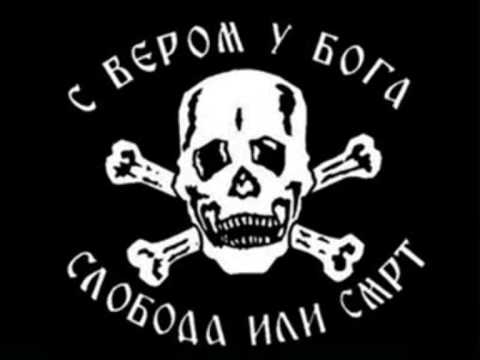 Modern Variant Flag (Type #3 - actual use questionable) |
Flag of the Chetniks (Serbia)
Here is a flag with a long history that proves the rule, "one man's extremist is another man's patriot." In Serbia this flag served as a resistance flag against the World War II German occupation, but now has been opted by extremist groups and others to serve very different purposes. The Chetniks (Troopers) were originally guerrilla groups which, since 1903, operated in areas still under the Ottoman rule, fighting not only against the Ottoman Empire, but also against similar Bulgarian groups. They also participated in the Balkan Wars (1912-1913) alongside the regular army, and again in World War I, in parts of Serbia which were occupied and annexed by Bulgaria (1915-1918). Along with Serbian national flags, they used black flags with skull and crossbones and inscriptions like Sloboda ili smrt (Freedom or Death). (Similar flags were also used in the Macedonian uprising against the Ottoman Empire in 1903.) In World War II and afterwards, the Chetnik flag came to be used by anti-Communist resistance fighters. Thanks largely to Communist propaganda against the Chetniks in Serbia they were labeled extremist. The name Chetniks also became a name used by various legitimate para-military groups in the bloody Yugoslav Wars in the 1990s, but unfortunately, also became a name used by groups of local thugs and criminals hiding under the name in order to get some impunity for their actions. Naturally this Communist over-propagandizing of the name also resulted in making the flag popular among various other groups, some of whom were extremists, some not, some merely patriotic, and some who were just plain thugs. In Serbia today it is sometimes hard to determine which was which. The original World War II Chetnik flags usually had the inscription S verom u Boga (With Faith in God) and Za kralja i otadžbinu (For King and Fatherland), sometimes with places switched, because "For King and Fatherland" and "With Faith in God" had been inscribed on Serbian military colors until 1918. Two of the flags (Type #1 and #2) shown here were used during the Yugoslav Wars. The inscriptions at the top are S verom u Boga (With Faith in God) and Za Kralja i Otadžbinu (For King and Fatherland), respectively, and Sloboda ili smrt (Freedom or Death) at the bottom. Variants of these flags, with differing text, are still also used freely by Serbian anti-Communist emigrants in Western countries as the symbol of a non-Communist resistance movement. The Type #3 variant is being sold, but its use is questionable, and has not been seen or documented in Serbia. |
||||||||||||||||||||||||||||||
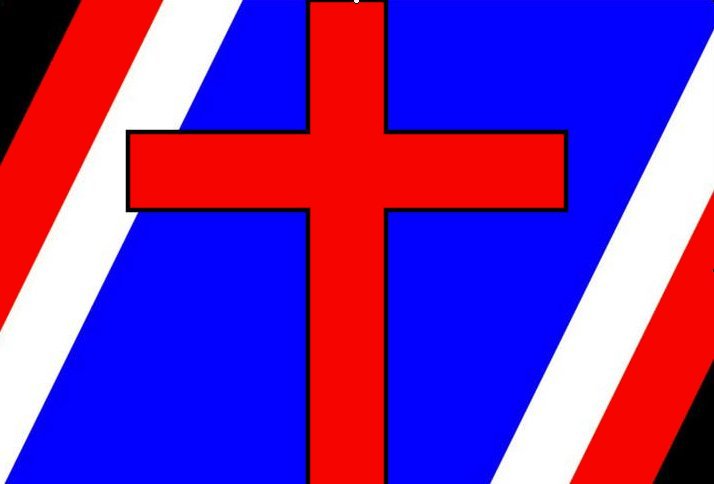 Colonial Christian Republic 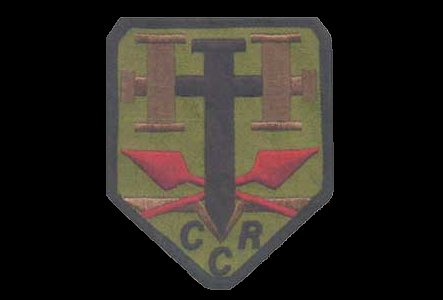 Hutaree Militia Flag |
Colonial Christian Republic (USA)
The Colonial Christian Republic, with its Hutaree Militia, is a militant Christian fundamentalist group based in Adrian, Michigan. The group was formed in early 2008. They claim "Hutaree" means "Christian Warriors." The group is preparing for what they believed will be an apocalyptic battle with the forces of the Antichrist (the UN), who they believed is supported and defended by local, state and federal police departments. On their website, all police and military members who would support the current U.S. system of local, state or federal government are described as members of an evil brotherhood and are considered by the Hutaree to be their enemies. The Hutaree insignia includes a sword, crossed spears, and the letters "CCR" which stands for "Colonial Christian Republic." Hutaree members use a strange system of paramilitary ranks with titles from highest to lowest: Radok, Boramander, Zulif, Arkon, Rifleman (three grades), Lukore, and Gunner (three grades). In March of 2010, nine Hutaree members were arrested in police raids in Michigan, Ohio, and Indiana, for their alleged involvement in a plot to kill various police officers and possibly civilians using illegal explosives and firearms. |
||||||||||||||||||||||||||||||
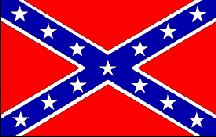 CSA Naval Jack (historic ) |
Confederate States of America (USA)
Although the Confederate flag is seen by many Southerners simply as a symbol of Southern pride, it is often used by racists to represent white domination of African-Americans. The flag remains a subject of controversy because some Southern states still fly the flag from public buildings or incorporate it into their state flag’s design. The flag is also used by racists as an alternative to the American flag, which they consider to be an emblem of what they describe as the Jewish-controlled government. |
||||||||||||||||||||||||||||||
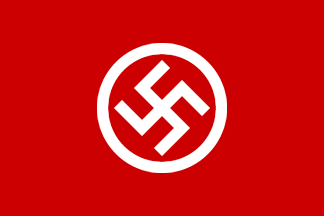 DNSB Flag |
National Socialist Movement of Denmark 1991 (Denmark) Danmarks Nationalsocialistiske Bevaegelse The National Socialist Movement of Denmark was founded in 1991 as the latest in the list of successor parties to the original National Socialist Workers' Party of Denmark (Danmarks Nationalsocialistiske Arbejderparti - DNSAP), which was disbanded in 1945 after World War II ended.
The original DNSAP Flags were square (ratio 1:1) with reversed swastikas centered on them. The present DNSB flag features a red field with a white swastika within a ring of white. |
||||||||||||||||||||||||||||||
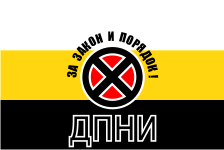 DPNI Flag (in Romanov Imperial colors) 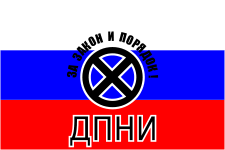 DPNI Flag (in Russsian National colors) |
Movement Against Illegal Immigration (Russia)
The Movement Against Illegal Immigration (DPNI) is a Russian nationalist hate group and anti-Illegal immigration organization. The DPNI was founded in 2002 by Vladimir Basmanov, in 2008 leadership passed to Aleksandr Belov (Potkin), the former press spokesman for ultra-nationalist Pamyat's leader, Dmitry Vasilyev. In 2010 the leadership changed once again, and Vladimir Ermolaev now leads the group. The Movement Against Illegal Immigration was created in 2002, in reaction to ethnic violence between residents of a Moscow's suburb and immigrants from the South Caucasus and Central Asia. The Movement Against Illegal Immigration organized a number of anti-immigrant rallies throughout Russia. It also took part in carrying out the annual Russian March, a Russian ethnic pride display and protest event. Aside from mass protests the movement was active in organizing public pressure to support ethnic Russians in number of high profile court cases involving crimes committed by the immigrants. Human Rights Activists had filed complaints with the Russian authorities because they believed the DPNI was "pursuing a fascist agenda," exemplified by slogans such as "Russia is for Russians!" Because the Movement continued to repeatedly take part in events aimed at igniting inter-ethnic hatred, it was finally banned by the Moscow City Court in 2011. At the present time, a suspension of the activities of the organization remains in force. The Movement Against Illegal Immigration was one of the more active political organizations in Russia with about 5000 members in 30 different regions. |
||||||||||||||||||||||||||||||
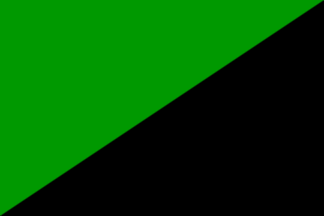 Eco-Anarchists Flag (Type #1) 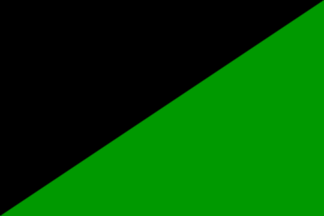 Eco-Anarchists Flag (Type #2) 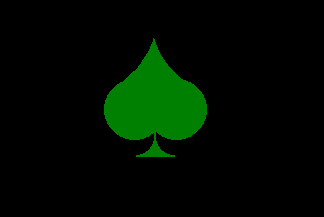 Eco-Anarchists Flag (Type #5) |
Eco-Anarchists or Green Anarchists (Worldwide)
Green Anarchism, or Eco-Anarchism, is strange mixture of anarchism and environmental issues. Its multiple sources can be found in the teachings of such notables as Henry David Thoreau, Ralph Waldo Emerson, Leo Tolstoy and Élisée Reclus. This fusion of anarchism and naturist philosophies is now worldwide.
Unfortunately some Green Anarchists groups have engaged in direct action and acts of eco-terrorism. Groups like Earth First!, Root Force, the Animal Rights Militia, the Earth Liberation Front (ELF), the Earth Liberation Army (ELA), the Olga Cell, and the Animal Liberation Front (ALF) have taken direct action against "systems of oppression." There have been violent attacks on the logging industry, the meat and dairy industries, animal testing laboratories, genetic engineering facilities, and government institutions. After attempted assassinations of nuclear scientists, and letter bombs sent to nano-tech and nuclear-tech facilities, many Eco-Anarchist groups, or their sub-groups, have been named as terrorist organizations. Groups like the Animal Rights Militia, the "Justice Department" and "Revolutionary Cells" have even claim responsibility for these openly violent attacks. It should be pointed out that not all Eco-Anarchist groups engage in these violent protest activities, but unfortunately, some do. |
||||||||||||||||||||||||||||||
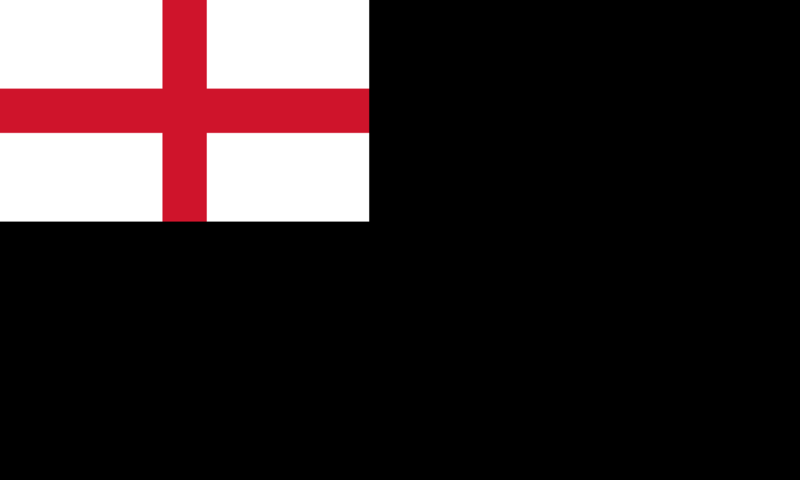 EM Flag |
English Mistery (United Kingdom)
The English Mistery (or English Mystery) was a political and esoteric group active in the United Kingdom of the 1930s. A "Conservative fringe group" in favour of bringing back the feudal system, it was described as a patriotic organization who proposed a ´Masculine Renaissance,´ espousing an ultra-reactionary, aristocratic Toryism with an addition reference to Nietzsche, elitism and eugenics." Its views have been characterized as "aristocratic, ultra-conservative, Tory integral nationalistic, anti-liberal democratic, reactionary ultra-royalist, and anti-democratic." (Enjoy that trip to the dictionary) Basically, it was against everything to do with welfare, the London School of Economics, and the United States. It was founded by William Sanderson, and took its title from his 1930 book That Which Was Lost: A Treatise on Freemasonry and the English Mistery. Sanderson was a Freemason, but disaffected, and founded the group in 1930 to promote his views of "leadership." |
||||||||||||||||||||||||||||||
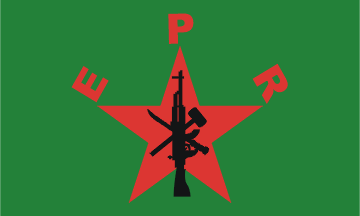 EPR Flag (type #1) 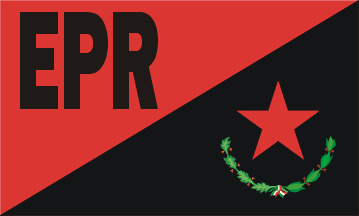 EPR Flag (type #2) |
Revolutionary People's Army (Mexico) Ejército Popular Revolucionario EPR The Popular Revolutionary Army is a violent leftist movement in Mexico led by a masked leader who identifies himself as "Captain Emiliano." It was first formed in 1996 and after engaging police in a fire fight near the Guerrero capital of Chilpancingo, "declared" war on the Mexican government in a document called the Aguas Blancas Manifesto. The EPR guerrilla currently operates in the States of Guerrero, Oaxaca, Chiapas, Guanajuato, Tlaxcala and Veracruz.
The main flag used by the EPR has a green field with a red star, superimposed over the star are crossed rifle, machete and hammer. Just off the three uppermost points of the star are the initials "EPR." Two other flags also reported in use are shown here. |
||||||||||||||||||||||||||||||
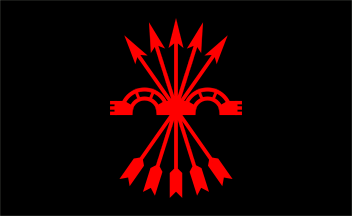 FB Flag (2000) |
Puerto Rican Phalanx (Puerto Rico) Falange Boricua The name of this movement is loosely translated as "Puerto Rican Phalanx". It was founded in March 2000 as a Puerto Rican counterpart of the Spanish Phalanx and allegedly banned in May same year, after having attempted to blockade US military bases in Puerto Rico. It was soon refounded as the National Syndicalist Movement of Puerto Rico, but possibly ended its activities some time afterwards. The movement flag, as presented at their website (still existing), was charged with red yoke and arrows on black field. This flag might have inspired the Venezuelan Phalanx to adopt the same design in early 2002, claiming that it is the common flag of Latin American Phalangists. Along with its own flag, the movement also used the Cross of Burgundy flag as the symbol of Hispanity (Hispanidad), as well as the Grito de Lares flag and the flag of the Nationalist Party of Puerto Rico, which were both considered important national symbols. |
||||||||||||||||||||||||||||||
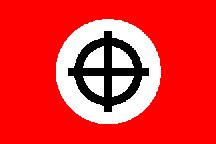 FDG Flag (Sun Wheel variant) |
Italian Nazi Party (Italy) Fronte Della Gioventú The Black Sun Wheel, or Celtic Cross, on a white disc became the international symbol of young nationalist in several European countries. It is usually placed on a red field as is done with the Fronte Della Gioventú (FDG), or the Italian Nazi Party Flag shown here. Because this Celtic Cross was adopted by a prohibited neo-Nazi party in postwar Germany, its public display in Germany was banned along with the swastika under the federal criminal code, as part of legislation designed to forestall any revival of Nazism. It is still freely used in Italy. |
||||||||||||||||||||||||||||||
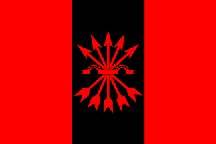 FE Party 1933 (original version) 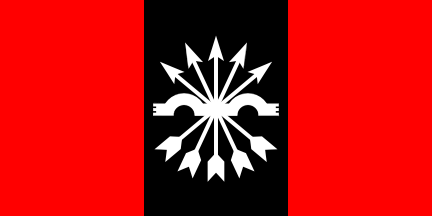 FE Party (popular variant) 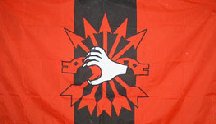 FE Party (modern variant) |
Spanish Phalanx 1933-1977 (Spain) La Falange or Falange Española The term Falange is used by several political movements and parties dating from the 1930s, including the original Fascist movement in Spain. The word "Falange" actually means "phalanx," (a Macedonian or Spartan Greek military formation) in Spanish, and there are many small parties still calling themselves the Falange Party today. The warlike symbol of the phalanx was chosen due to the militaristic nature of these National Socialist type parties. It should be noted here that the yoke and the arrows both were taken from the Catholic King's emblems (the yoke for Ferdinand of Aragon and the arrows for Elizabeth of Castile) and the same symbols were readopted by Franco's regime. The original Spanish Falange movement was founded in 1933 by José Antonio Primo de Rivera, who was the son of the former Spanish dictator, General Primo de Rivera. Their platform (political agenda) combined the national traditions of Spain with these of Fascist ideology. The Falange symbol was also used in World War II on a flag used by the soldiers of the Divisio'n Azul (Blue Division), a Spanish volunteer unit in the German Army which fought on the Eastern Front. It was formed in 1941, and was disbanded 1943. Theirs was certainly not the only case of using of a flag with this design: there have been many flags with the Falange symbol on them. Today, decades after the fall of the Franco Fascist dictatorship, Spain still has several minor Falangist organizations, represented by a number of tiny political parties. Chief among these are the Falange Española (de las Juntas de Ofensiva Nacionalsindicalista), Falange Española de las JONS, Falange Auténtica, Falange Española Independiente, and FE - La Falange. Following post-Francoist Spanish Falanges is a bit confusing, with their splittings and mergings and use of similar names which have even led to several lawsuits. These fascist inspired parties are rarely seen publicly except on the ballots, in State funded TV election advertisements, and during demonstrations on historic dates, such as November 20 celebration the death of both Jose Antonio Primo de Rivera and General Francisco Franco. For example, in the 2004 national elections, these parties combined received less than 28,000 votes between all of them. |
||||||||||||||||||||||||||||||
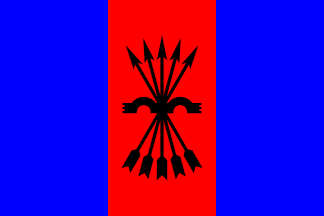 FNGE Flag |
Ecuadorian Garcian National Phalanx (Ecuador) Falange Nacional Garciana Ecuatoriana The Ecuadorian Garcian National Phalanx was a Falangist group in Ecuador apparently modeled after its Spanish and Latin American counterparts. Very little is known about this small and apparently short-lived movement, although we can speculate that the name Gaciana was derived from the Spanish last name of García, and suggests that the group was formed to honor a certain military man whose last-name was "García". Of course, "Phalanx" (Falangist and Falange in Spanish) is today defined as a "Spanish military, unionist, laborist, or anarchist" group. This particular Falangist group attempted to trace its origins back to the Falangism and Synarchism of the Alianza Revolucionaria Nacionalista Ecuatoriana which was started by Jorge Luna in 1948, but there seems to be little actual similarity or real connection between the two groups. The FNGE flag was a typical Falangist design incorporating a blue-red-blue vertical triband design with Falange black yoke and arrows on the red field. |
||||||||||||||||||||||||||||||
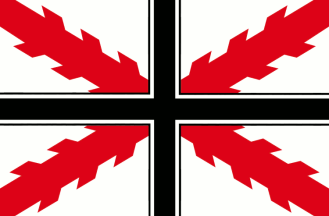 FI Flag |
Ibero-American Front (Mexico) Frente Iberoamericano The Ibero-American Front is a neo-Nazi group based in Mexico whose stated intention is to extend its activities to all Latin American countries. Although they claim to condemn all the genocides committed so far, their insistence on the "14 words of David Lane", as well as the Nazi-style graphics all over their website, clearly reveal their nature. Their stated goal is to "protect" the Creoles (Latin Americans of European origin) by formation of separate states for them wherever possible; these states would eventually gather in a Union of Sovereign and Independent Creole States. The flag of Ibero-American Front is derived from the Cross of Burgundy flag, which is increasingly being used by Latin American ultra-rightists, with the addition a black and white cross. The cross is designed to resemble the German Balkenkreuz which, along with the complete set of colors, is another reference to the Nazism. |
||||||||||||||||||||||||||||||
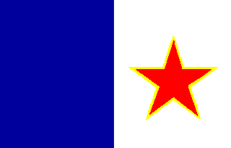 FLQ Flag |
Quebec Liberation Front (Canada) Front de Libération du Québec The paramilitary group Quebec Liberation Front was founded in 1963 by Georges Schoeters, a Belgian revolutionary. The goal of the FLQ was to "free" Quebec from Canada and form an independent nation. They were soon labeled a terrorist organization for their violent methods and were responsible for many violent incidents which killed eight people and injured many more, including a bombing of the Montreal Stock Exchange in 1969. In 1970, during the "October Crisis," they kidnaped James Cross, the British commercial envoy in Quebec, and assassinated Pierre LaPorte, the Labor Minister of Quebec province. By 1971, the Montreal Police Antiterrorist Unit was able to arrest most of the FLQ leaders and dozens of members, after which the remaining FLQ broke up into several unorganized splinter groups. The Quebec Liberation Front used a blue and white horizontal striped bicolour with a red star (bordered in gold) centered on the white fly that was seen at demonstrations between 1968-71 in Montreal and the U.S. |
||||||||||||||||||||||||||||||
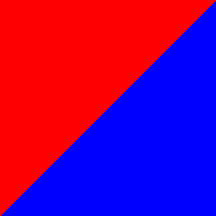 FN Flag (Type #1) 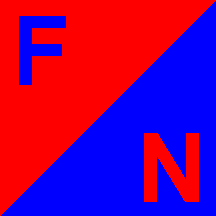 FN Flag (Type #2) |
New Force (Spain) Fuerza Nueva The New Force is the name of a far-right political association in Spain which was founded by Blas Piñar in 1966 with the aim of opposing any reforms of the Fascist regime of Spain, an authoritarian state dictatorship between 1939 to 1975, that existed under General Francisco Franco. From 1976 to 1982, New Force operated as a political party, hoping to stop the transition to democracy, but the lack of political success made it eventually disband itself, although it has reappeared under different names, always under the leadership of Blas Piñar, who is the honorary president of Spanish Alternative (Alternativa Española) since 2003. The present association New Force is mainly dedicated to commemorating the anniversaries of beginning of Spanish Civil War (July 18th) and death of Francisco Franco (November 20th). Their calls to demonstrate on these dates have generally been supported by neo-Nazi, skinheads and other militants of the extreme right.
The New Force flag is parted diagonally red over blue, which recalls the red berets and blue shirts worn by the members of Spanish Traditionalist Falange (FET/JONS), the single party during the rule of Francisco Franco. Initials FN in counterchanged colors, or both in white or yellow, may be added to usually plain fields. |
||||||||||||||||||||||||||||||
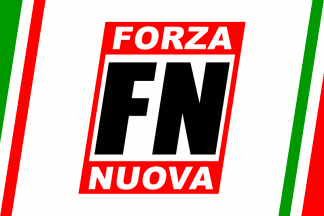 FN Flag (Type #1) 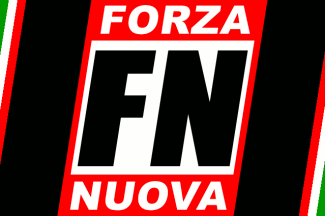 FN Flag (Type #2) 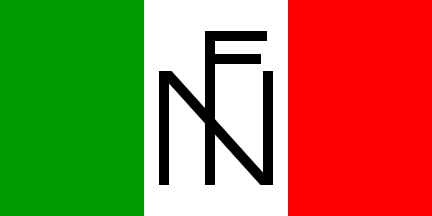 FN Flag (Type #3) 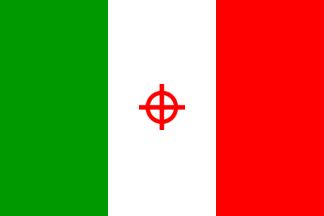 FN Flag (Type #4) |
New Force (Italy) Forza Nuova The Forza Nuova (FN) is an Italian far right political party. Founded by Roberto Fiore and Massimo Morsello, and supporting the ideas of Julius Evola, the party is a member of the European National Front and was a part of the Social Alternative from 2003 to 2006. The party policies are an interesting blend of National Socialist ideology and traditional Roman Catholicism. New Force mostly uses two flags (Types #1 and #2) charged with its logo, which is a white rhomboid charged with party name initials in black and placed in centre of a larger red rhomboid which also contains party name inscribed in white above and below the central device. This logo is based on a common template used also by other European ultra-rightist movements which are members of the European National Front. Of these flags, the one much more used has black field (Type #2) and the logo height equal with the flag width, although some photos seem to show a black fimbriation. (Also see: Nordic Youth of Sweden and the New Right of Romania [Type #3] for similar flags.)
At many New Force rallies, besides using the two main flags shown at the top left, a more traditional Italian Nazi Flag with the Sun Wheel (Type #5 and Type #6) has also been used both in red and black backgrounds. A NSDAP-style flag with the letters "FN" on a white disc also exists in variants of black and red colours, in fact, this variant can be found more frequently on the Web than the earlier one.
Either a black sun wheel or the letters FN, in somewhat different form, sometimes appear in the center stripe of the Italian Tricolor (Type #3). A sun wheel version (Type #4), the wheel usually in red, but also black, has also been reported. Also reported are Types #7 and #8 with either light blue or black backgrounds and an off-center green, white, and red rondel placed slightly behind large white block letters "FN" and words "Forza Nuova" written directly below. |
||||||||||||||||||||||||||||||
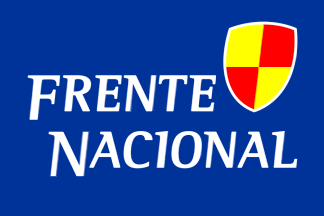 FrN Flag |
National Front (Spain) Frente Nacional - FrN The National Front operated under the name "The Phalanx" between 2006-2009 after a split in the Spanish neo-Phalangist Phalanx Party (La Falange) left both factions using the same name until in 2009, when a court ruling awarded the rival faction the exclusive use of the name. After the court ruling the FrN party officially adopted the name National Front which it had previously only used to identify itself on ballots for the purpose of elections. The split in La Falange occurred due to a dispute about the leadership. The leader of the faction which eventually became the National Front, and of the National Front until the disbanding, was Jose Fernando Cantalapiedra. It never achieved any significant success after 2009 and disbanded itself in 2011. The party flag was blue, with the party name inscribed in white in two rows and a yellow-red quartered oblique shield, fimbriated white and placed in the top fly corner. The shield and inscription on blue field were also used as the party logo. While yellow and red were used as the national colors, blue, as the color of Phalangist shirt, was probably the only remaining reference to the origins of the party. |
||||||||||||||||||||||||||||||
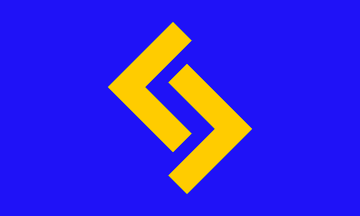 FNU Flag |
National Youth League (Sweden) Förbundet Nationell Ungdom - FNU The National Youth League is a neo-Nazi movement started in in 2011 by Robin Boström. It was started with financial help from the Party of the Swedes sponcered newspaper "National Today." The name was borrowed from the 1930s pro-Nazi National Youth League of Sweden (Sveriges nationella ungdomsförbund, SNU). There followed several other Nazi and neo-Nazi youth organizations with the same or similar names, the last being the National Youth, part of the Swedish Resistance Movement, which was dissolved in 2006. The current organization describes itself as "a platform for educating young ethnic Swedes through workshops, lectures, and martial arts training." The FNU has six chapters and a national organization. Like many other similar Swedish groups, the FNU uses a flag in national colors, with a large gold Jeran rune on blue field. The proto-Germanic rune "Jeran" dates back to approximately AD 200-400 and means "good harvest." The flag was first seen in the town of Eskilstuna in 2012 at a demonstration organized jointly by the National Youth League and the Party of the Swedes. |
||||||||||||||||||||||||||||||
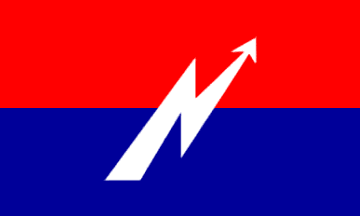 FON Flag 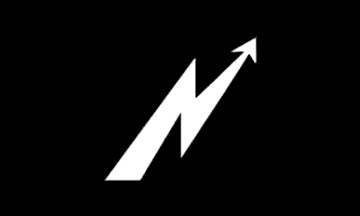 JNS Flag |
The National Order Front Movement (Chile) Del Movimieto Frente Orden Nacional The Del Movimieto Frente Orden Nacional (FON) sees national socialism as a new force standing between national and international adversity for the Chilean people. The letter "N" stands for National Socialism, and is shown in the form of a ascending ray that points upward. This represent the birth of the movement and their goal to create a state which has as the main objective the spiritual development of the Chilean people according to the socialist values of the National Front, thus breaking with "the strings of a system that maintains its existance at the cost of our compatriots." The Flag of the National Socialist Youth (JNS)The movement, with the intention of "instilling habits of discipline" uses a special uniform which is worn by the members who have "been admitted" to participate in the ranks. They claim that the uniforms will lead to the "establishment of an egalitarian life," and be a "starting point" that is common to all Chileans. |
||||||||||||||||||||||||||||||
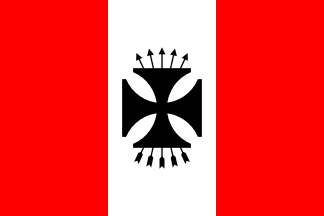 FP Flag |
Peru Phalanx 2005-2012 (Peru) Falange Peru The Peru Phalanx was a minor Peruvian Fascist political movement, active from 2005 to 2012, which seemed to have been modeled after the Spanish Phalanx. Their platform (political agenda) combined the national traditions of Spain and Peru with these of Fascist ideology. Its flag, obviously derived from the Peruvian national flag, was defaced with the FP logo (a black emblem composed of five arrows behind an Iron Cross) which was centered on the white stripe. It should be noted that the logo design is quite similar to that used by the Blue Division, the Spanish volunteers' unit in the German Army on the Eastern Front, during World War II. |
||||||||||||||||||||||||||||||
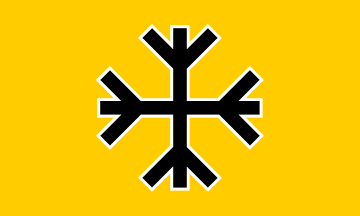 FSP Flag |
People's Front Party 2008/Party of the Swedes 2009 (Sweden) Folkfronten/Svenskarnas parti The Party of the Swedes is a nationalistic political party, active in Sweden. It was founded by members of the former National Socialist Front in 2008 under the name People's Front, but was renamed in 2009 after it was revealed that a leftist party was already registered under that name. The leader of the party is Daniel Höglund, who was also one of the two leaders of the National Socialist Front. The FSP also has ties with a youth movement called the National Youth League (Förbundet Nationell Ungdom); although no official links exist with the party, they clearly have a close co-operation, and their leaders, according to the Swedish website Expo Skola, do have a common history of membership in the National Socialist Front. The party flag uses a cross composed of Algiz (elk) runes as its main design element. Karl Maria Wiligut was responsible its adoptions by the NSDAP and it was subsequently used widely on insignia and literature during the Third Reich. Various forms of the Algiz rune are also commonly used by various Germanic Neopagan groups as a symbol of their religion. The flag field is yellow, the color which both symbolizes the sun and appears in the Swedish national flag. |
||||||||||||||||||||||||||||||
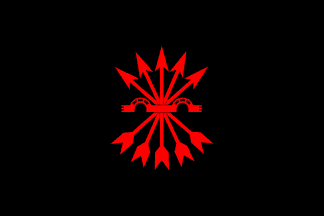 FV Flag (original version) 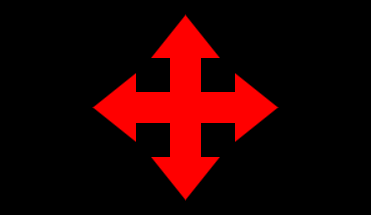 FV Flag (newer variant) |
Venezuelan Phalanx (Venezuela) Falange Venezolana The Venezuelan Phalanx is a minor political movement modelled after the Spanish Phalanx. The use of the term Falange refers to the ancient Spartan military formation and is used by several Fascist political movements and parties in Latin America. 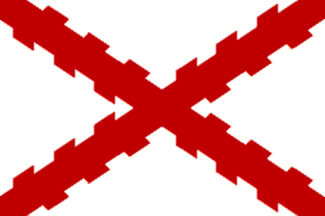 Cross of Burgundy (Spanish historical) The first FV flag differs slightly from the original Spanish model in that it features an all-black field, which the FV claims is the only common feature with all Latin American Phalangist movement flags; the red color of yoke and arrows was kept unchanged. (Note: This flag is also similar in design to that of the defunct National Syndical American Falangist Party.) The second FV flag differs in that the black field is charged with a large red arrow cross. This variant made its appearance in 2002. Another flag commonly seen at FV rallies is the historical Spanish Cross of Burgundy. |
||||||||||||||||||||||||||||||
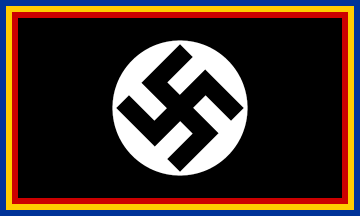 Garda de Fier Flag 1927-1938 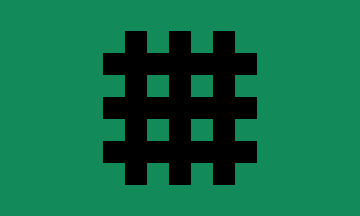 Garda de Fier Flag 1938-1941 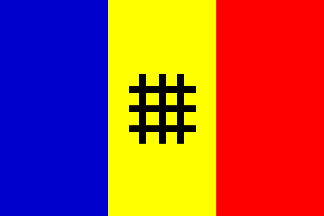 Garda de Fier Flag (variant #1) 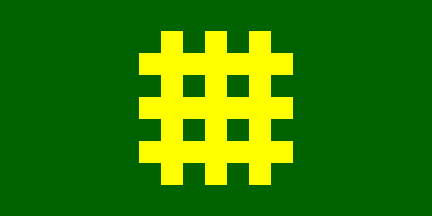 "New" Garda de Fier Flag Not used by the original movement, but by an organization using the same name in the early 2000s. This variant would be also later used by the New Right Party. |
The Iron Guard 1927-c1940 (Romania) Garda de Fier The Iron Guard was an ultra-nationalist, fascist, anti-communist, and extremist Orthodox Christian movement originally founded by Corneliu Zelea Codreanu, an anti-Semitic professor at the Bucharest University in 1927. Originally known as "The Legion of the Archangel Michael" (Legiunea Arhanghelului Mihail), then renamed the "Everything for the Country" (Totul pentru Tara) Party, and the "The Legionnaire Movement" ("Miscarea legionara), but the name most commonly given to this far-right Romanian movement and political party was "The Iron Guard." Its members wore green uniforms, thus were sometimes called "Greenshirts" (Camasile verzi), and greeted each other using the Fasist Roman salute. The main symbol used by the Iron Guard was a triple cross, standing for the prison bars of martyrdom, and sometimes referred to as the "Archangel Michael Cross" (Crucea Arhanghelului Mihail). The Iron Guard differed from other fascist movements because its membership, rather than the usual military veterans, came from the peasantry and students. However, the legionnaires shared the fascist love for violence and political assassinations. The black flag of the movement, with its swastika in a white circle, soon became well-known in Romania in the late 20s and the early 30s. It was originally used by the National Christian Party, a similar although less militant party, in whose founding Codreanu took part in 1923 before having broken away to found the Iron Guard. (A tricolor with the swastika was used later by the National Christian Defense League and the National Christian Party) After 1938, the swastika symbol was replaced by the triple cross and the black field on their flags was normally replaced with a green, but ocasionally a red one.
The movement took part in the Spanish Civil War, and they had two prominent martyrs, both close to Codreanu, who died in the battle of Majadahonda. In 1938, when Codreanu was assassinated after the Guard started its conflict with King Carol (Charles) II over his plans to convert the country into a fascist nation. A campaign of assassinations ensued by Guard "legionnaires" who formed death squads and even though they managed to kill the prime-minister, they were almost decimated in the process. The black grid flag was completely banned by the Antonescu regime in 1941 and the new Guard leader, Horia Sima (Codreanu's successor), was sent to Buchenwald concentration camp. He was released in 1944, became the head of the Romanian government in exile until 1945, but was never allowed to returned from exile and died in Spain. A modern neo-Fascist successor to the Iron Guard calling themselves "The New Right" was founded in 2000. |
||||||||||||||||||||||||||||||
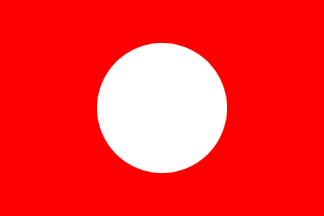 GJYP Flag |
Great Japan Youth Party (Japan) Dai-Nippon Seinen-tō "Great Japan Youth Party", later renamed "Great Japan Sincerity Association" (Dai Nippon Sekisei-kai), was founded in 1937 by Colonel Kingoro Hashimoto during his forced retirement from military service because of his involvement in the attempted coup d´etat of 1936. The organization was modelled after the Hitler Youth and its goal was turning japan into a single-party totalitarian state modelled after the Third Reich. In 1940, it was grouped with other nationalist movements into the Imperial Rule Assistance Association (Taisei Yokusankai), where it served as the youth wing of the IRAA. The organization was dissolved in 1945 after the capitulation of Japan and Hashimoto was sentenced to life imprisonment. The flag of Great Japan Youth Party was derived either from that of the Third Reich, by omitting the swastika, or from the Japanese national flag, by reversing the colors, or possibly from both of these flags. The pattern was also used on the armbands of the Nazi-style uniforms, as well as the decoration on the official documents of the party. |
||||||||||||||||||||||||||||||
| Golden Dawn Flags with the Meander symbol also known as the Greek Key pattern or the Greek fret (maeandros) 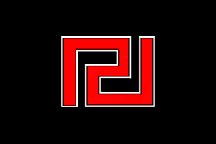 Golden Dawn Flag pre-2005 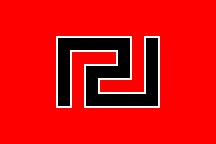 Golden Dawn Flag pre-2005 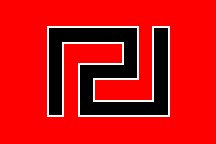 Golden Dawn Flag post-2007 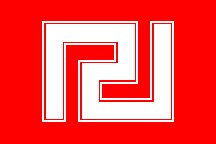 Golden Dawn Flag post-2007 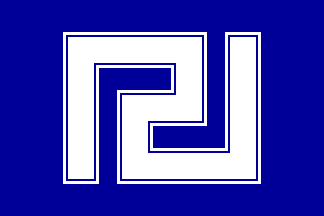 Golden Dawn Flag 2010 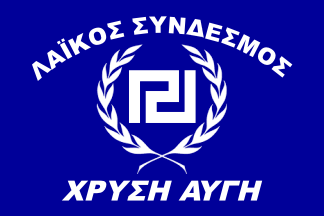 Golden Dawn Flag 2010 People's Association of the Golden Dawn 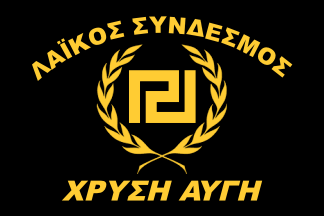 Golden Dawn 2012 (Black and Gold Variant) 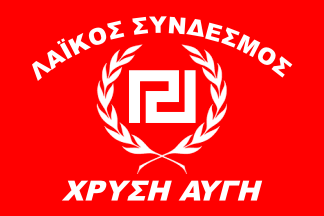 Golden Dawn 2012 (Red and White Variant) |
Golden Dawn (Greece) Chrysi Avyi The Chrysi Avyi is the biggest extreme-rightist organization in Greece, not to be confused with the "Hermetic Order of the Golden Dawn," a peaceful society dedicated to the philosophical, spiritual, and psychic evolution of humanity. The Greek "Golden Dawn" is anything but peaceful, and has been responsible for carrying out acts of violence and hate crimes against immigrants, political opponents and ethnic minorities. The group favored the use of two symbols: the meander (an ancient Greek decorative pattern) and the Sun Wheel. It ceased to exist as the separate organization in 2005, merging with the Patriotiki Symmahia (Patriotic Alliance), which used different symbols. In 2007, the Patriotic Alliance ceased to exist and the Golden Dawn announced its re-activation (and reintroduction of the meander and sun wheel). Since then, the website of Golden Dawn has been regularly updated. The same is true for Metopo Neolaeas (Youth Front) website, the youth wing of the organization. These Sun Wheel variants are being used by a wide-variety of extremist groups today.
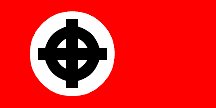 Golden Dawn Banner Also used by Unit 88 (New Zealand) The Prasini Pteryga (Green Wing) is an ecologist organization founded by members of the youth wing of the Golden Dawn. It uses a green flag, charged with a white Celtic Cross with outer white and inner green fimbriations. A new flag appearing in 2010 has blue field and is charged with a smaller maeandros (meander) within a wreath, between the inscriptions LAIKOS SYNDESMOS (People's Association) and H RYSI AYGI (Golden Dawn), possibly now the official name of the organization. Another Golden Dawn flag (Variant #5), using a combination of a football (soccer) club colors (orange and blue), is now used by some fans of the Apoel Football Club of Nicosia, Cyprus. This is an example of how ultra-rightists attempt to infiltrate normal society, and by introducing their flag to football fans as a non-political symbol, it provides them with a valuable tool of later indoctrination.
Two new Golden Dawn flags were introduced in 2011 and 2012. The first is charged with a large letter epsilon within a wreath, all black with white fimbriations, on a dark red field. The letter epsilon probably stands either for Ellas (Greece), Ethnos (Nation), or Ethnikismos (Nationalism). The second Golden Dawn flag appeared in 2012 and has a black Meander symbol with white fimbriations placed on a red shield with white border, all centered within a red wreath on a black field. "Golden Dawn" (in Greek) is spelled in red block letters directly below the wreath. Note: This second may only be an illustration used for Golden Dawn articles, its actual use as a flag is unverified. |
||||||||||||||||||||||||||||||
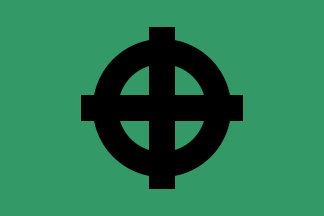 GR Flag |
Green Rights (Belgium) Groen Rechts The Groen Rechts (GR) is an Ecologist ultra-rightist organization. The Green Rights website contains almost no information about the group, although since the logo of N-SA appears at the bottom of all the pages it suggests that members of the Nieuw-Solidaristisch Alternatief (Neo-Solidarist Alternative Movement) must have founded the GR. The flag of the Green Rights, with its black Celtic cross on a green field, also further suggest ties between two organizations. The Groen Rechts green flag has been prominently displayed at various Flemish rightist demonstrations in recent years, suggesting an active membership in the area. |
||||||||||||||||||||||||||||||
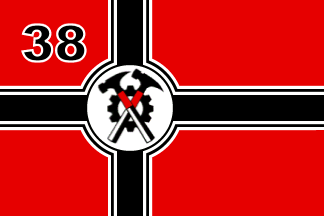 Hammerskin-Crew 38 Flag 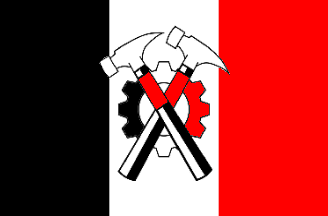 Hammerskin Nation Flag 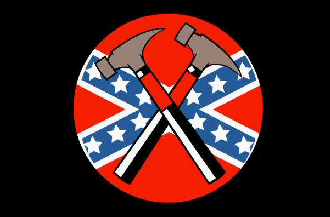 Confederate Hammerskin Flag |
Hammerskin Nation (USA)
The Hammerskins, or Hammerskin Nation, are a white supremacist group formed in 1988 by Sean Tarrant in Dallas, Texas. Their primary focus seems to be the production and promotion of white power rock music, and many white power bands claim affiliation with them. The Hammerskins host several annual concerts, including the "Summer of Hate" concert and the "Hammerfest" in honor of deceased Hammerskin Joe Rowan, the lead singer of the band Nordic Thunder, which has become an annual event in both the United States and Europe. The Anti-Defamation League describes them as the best-organized neo-Nazi skinhead group in the United States. They claim six chapters in the United States: The Northwestern Hammerskin Chapter (NWHS), Western Hammerskin Chapter (WHS), Confederate Hammerskins (CHS), Northern Hammerskin Chapter (NHS), Eastern Hammerskin Chapter (EHS), and the Midland Hammerskins (MHS). The ISVG (Institute for the Study of Violent Groups) says the movement is now international, with chapters existing in Australia, Canada, Czech Republic, France, Germany, Hungary, Italy, New Zealand, Portugal, Slovakia, Spain, Sweden, and Switzerland. According to them there are about 200 members with group affiliations with the Aryan Nations, Ku Klux Klan, National Alliance, Vinlanders, Volksfront, and White Aryan Resistance. The Hammerskins also have what they call supporter chapters, known as Crew 38, for non-members who support their activities. The Hammerskins logo, "depicting two claw hammers crossed to resemble goose-stepping legs," is based on the 1982 film Pink Floyd The Wall. Their logos and motto "Hammerskins Forever, Forever Hammerskins" (HFFH) often appear on their buttons, T-Shirts, posters and tattoos. Crew 38 and Hammerskins members also frequently identify themselves with the slogan "838," meaning "hail the crossed hammers" (the acronym HCH translates into the eighth, third, and eighth letters of the alphabet). The first Hammerskin flag shown here was used at the Summer of Hate concert, organized by the Western Hammerskins, the Southern California branch of The Hammerskin Nation. The second flag design has been also used as a badge and logo, and the Confederate Hammerskin flag has also reportedly been used as a square wall banner. |
||||||||||||||||||||||||||||||
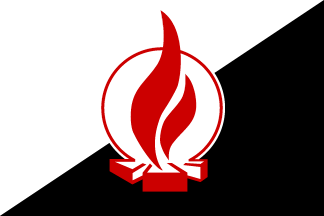 HDJ Flag 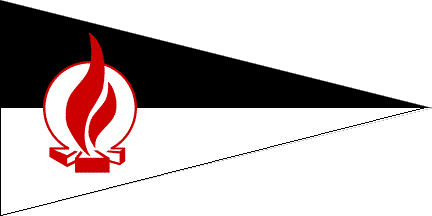 HDJ Pennant |
German Youth Loyal to the Homeland (Germany) Heimattreue Deutsche Jugend (HDJ) The Heimattreue Deutsche Jugend (HDJ) is a neo-Nazi youth association offering Hitler youth-style camping holidays and other youth activities for children and young people that attempts to familiarize participants with Nazi thinking and teach children, as young as six, that foreigners and Jews are a threat to the nation, leading them into right-wing extremism. The HDJ emerged from the "League of Youth Loyal to the Homeland - Free League" (Bund Heimattreuer Jugend - Freibund), an organization originating in late 1950s that was based on the traditions of early 20th-century German youth movements, and co-operated closely with the Viking Youth and other neo-Nazi organizations until the late 1980s when it began distancing from them, causing its most extreme members to break away in 1990 and found "The Youth Loyal to the Homeland" (Die Heimattreue Jugend), renamed the HDJ in 2000. Involvement of Viking Youth members in their activities, as well as the members' participation in acts of violence, resulted first in a ban on wearing uniforms in 2007, which they declared they wouldn´t obey, and eventually by the complete banning of the group itself in 2009. The HDJ website claimed it fought "for an independent Germany, for traditional values and for a lifestyle reflected in a healthy body, spirit and character. It also [fought] the use of English in the German mother tongue." Its newspaper "Firebrand" (Funkenflug) had a subtitle "Young, Stormy, Loyal to the People." Since it is illegal to display Nazi symbols in Germany, the HDJ´s flag features a stylized campfire, but maintains the traditional national socialist colors of red, black and white. On some reported variants of the flag a caption in a red ribbon is located below the campfire reading Heimattreue Deutsche Jugend (German Youth Loyal to the Homeland). |
||||||||||||||||||||||||||||||
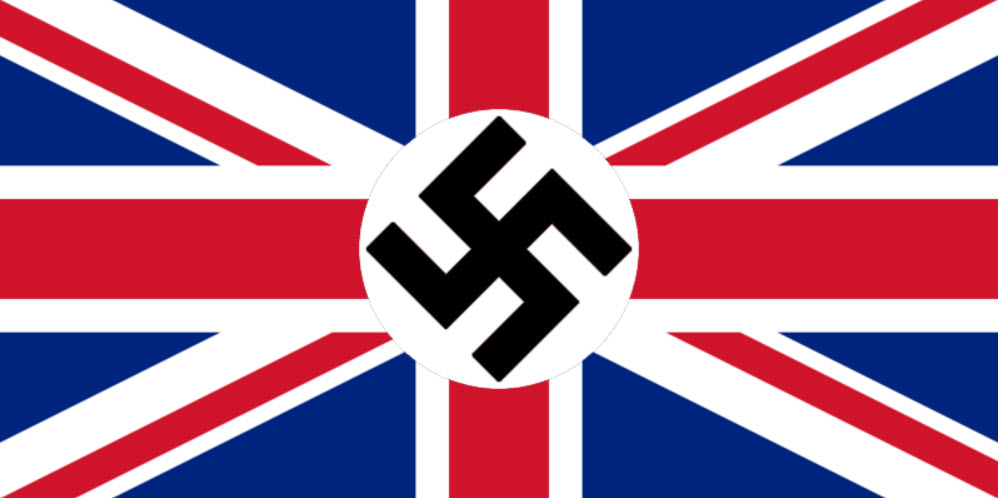 IFL Flag 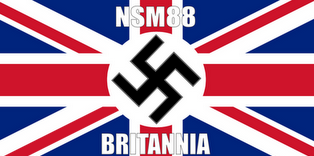 NSM "88" Flag |
Imperial Fascist League (United Kingdom)
This was the flag of the Imperial Fascist League (IFL) a British Fascist movement led by Arnold Spencer Leese between 1928 until 1939. The IFL was a small group with never more than a few hundred members. They wore black shirts and were organized for street battles. Initially, they used the fasces as a symbol, but adopted the swastika superimposed on the Union Flag after Adolf Hitler came to power in Germany. The group was in harsh competition with the British Union of Fascists, and more than once there were street battles between the two extremist groups. Eventually, the BUF proved too strong, and by 1939, the IFL had largely disappeared. Their flag regained brief notoriety when a picture of it being used in a 1938 pro-nazi demonstration in London was re-published in a 1997 edition of Newsweek magazine. The IFL flag got new life when it was adopted by the new National Socialist Movement 88 Britanna (NSM) the newest reincarnation of the movement in the United Kingdom under the leadership of a "Corporal John." Once again the NSM's core beliefs include (from their website) "...defending the rights of white people everywhere, preservation of our European culture and heritage, strengthening family values, economic self-sufficiency, reform of illegal immigration policies, immediate withdrawal of our national military from an illegal Middle Eastern occupation and promotion of white separation." |
||||||||||||||||||||||||||||||
 INP Flag (Type #1) 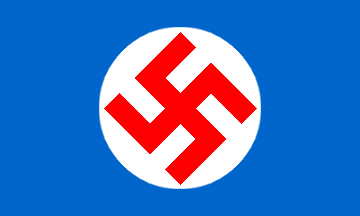 INP Flag (Type #2) |
Nationalist Party (Iceland) Flokkur Þjóðernissinna Nationalist Party was founded in 1934 by fusion of the Icelandic Nationalist Movement (Þjóðhreyfing Íslendinga), founded in 1933, and their breakaway members - the original Nationalist Party. The party believed in Aryan supremacy and anti-Semitism, and intended to make Iceland a Corporativist state, but never developed a personality cult of a supreme leader. The membership never exceeded 450. The British invasion of Iceland in World War II in 1940 caused a mass exit from the party which was officially disbanded in 1944. In Iceland today, membership in the Nationalist Party is a matter of embarrassment and very few objects, including the party flags, have been saved, except perhaps by a small number of collectors who are interested in this period of Icelandic history. The Nationalist Party used two different flags in national colors. The first flag added the swastika to the 19th Century proposal from which the national flag was derived. The swastika was placed on a white diamond, conjoined with the cross into a single charge. The second flag had a typical Nazi design, with red swastika on a white disk in center of blue field. |
||||||||||||||||||||||||||||||
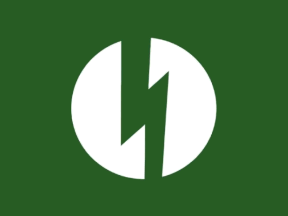 IPGB Flag) |
Integralist Party of Great Britain and Northern Ireland (United Kingdom)
The Integralist Party of Great Britain and Northern Ireland, founded by Robert Stead and Benjamin Noyles, is a small political movement in Great Britain that seems to be a strange combination of neo-Fascistism, localism, traditionalism, trade unionism, corporatism, and environmentalism. It combines elements of both the political left and right, but claims not to be racist, although they do oppose mass immigration and what they call the EU "straightjacket." They see the nation as an organic unity, and feel that there has been a social, political, and economic decline suffered in Great Britain that must be corrected. Their flag has a green lightning-bolt or thunderbolt on a white circle, called "the lightning in the sun," placed on a plain green field. The Integralist claims their symbol is a modern adaptation of the British Union of Fascist’s "action within unity" symbol, and although clearly derived from the BUF flag, the flag´s designer, Benjamin Noyles, once claimed the symbol isn't neo-Fascist in nature. |
||||||||||||||||||||||||||||||
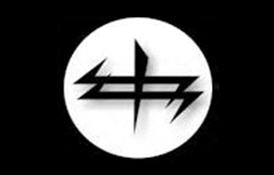 IAMF Flag |
Iranian Aryan National Front (Iran) Jebhe Nasionalisti-ye Iranian-e Arya The Jebhe Nasionalisti-ye Iranian-e Arya (IAMF) is an ultra-nationalistic organization with Iranian national ideals as its prerogative. They emphasize Aryan Values and are definitely in support of the concept of Aryan Racial superiority. Although the Iranian Aryan National Front is a new organization, they do supports a website with their views, agenda, and articles in a semi-organized format. |
||||||||||||||||||||||||||||||
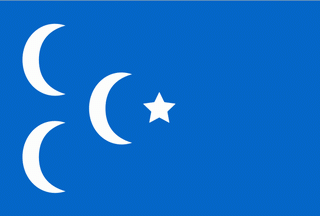 IBDA-C Flag |
Great Eastern Islamic Raiders' Front (Turkey) Islami Büyükdogu Akincilar Cephesi The Great Eastern Islamic Raiders' Front is an Islamic militant hate group that follows the teachings of Necip Fazil Kisakürek and his racial hate philosophy of Büyük Dogu (Great East). The group's goal is to create a new Sunni Caliphate in the Middle East. They claim credit for attacks on Shia, Alevi, Christian, and Jewish diplomatic, business, and religious interests in Istanbul. The group has defiantly moved from rhetoric to violence and is credited with a series of 90 bombings and attacks in the 1990s. The flag of IBDA-C is blue with three white crescents arranged in a triangular pattern at hoist. The inner crescent is accompanied by a white 5-pointed star. |
||||||||||||||||||||||||||||||
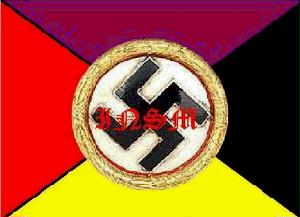 INSM Flag |
Iranian National Socialist Movement (Iran) Jonbesh-e Nasional Sosialist-e Iran The Jonbesh-e Nasional Sosialist-e Iran (INSM) is the latest addition to the Internet-based National Socialist organizations of Iran. Although the organization is Iranian, strangely enough they use the English script letters "INSM" centered on their flag standing for "Iranian National Socialist Movement." The background colors on the flag (red-brown-black gold clockwise) are the colors used on the Derafsh-e-Kaviani, the oldest Persian flag dating back to the Persian empire. According to legend, it had be made of a long rectangular leather apron used by national hero Kaveh the ironsmith during the reign of King Fereidoun, and mounted on a spear. This leather banner became the symbol of Iranian independence, resistance, resilience and the revolutionary momentum of the masses revolt against evil invaders. Today it is known as the"Glorious Flag" of Iran. |
||||||||||||||||||||||||||||||
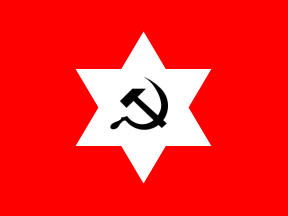 INBP Flag (Type #1) 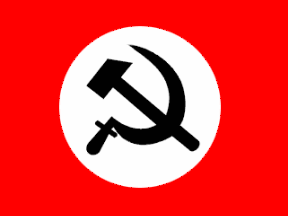 INBP Flag (Type #2) |
Israeli National Bolshevik Party (Israel) also National Bolsheviks of Israel The Israeli National Bolshevik Party is a strange contradictory one. National Bolsheviks in other countries generally have an anti-Zionist and pro-Palestinian attitude, but their Israeli counterparts are openly Zionist and frequently co-operate with other extreme Zionist groups. They also claim the heritage of Poalei Zion and other Jewish leftist organizations from the Russian Empire (most of their members are immigrants from ex-USSR countries). They also frequently express the solidarity with the "repressed" Russian NazBols, but generally seem not to be very close with most of their European counterparts, who, as mentioned, are generally very anti-Zionist and pro-Palestinian. According to the INBP itself: "Israel was invented and founded by Red Zionists geopolitically as part of Eurasia, from the beginning oriented towards the Eurasian continent and developed as a Red proletarian communal republic. We, the National Bolsheviks of Israel, see our global mission in the resurrection and reworking of the idea of very great social justice for the Workers of Zion in the context of an interconnection with Russian National Bolshevism and the construction of a single imperial state free from the tyranny of globalism." Along with their Type#1 flag, the party sometimes also uses the "generic" National Bolshevik flag (Type #2) with the hammer and sickle on a white disc. However, it seems to be done quite rarely, mostly because the Nazi-looking design of the flag, which must be quite unpopular in Israel. |
||||||||||||||||||||||||||||||
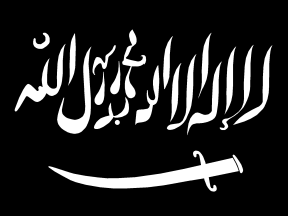 JAU Flag |
Army of the Nation (Palestine) Jaysh al Ummah The Army of the Nation is a small terrorist group based in the southern Gaza town of Khan Yunis and led by a man known only as Abu Hafss. The armed members of this group wear black robes over black pants with red or black "death squad" headbands. The group considers themselves "brothers" of the al-Qaida terror network and threaten not only to operate in the Giza-Tel Aviv area, but "God willing" to take the fight to Washington. Hamas has supported and allowed such extremist groups as the JUA to train openly in Palestine. Abu Hafss's group has claimed responsibility for several recent mortar and rocket attacks on Israeli border communities, and is one of several small al-Qaida-inspired groups, such as the Army of the Nation and the Army of Islam, that have emerged in Gaza in recent years as the area goes deeper into poverty, which, of course, creates fertile ground for such militant groups. |
||||||||||||||||||||||||||||||
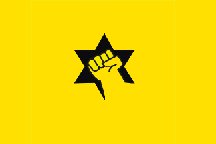 Kahane Chai Flag (This flag usually has various customized inscriptions added to it) |
The "Thus Kahane Lives" Movement (Israel) Kach Kahane Chai The Kach Movement began as a far right political party in Israel, founded by Rabbi Meir Kahane in the early 1970s. It was barred from participating in elections after 1988 under Israeli elections laws that banned parties that incited racism. In 1990, Kahane was assassinated after making a speech in New York City. After Kahane's assassination the party split with the Kahane Chai breaking away from the main Kach faction. Both the Kach and Kahane Chai Movements were banned outright in 1994, and today, both groups are considered terrorist organizations by Israel, Canada, the European Union, and the United States. The group has been responsible for using explosives that has done damage to property, including an attempt to car bomb a Palestinian girls school in East Jerusalem, threatening and conspiring to carry out assassinations, and for soliciting funds and members for a terrorist organizations. |
||||||||||||||||||||||||||||||
Knight's Party Flags 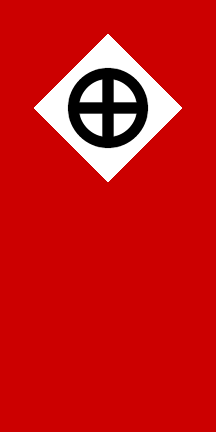 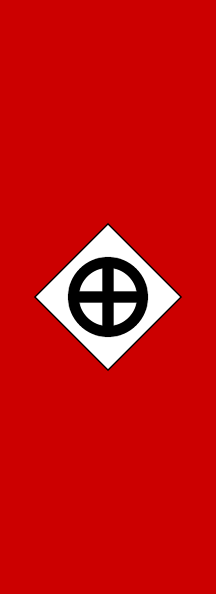 (Variants for wall hanging) |
Knights' Party (USA)
The Knight's Party is now a registered political party whose purpose is to provide an avenue for the members of the Ku Klux Klan (see below) to run as political candidates in elections. They host a new look for their website and now claim to be "peacefully" seeking to abolish all discriminatory affirmative action programs. They wish to become known as the "White Rights Movement" and consider themselves as "the Last Hope for America." They are still in the same old business, but trying for a newer more "politically correct" look.
This new flag is clearly inspired by the traditional National Socialists design, but instead of white disc with a black swastika, it has a white diamond enclosing a black Sun Wheel. Flag variants include diamonds with black borders or without borders. |
||||||||||||||||||||||||||||||
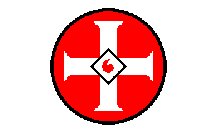 The Blood Drop Flag 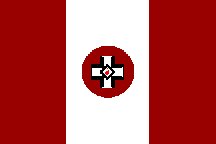 The Duke Flag 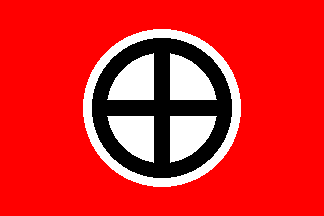 The Sun Wheel Flag |
Knights of the Ku Klux Klan (USA)
The Blood Drop symbol is most often used by various Klan organizations throughout the United States. Usually at clan rallies there are actually a lot more United States Flags displayed than KKK flags, despite their very un-American racial beliefs. The Ku Klux Klan was established in Tennessee in 1866. Most of the leaders were former members of the Confederate Army and the first Grand Wizard was Nathan Forrest, a confederate general during the American Civil War. In the late 1800s and early 1900s Clansmen wearing masks, white cardboard hats and draped in white sheets, have been responsible for torturing and killing black Americans and sympathetic whites. The Civil Rights movement of the 1960s prompted a modern rebirth of the Ku Klux Klan activities that has persisted until the present day.
The variant KKK flag (red-white-red background with the center Blood Drop symbol) is commonly called the "Duke Flag" named for neo-Nazi, turned clan leader, David Duke. David Duke was also shown in KKK broadcast with a red flag (complete with centered white disk and black Sun Wheel) hanging on a wall behind him, apparently a holdover from his neo-Nazi days. In addition to the American and Confederate flags, there is a KKK "White Power" flag with fist emblem centered on a black field, that occasionally appears at Clan rallies. A new, but undocumented flag is a KKK/White Power/CSA Flag currently being sold. |
||||||||||||||||||||||||||||||
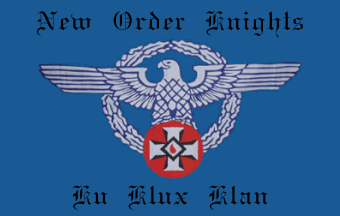 NOKKKK Flag |
New Order Knights of the Ku Klux Klan (USA)
Another small splinter group (or individual) claiming to be part of the KKK are calling themselves the New Order Knights of the Ku Klux Klan. Proclaiming themselves the "Blue Tunic Army," they claim that their mission is to preserve the white heritage, so future generations will know and learn from their history." They proclaim a strange combination of anti-semitism, national socialism, and Christianity claiming that National-Socialism is the way of the Aryan warrior, yet say their "dedication is to educate, not in hatred, but with pride for the race that (they) are a part of." Not much is really known about this group. Their flag has a silver eagle and wreath reminiscent of those used by the Third Reich centered on a light blue field, holding a KKK Blood Drop symbol where one would expect the swastika to appear. The words "New Order Knights" in a black script are written above the badge, with the words "Ku Klux Klan" appearing below. |
||||||||||||||||||||||||||||||
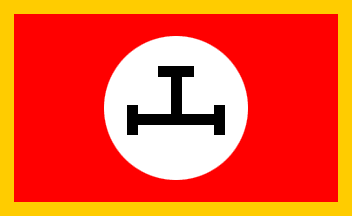 KKK-LLC Flag |
The Ku Klux Klan, LLC 2003 (USA)
Headquartered in Compton, Arkansas, the Ku Klux Klan Limited Liability Company (KKK LLC), is yet another attempt to legitimize the KKK. A limited liability company (LLC) is a legal form of corporation that provides limited liability to its owners. Chartered in the State of Arkansas, and working under a legal business structure, this branch of the KKK claims its actions are all completely legal and aboveboard. They pay taxes, keep legitimate financial records of all their activities, and claim to act only as a resource for Klan philosophy and its meaning. The emblem in the center of their flag is the "Triple Tau." They claim it is a symbol of Christianity dating back to the time of Christ. According to the Klan the cross symbol (a H bisected by a T) represents the Cross, God and Christ. A variant of this flag does not have the gold border surrounding the red field. |
||||||||||||||||||||||||||||||
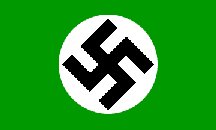 Libertarian Green Party |
Libertarian National Socialist Green Party (USA)
The Libertarian National Socialist Green Party (LNSGP), is an American organization that cites the National Socialist German Workers Party as its primary ideological inspiration, while also incorporating elements of Libertarianism and the Green movement. It has not been established whether LNSGP has any activity or existence other than through its website. It doesn't appear to have any active membership. |
||||||||||||||||||||||||||||||
 LANC Flag (1923-c.1927) 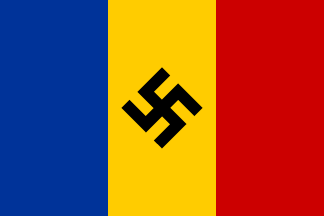 LANC Flag (c.1927-1935) |
National Christian Defense League 1923-1935 (Romania) Liga Apararii National Crestine - LANC National Christian Defense League was founded in 1923, by transformation of the National Christian Union (Uniunea National Crestina), which was founded previous year. Founder and leader of both parties was Alexandru C. Cuza, a politician already known after his extreme anti-Semitism, in service of which he was using even the proposals that would otherwise sound progressive for those times, like universal male suffrage and land reform. Second position in the new party was held by Corneliu Zelea Codreanu, whose political mentor Cuza was during previous years. The flag of National Christian Defense League was black with a white disc charged with a black swastika, all within a border in national colors. According to Codreanu, black field was the symbol of mourning, white disc symbolized the "hopes surrounded by the darkness they will have to conquer", while the swastika was adopted as the worldwide symbol of anti-Semitism. The last statement suggests that the symbol was actually borrowed from the Nazis of Germany, although Cuza later claimed that it was used in Romania since 1910, when he took part in founding of the Democratic Nationalist Party (Partidul Nationalist Democrat), from which he later broke away to found the National Christian Union, the party whose use of the swastika is indeed verified. Although the National Christian Defense League drew inspiration from Italian Fascism and German Nazism, it was not as militant as these movements and Cuza was constantly refusing Codreanu's proposals to turn the party into a militia. This eventually caused a split in 1927, when Codreanu broke away to found the Iron Guard. New movement quickly took many supporters from the National Christian Defense League, which managed to survive, although somewhat weakened, until 1935, when it merged with the National Agrarian Party (Partidul National Agrar) to form the National Christian Party (Partidul National Crestin). Some time after the split, the National Christian Defense League adopted a new flag, Romanian tricolor with a black swastika in the center, which it transferred to its successor in 1935. |
||||||||||||||||||||||||||||||
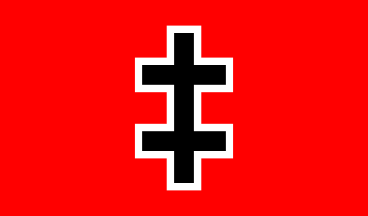 LITAS Flag 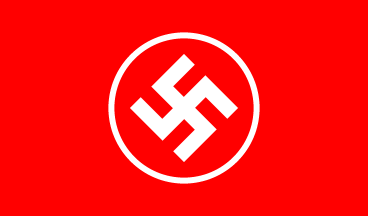 LNSVS Flag (unverified) 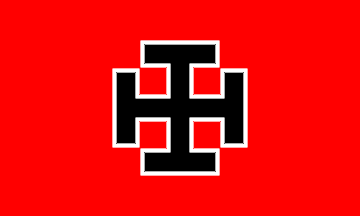 VLNDS "National" Flag 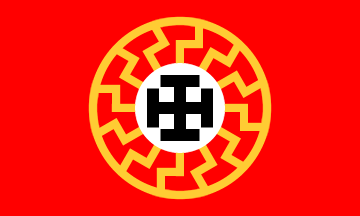 VLNDS "Party" Flag 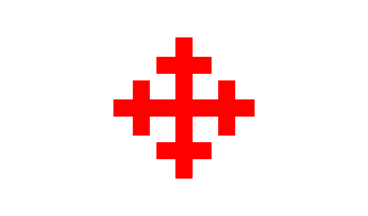 LTDS Flag 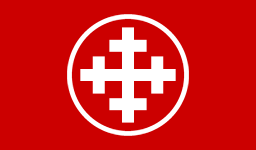 LNSP Flag |
Lithuanian National Union (Lithuania) Lietuviu` Tautos Sa`junga - LITAS The Lithuanian National Union, founded 2011, is the most current neo-Nazi party in Lithuania. It is the successor of a host of previous neo-Nazi organizations. To name a few:
The VLNDS flag most frequently used was originally described as the "National" flag. The party described the cross as the combination of two swastikas, one right-facing and one left-facing. The flag they called the "Honor" flag has never appeared in any public demonstrations and was perhaps only used during private meetings, if any copies were made at all, for its design was never made known to the public. The VLNDS "Party" flag ("Organizational" flag, as it was called by them) was shown at the party website, but its actual use was not verifed so far. It is derived from the flag used by the LNDP in 2001-2007 (while Murza and his followers were its members) and also by the VLNDS in early 2007, but the white disc and black cross of the original design were reduced in size and superimposed over a "Black Sun," a well-known Nazi symbol, depicted here in gold color. To denote its ideological heritage, the VLNDS also sometimes used the flags of the Lithuanian Union of National Socialist Unity and the Lithuanian National Socialist Party. The flag of the Lithuanian Union of National Socialist Unity (LNSVS) which featured a white swastika on a white outlined red disc placed on a red field, was most likely the flag of some earlier neo-Nazi group, because it does seem to be more traditional, and there have been many similar organizations previously in Lithuania. Their verified flag was similar to that of the LNDP, but was charged with a cross crosslet instead of the cross potent. The Lithuanian National Labour Union (LTDS), founded by a re-organization of the Lithuanian Union of National Socialist Unity (LNSVS), but replaced almost imediately the next year, used a flag that had a red cross crosslet on white field which differed from most used among the neo-Nazi groups in Lithuania that all favored red fields. Its replacement, the Lithuanian National Socialist Party (LNSP), used a red flag charged with a white cross crosslet on a white outlined red disc; the dark shade of red was also sometimes attributed to other flags used, but was verified only for this one. |
||||||||||||||||||||||||||||||
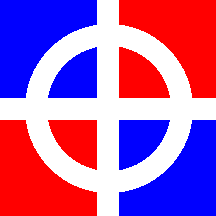 LOEF Party Standard 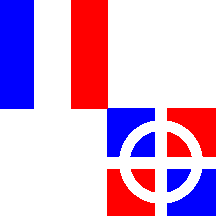 LOEF Secretariat flag |
The French Work (France) L'Œuvre française The French Work is a French ultranationalist movement, founded in 1968 by Pierre Sidos. Sidos has a long history of founding, providing leadership, and memberships in a variety of different extremist groups such as Young Nation, the Nationalist Party, 13 May People's Movement, Organization of the Secrete Army, to name just a few. Most of these organizations were banned by the French government for being either anti-semitic, neo-Nazi, racist, or prone to violence. Somehow, the French Work has remained marginally legal in the French political picture. The L'Œuvre française main goal seems to be replacing the French Republic with a new monarchy whose goal would be to return France to its "historic role and civilizing mission." On the L'Œuvre française website there is much discussion on the origins and meaning of the "Celtic Cross" and its meaning and use as the party standard, explaining that they "rightfully consider the Celtic Cross as their oldest national emblem, without fearing any kind of comparison," one would guess, to the swastika used by the German Third Reich and the Celtic Crosses used by many other neo-Nazi nationalist groups. The Four-Quartered flag was reported used as the emblem of the LOEF Secretariat during the Nationalist Congress (Congrés nationaliste), a gathering of various French ultra-rightist organizations. |
||||||||||||||||||||||||||||||
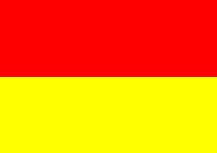 Speculative Flag of the LRA (possible reported color pattern) 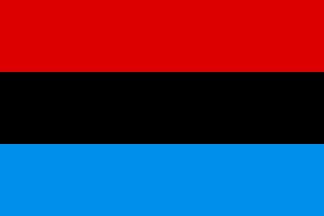 Speculative Flag of the LRA (reported, but questioned) |
Lord's Resistance Army (Uganda)
The Lord's Resistance Army (Lord's Resistance Movement), led by Joseph Kony, who proclaims himself the spokes person of God and the Holy Spirit, is a militant terrorist group which was started in 1987 in the Acholi region of Northern Uganda. The LRA operates in northern Uganda, South Sudan, the Democratic Republic of Congo and the Central African Republic. The LRA has been blamed for widespread human rights violations, including reported murder, abduction, mutilation, cannibalism, sexual enslavement, and seizing child conscripts to participate their terrorists activities. The LRA forces are now shrunken in size and on the defensive, with Ugandan Defense Forces, aided by American Special Forces commando trainers, determined to put an end to their violent activities. The remaining LRA forces appear to be now mostly active in the Orientale province of the Democratic Republic of the Congo, where the DRC provides a safe zone and refuses to allow Ugandan troops to enter in pursuit of the LRA. The illustrated red-black-blue striped flag, although commonly presented as the LRA flag, might, according to Vexillologist Jaume Ollé, be a variant of a South Sudanese Liberation Movement flag photographed with South Sudanese guerrilla fighters operating within North Uganda and mistaken for the LRA. The colors are, however, the same as those used by the Uganda People's Congress Party, but with the top red-black stripes reversed. Many Ugandans still associate the UPC party with the military excesses of the past and especially the rule of the Military Junta of the early 1980s and the resulting civil war. According to Ollé, the Lord's Resistance Army flag is a bicolored striped flag (either red-yellow or yellow-red) of two horizontal stripes (these colors are also present on the LRA uniforms). He adds that the flag is defaced with an emblem showing a half moon, a star, law tables, and a heart in the design. Unfortunately neither his red-yellow flag, or the commonly accepted red-black-blue flag, have been reliably documented, and since contact with the LRA is difficult, exactly which flag they are using, if any, remains a mystery. |
||||||||||||||||||||||||||||||
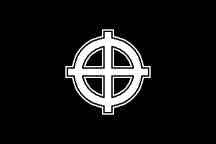 MAN Flag (Variant) |
National Action Movement (Portugal) Movimento de Acção Nacional The Movimento de Acção Nacional (MAN) was a "classical" European-type neo-Nazi style movement, which operated from 1986 to 1992. They used a white lined Celtic Cross (Sun Wheel) on black flag. Technically, this was not a party, but a neo-fascist movement connected with groups of "skinheads" and football supporters. After the murder of a black man in Lisbon by these skinheads, they where outlawed by court order because the Portuguese constitution prohibits organized movements that promote fascist ideology. |
||||||||||||||||||||||||||||||
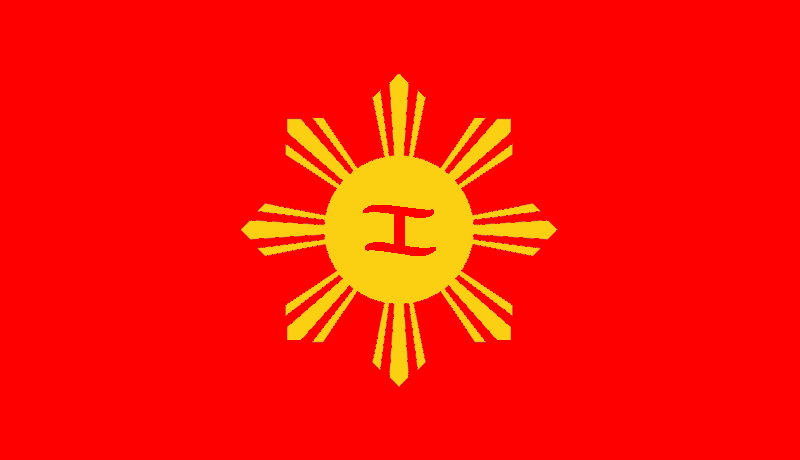 PNSF Flag 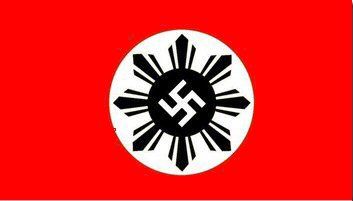 NDNMP Flag  PDF Flag 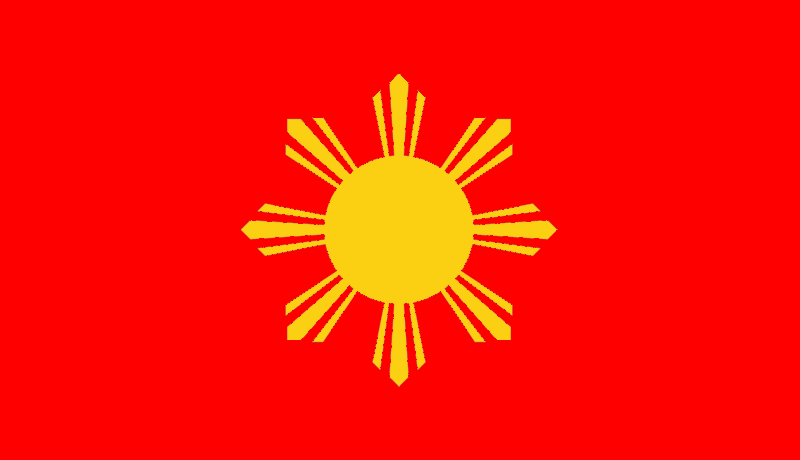 PFNF Flag |
National Socialist Party of the Philippines 1930 (Philippines) Partido Nacional Socialismo de Filipinas (PNSF) Nationalist Democratic Maharlikan Party 2009 Partido democrático nacionalista de Maharlikan (NDNMP) Right-wing Party of the Philippines 2010 Partido Derechista de Filipinas (PDF) National Fascist Party of the Philippines 2012 Partido Fascista Nacional de Filipinas (PFNF) 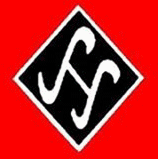 NDNMP Logo/Emblem There are a number of neo-Nazi and neo-Fascist web-based organizations, all hosted on Facebook, that seem to all be the work of a small group of persons or person. According to these closely affiliated and similar websites, they all support goals of "anti-communism, militarism, the abolition of democracy and its ideals, the abolition of the old system of corruption, a strong ultra-nationalistic fervor, glorification of the past, statism, and glorification of the nation." The term "maharlika" refers to a feudal peasent warrior class that once existed in the Philippines, but in modern Filipino the term has come to mean "royal nobility." and has been adopted by these Filipino extremist. The word maharlika was used during the Kilusang Bagong Lipunan (New Society Movement) of Philippine President Ferdinand Marcos to describe Filipino nationalism, incorrectly indicating that it referred to the ancient Filipino kings and princes. On their flags they claim that "red symbolizes the blood of the Filipino race, the blood which the fathers of our nation shed to attain freedom; the sun represents the eternal sunshine of the Philippines and its people which will last thousands of years; the eight rays of the sun represent our aims...and the eagle represents the might of the Philippines and its people." |
||||||||||||||||||||||||||||||
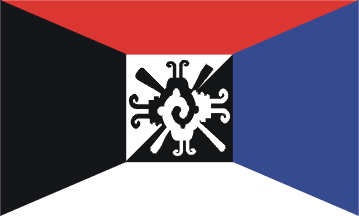 Mexica Movement Flag |
Indigenous Movement of the People of Anahuac Flag (Mexico)
As the self-proclaimed "revolutionary voice" of the indigenous people of Mexican descent, the Mexica Movement wants to unite North and Central America into the "Nation of Anahuac" whose rightful inhabitants are indigenous Native Americans. They advocate that all white Americans should return to their true homes in Europe, and leave the Americas to its original people. They view Latin Americans of Amerindian descent, Native Americans, and the Canadian First Nations as one people who are falsely divided by European-imposed borders. The black-and-white design in the center of their flag represents the Mayan depiction of duality (life and death, male and female, matter and spirit, etc.). The four colors of the flag represent both the four directions, and the two solstices and two equinoxes of the solar year, which all play an important part in all indigenous believes and religions. |
||||||||||||||||||||||||||||||
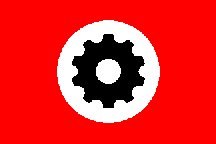 MNS Flag |
Hungarian Welfare Association (Hungary) Magyar Népjóléti Szövetség The Magyar Népjóléti Szövetség (MNS) is a neo-fascist movement. It is small, but they are visible at public demonstrations on national days or anniversaries linked to World War II. The Hungarian Welfare Association, which has appeared under various names and in different guises, adheres openly to the legacy of the Hungarian fascist Arrow Cross, or Cross Star movement, led during the World War II by Ferenc Szalasi. Various small groups, such as "Blood & Honour," are still active in organizing demonstrations on anniversaries linked to World War II and the legacy of Hungarian fascism. |
||||||||||||||||||||||||||||||
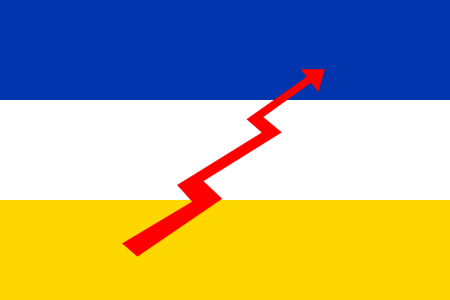 MNSC Flag |
National Socialist Movement of Chile (Chile) Movimiento Nacional Socialista de Chile (MNSC) The Movimiento Nacional Socialista de Chile (MNSC) was a political group started in 1932 and was active until 1938, which initially supported the ideas of Adolf Hitler, but later moved towards its own brand of fascism. Their flag used during this time was based on the first Chilean flag. The movement was first formed in 1932 by General Diaz Valderrama, Carlos Keller, and Jorge González von Marées, who became leader. The party received financial support from the German population of Chile and claimed a membership of 20,000 people. The movement stressed what it saw as the need for one party rule and solidarity between classes, and soon set up its own paramilitary wing, the Tropas Nacistas de Asalto. However, support for Hitler was abandoned in the late 1930s and anti-semitism was scaled back, with a more domestic form of fascism being offered publicly. |
||||||||||||||||||||||||||||||
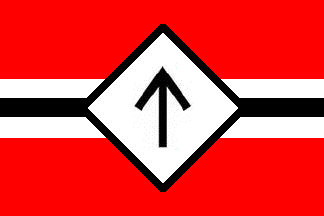 MNSVN Flag |
National Socialist Movement - National Vanguard Flag (Peru) Movimiento Nacional Socialista Vanguardia Nacional One of the newest neo-Nazi groups in Peru is the Movimiento Nacional Socialista Vanguardia Nacional (MNSVN) which was founded in 2010, with branches in Lima, La Libertad and Lambayeque. The National Vanguard uses a flag featuring a black arrow pointing upwards, said to be the "tyr" rune (tiwaz). The rune, shaped as a raised spear symbolizes power, resistance, determination and fighting spirit, according to the group. The flag, which is presented in the traditional National Socialists colors with red field, and white and black striped detailing, is reminiscent of one of the variants of the Hitlerjugend (Hitler Youth) House Flag, with the tyr rune replacing the swastika. |
||||||||||||||||||||||||||||||
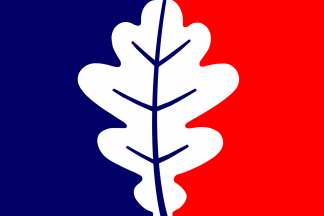 MNR Flag 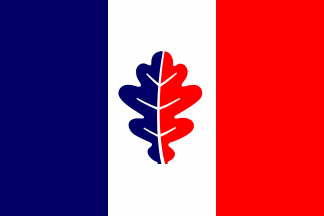 MNR Flag (unofficial variant) |
Republican National Movement (France) Mouvement national républicain The Republican National Movement (MNR) was founded by Bruno Mégret in 1999 as a splinter of the extreme-right party National Front (FN or front national). Although political observers have considered the MNR to be a far-right party, the MNR presents itself as classical liberal and nationalist. It opposes immigration, Islamisation, and the European Union, but, unlike the National Front, supports free markets and neoliberalism. The group uses the emblem an oak leaf, usually within a French tricolor flag. According to the party's website, "the oak leaf within the tricolor flag is the symbol of the struggle for our identity, of the attachment to our roots and of the continuity of our country. The oak symbolizes strength, nobleness and justice. In ancient Rome, the oak represented the civic virtues. It is shown in the arms of the [French] monarchy as well as in the arms of the Republic." The flag of the MNR is vertically divided blue-red with, in the middle a white oak leaf with blue veins. The supporters of the MNR sometimes use another flag, probably unofficial, made of the French national flag charged in the middle of the white stripe with a tricolor oak leaf not reaching the horizontal edges of the flag. |
||||||||||||||||||||||||||||||
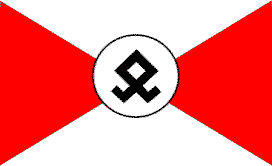 MNSDP Odal Rune Flag  Cross of Burgundy flag (Spanish historical) |
National Socialist Movement Awake Peru (Peru) Movimiento Nacional Socialista Despierta Perú (MNSDP) The Movimiento Nacional Socialista Despierta Perú (MNSDP) is a radical neo-Nazi group in Peru whose activities center around Cieneguilla according to the Peruvian police. Their motto of "Peru Awake" is obviously paraphrasing "Deutschland erwache!" (Germany awake!). The MNSDP formed what they called a super "creole" neo-Nazi group to celebrate Hitler's 119th birthday called the Peruvian National Socialist Union (UNSP - Unión Nacional Socialista Peruana) which briefly existed in 2008-2009. The National Socialist Movement Despierta, in the tradition of the original National Socialists German Workers Party, maintains a militant and lightly armed "Brown Brigade," complete with flags, brown uniform shirts, black ties, and red and white MNSDP arm bands with the "Odal Rune" logos prominently displayed on them. The Odal Rune is also widely used by right-wing nationalist youth groups like the "Wiking Jugend" in Germany and "Afrikaner Student Federation" in South Africa. The historical Spanish Cross of Burgundy has also been used by the MNSDP during their rallies. (The Cross of Burgundy was used as a military ensign in New Spain by Cortes and the Spanish Conquistadores in their conquest of the Mexico and later California.) |
||||||||||||||||||||||||||||||
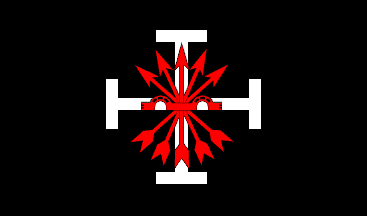 MNSPR Flag (2000-c2005) |
National Syndicalist Movement of Puerto Rico (Puerto Rico) Movimiento Nacional Sindicalista de Puerto Rico This movement was founded in 2000, as the refoundation of Falange Boricua. It never achieved any significant influence and seems not to have outlived the year 2005, since its website (existed 2004-2009) was not updated since then. The MNSPR flag was a combination of those of the Falange Boricua and the Nationalist Party of Puerto Rico: red yoke and arrows, outlined black and superimposed on white cross potent, all on black field. |
I agonized over these sections. Whether to ignore these flags and what they stand for, or include them was a tough decision. I feared including them would constitute legitimizing them, and certainly didn't want to do that. In the end I thought it important that they be identified for what they stood for, because many times they have been unknowingly displayed or incorrectly identified as historical by unsuspecting or uninformed individuals or flag companies.
These are flags that many times "migrate" from group to group, many of which rapidy appear and disappear as they change their names, and this makes identification even more difficult. Many of these groups were (and are very small) and don't exist any longer, but their flags continue to be used by other modern extremists. Unfortunately, there are a number of people who, like Ayn Rand's characters in "Atlas Shrugged," think there is something wrong in the world, that the world isn't following the right value system. As an alternative, they get into extremist politics like anarchism, environmentalism, neo-fascism, and radical traditionalism. The scary part is that this page only identifies a small portion of the Flags of Extremism being sold today. The sad truth be known, any flag or cultural symbol's true meaning can be used, then distorted and eventually destroyed by their misuse by these extremists groups.
Please be aware that in NO WAY does this site support the beliefs, policies, or philosophies of these organizations, nor encourage the displaying of these flags.
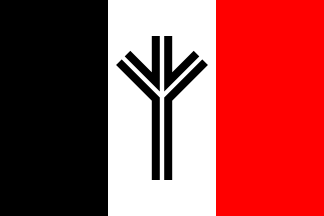 Original NA Flag 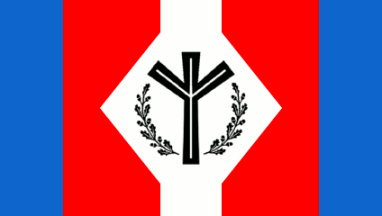 Variant NA Flag 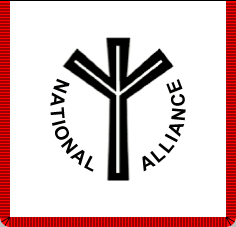 NA Vertical Banner (reported in California) |
National Alliance (USA)
The white separatist political organization National Alliance (NA) was once labeled as the United State's fastest-growing neo-Nazi group before the death of William Luther Pierce in 2002. The NA had been founded by Pierce in 1974, and was first headquartered in Hillsboro, West Virginia. At the time of his death in 2002 it ran a white power record label called Resistance Records and ran "Resistance Radio", a (now defunct) web radio station that streamed white power rock music across the Internet 24 hours a day and claimed 250,000 regular listeners in America (unverified). It also had a radio show, American Dissident Voices, heard on shortwave and streaming audio on the Internet. This group hoped to secure a white living space within North America, where "the physical and cultural presence of all non-whites has been removed." Constant power struggles after Pierce's death led to a steady decline of NA membership and in 2013, its end was officially announced. The original flag of the NA dating back to the 1970s was a black-white-red tricolor mirroring the Imperial German flag and the NSDAP colors. It also looks much like the flag used by the Volksfront, a group formed in Oregon in 1990s. (If there is a relationship between the two groups, other than their flag designs, it is unknown.) The last known NA flag had five vertical stripes of blue-red-white-red-blue, with a "life" rune surrounded by an oak wreath on a white diamond in the center. A point of interest is that the life-rune had been used during Nazi as part of the logo of German pharmacies and which after World War II was replaced by the snake and bowl symbol. A white banner was also used by the NA with the group name inscribed instead of an oak wreath surrounding the "life rune", all black on white field. The flag was square, hoisted vertically, and had red fringes which added a pseudo-Nazi look to the whole design. This banner was seen in a photo alleging to have been taken in Sacramento, California, in 2002 or earlier. |
||||||||||||||||||||||||
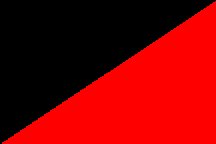 Nation Flag |
Nation (Belgium) Nation Nation is a French-speaking ultra-rightist movement, founded in 1999 in Wallonia and Brussels. They claim to be "the only French-speaking nationalist organization struggling in a credible way against the multiculturalist society." In 2000, they formed a youth branch called Jeune Nation (Young Nation). Nation has participated in demonstrations in Belgium and in other European countries in recent years, together with other like-minded European "nationalist" groups. Their flag has been identified as the flag of "national-anarchism" and it's use has spread. However, their actual political success has been limited. |
||||||||||||||||||||||||
 NBF Flag |
National Bolshevik Front (Russia)
National Bolshevik Front has been used as a name by three separate far-right groups in Russia. The name initially applied to the Russian National Bolshevik Party of Eduard Limonov when it was founded in 1992. Although the name was soon abandoned by the Russian group when it became active in politics, the term National Bolshevik Front is still used to refer to a loose federation of National Bolshevik organizations that spreads across much of Europe and South America. Of these, the most important is still in Russia. In 2006, the name was once again taken, this time by Alexei Golubovich for a new anti-Limonovist splinter group from the National Bolshevik Party that he led. This new group has links with former NBP member Aleksandr Dugin, and works closely with the Union of Eurasian Youth, a group of young supporters of Dugin's Neo-Eurasianism. |
||||||||||||||||||||||||
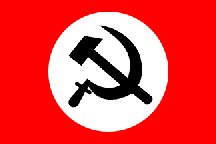 NBP Flag Type #1 (shown here in 2:3 size ratio) 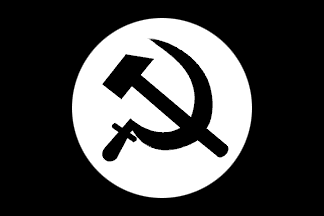 NBP Flag Type #2 (shown here in 2:3 size ratio) 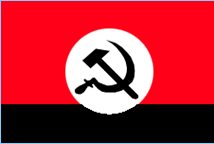 NBP Flag Type #3 City and region of Pskov (shown here in 2:3 size ratio) 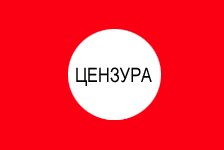 NBP Flag Type #4 The "Censored" Variant (shown here in 2:3 size ratio) 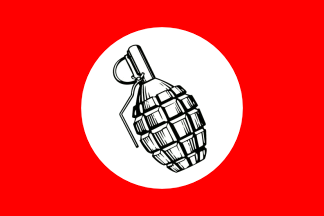 NBP Flag Type #5 The "Hand Grenade" Variant (shown here in 2:3 size ratio) 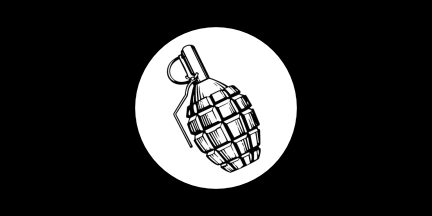 NBP Flag Type #5d The "Hand Grenade" Variant (shown here in 1:2 size ratio) 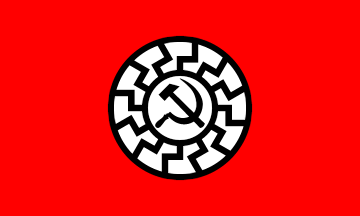 NBP Flag Type #6 The "BlackSun" Variant City and region of Volgograd (shown here in 2:3 size ratio) |
National Bolshevik Party (Russia) "Natsional-Bol’shevistskaya Partiya The Natsional-Bol’shevistskaya Partiya (NBP) has been led by Eduard Limonov since it was first founded in 1992 as "National Bolshevik Front." It was formed by the combining six smaller far-right Bolshevik groups. This newly formed National Bolshevik Party, also known as Nazbol, was dedicated to the ideology of National Bolshevism. Their platform called for a revolution and transforming Russia, enlarged with the parts of neighboring ex-USSR states which have significant Russian population, into a unitary state with the political and economic system similar to that of the former USSR, but with the highest state offices being reserved for ethnic Russians. Such a transformed state would spread its domination over most of the Eurasia, not unlike the Soviet domination in the Warsaw Pact and the Comecon. Since 2005, the party was barred from election registration and was completely outlawed in 2007.
In 2010, Eduard Limonov founded another neo-Bolshevik party, named "Other Russia," which replaced all of the National Bolshevik flags with a black-yellow-white horizontal tricolor, charged with the party name inscribed in black on the yellow field. It seems that not all the members of National Bolshevik Party have followed their leader into his new party and that some of them have formed a number of new organizations, which might have kept some or all of the old flags in use.
Their flag is based on the nazi scheme (red or black, with a centered white disk with a black symbol, but instead of the swastika there they use the sickle-and-hammer device. The flag is an interesting merging of two well-known and opposite symbols, which reflects the strange merging of the Bolshevik and Nazi doctrines. The flag (type #4) appeared after the red flag with black hammer and sickle was banned, the word "CENZURA" basically means "censored," and was later replaced with the black flags with hammer and sickle (Type #2).
Although red flag with black hammer and sickle on a white disc was banned in 2007, there still is a flag whose design contains all of these elements and combines them with the "Black Sun," an occult symbol which is occasionally used by the neo-Nazis, thus producing another flag in the series of vexillological oxymora which are so characheristic for the neo-Bolsheviks. This flag (Type #6) has a large white disc, edged with the outer ring of the "BlackSun," and a smaller disc, edged with the inner ring of the "BlackSun" and charged with black hammer and sickle, all on red field.
Another way of getting around the symbol banning ordinances has been a series of flags produced with hand grenades replacing the hammer and sickle symbol in the central white disk, although it hardly indicates a peaceful law abiding organization. Apparently, the war-like symbol has great appeal to the mentality of people who become members of these extremist groups and its not surprisingly these flags have appeared in a variety of sizes, ratios (with both black and red backgrounds), and seem to be becoming increasingly popular at NBP public rallies. Such flags were used in Russia as early as in 2002, and are very popular in various mirror party branches like those in Latvia and Lithuania. These flags, as well as some of the variants with the hammer and sickle, have also seen use by Eduard Limonov's new "Other Russia" party. |
||||||||||||||||||||||||
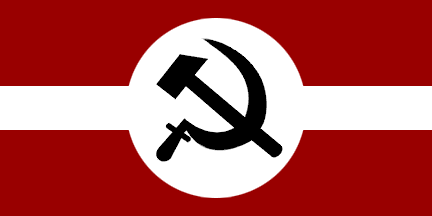 NBP-Latgalia Flag 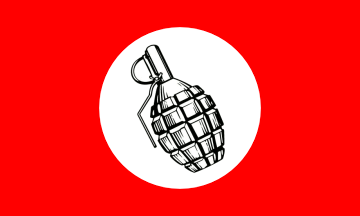 NBP-L Flag Type #1 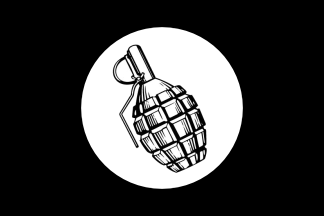 NBP-L Flag Type #2 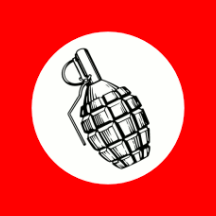 NBP-L Flag Type #3 |
National Bolshevik Party of Latvia (Latvia) Latvijas nacionalbolševiku partija (Latvian) Natsional-Bol’shevistskaya Partiya Latvii (Russian) The National Bolsheviks in Latvia (NazBols) are a very active, but small movement centered mostly around Latgalia. Latgalia is a province in the south-eastern part of Latvia. Historically, Latgalia has a political and cultural history very different from that of the rest of the Latvia, which were long under German-Swedish rule. Latgalia remained under Polish-Lithuanian rule until 1772, when it was ceded to the Russian Empire. Today, this part of Latvia is almost entirely inhabited by ethnic Russians. The leader of the Latvian National Bolsheviks is Vladimir Linderman (known by the nickname "Abel"), who states that he "protects the interests of the Russian-speaking population of Latvia, whose rights are violated in the former Soviet Republic every day." In 2002, Linderman fled to Russia for political asylum because the Latvian authorities blamed Linderman for an attempt on the life of President Vaira Vike-Freiberga. Since 2002, Linderman has been a member of the Central Committee of the National Bolshevik Party. In 2007, Linderman was one of the organizers of the Dissenters March and afterwards was deported from Russia to Latvia in 2008. He was accused of storing explosives and of calling for the overthrow of the political system. Later he was found innocent by Latvian courts of the charges, and in 2009, Linderman became the founder and leader of the "13th of January Movement." It is interesting to note, that Ayo Benes, one of leaders of the National Bolshevik Party of Latvia, is the son of an Ugandan immigrant and his Russian wife. This detail seems to reveal that the Latvian NazBols are generally not such racists as members of most of other groups from Russia and the ex-USSR.
In NBP of Latvia is active in most anti-capitalist demonstrations in Latvia and was involved with blockades against Soviet Socialist Veterans' Day Parades during Latvian Legion Day. In organization they follow the Russian National Bolshevik Party model. In all activities they either fly the Russian National Bolshevik Party flags (either red or black fields with a centered white ring with a black hammer and sickle inside), or the striped NBP-Latgalia variant. Some of the NazBols most favored demonstration flags have centered hand grenades on fields of red or black, although usually rectangular in shape, they have also used square shaped variants of the flags. Such square flags were seen in Riga in 2005 during protests against the visit of President George W. Bush to Latvia. |
||||||||||||||||||||||||
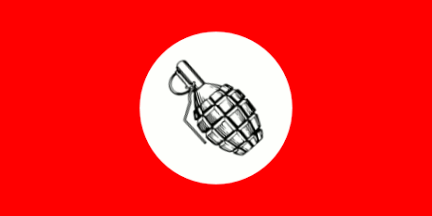 NBPL Flag |
National Bolshevik Party of Lithuania (Lithuania) Lietuvos nacionaline bolševiku partija (Lithuanian) Natsional-Bol’shevistskaya Partiya Litvy (Russian) The National Bolshevik Party of Lithuania uses the red flag charged with a hand grenade drawn in black and placed in center of a white disc. Such flags were seen in the city of Klaipeda during several protests against the closing down of Russian-language schools in 2006. Over 28% of the citizens of Klaipeda are Russians, which gives it the greatest Russian population in Lithuania, and it has the only Russian-language secondary school in the country. During these protests party activists also wore arm bands that repeated the flag pattern. The usual neo-Bolshevik flags and arm bands with the hammer and sickle are probably not in use at all in Lithuania because the symbol is legally banned. Due to the lack of any recent news, it is also questionable whether the party is still active. Not only is the Russian population in Lithuania much smaller than in other Baltic countries, but National Bolshevism seem to have never been very popular there, and apparently the Russian population in Lithuania usually prefers less extreme political options. |
||||||||||||||||||||||||
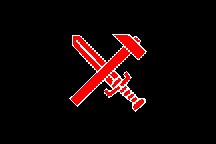 National Resistance Flag |
National Resistance (Germany) Nationaler Widerstand This flag is a symbol for the Nationaler Widerstand. It's not used by a particular party or organization, just for the whole action called "National Resistance." Recently, it has been used by organized Neo-Nazi groups in Germany, and it symbolizes national resistance. This flag actually predates the National Socialist Movement. The black flag (without hammer and sword) was the flag of a social protest movement of German farmers in the 1920s. The black flag with the red hammer and the red sword was first used by Otto Strasser, who was one of the leaders of the left wing of the NSDAP in the 1920s. It symbolized the unification of workers and soldiers. After World War II, Strasser reintroduced the black flag with the red hammer and sword as the flag of a short-lived new political movement that never gained any importance, however, in the 1970s and 1980s the flag was reintroduced by newer neo-Nazi movements. In the 1990s, it became a symbol of national revolution, and has remained in use since that time. |
||||||||||||||||||||||||
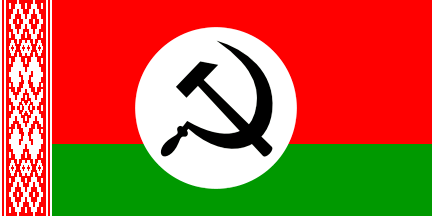 NBP-B Flag Type #1 (proposed) 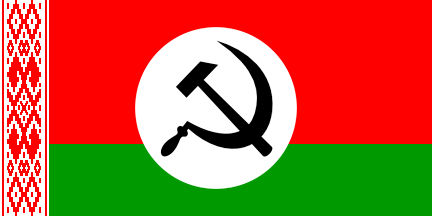 NBP-B Flag Type #2 (proposed) 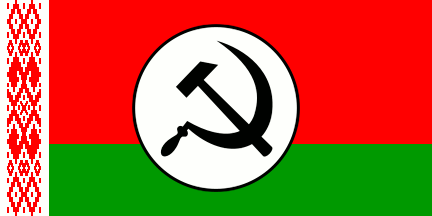 NNBP-B Flag Type #3 (proposed) |
National Bolshevik Party of Belarus (Belarus)
In Belarus, activities of the National Bolshevik Party are fairly minor, mainly vandalism, such as NBP emblems drawn on church walls and foreign embassies. Since they support stronger ties between Russia and Belarus, but also oppose current governments in both countries, they have become opponents to both the government and to most of Byelorussian opposition who mostly favor distancing themselves from Russia. The National Bolshevik Party is not even officially registered in the country. However, when Eduard Limonov founded another Russian party in 2010, named "Other Russia," the National Bolshevik Party in Belarus split into two groups. A faction seems to have transformed itself into the "Autonomous National Bolsheviks of Russia and Byelorussia" choosing not to follow Limonov's lead. Curiously, they seem to have switched to a black-yellow-white flag, which is also the basic design used by "Other Russia." Another group continues to call themselves the "National Bolshevik Party of Belarus" maintaining a separate website for themselves. Unfortunately, their new website generally shows no flags, although the hammer and sickle within a disc are used as the emblem on their graffiti, on their demonstration posters, and on the party T-shirts (usually red), as well as on the website pages header, where a red map of Belarus is charged with a black hammer and sickle within a white disc. This party seems to be maintaining good relations with the "Other Russia," which has held rallies in support of a Belarusian NazBol who was arrested in Moscow during demonstrations The National Bolshevik Party of Belarus normally used both the red and black fielded versions of the Russian National Bolshevik Party Flag, like all similar satellite party branches, but at one time had plans to use distinct Belarus Branch Flags which are shown here. The break-up of the party seem to have ended these plans. |
||||||||||||||||||||||||
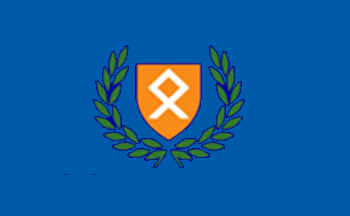 NC Flag - Type #1 (reported - undocumented) 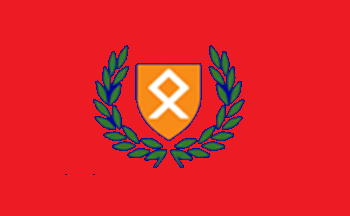 NC Flag - Type #2 (reported - undocumented) |
Nationalist Coalition (USA)
In 2006, the National Vanguard, itself a descendant of the National Alliance, underwent a split and a new white supremacist group, the Nationalist Coalition, was formed under the apparent leadership of Robert Jay Mathews and Todd Weingart. It is particularly active in Tampa and St. Petersburg (Florida), but has claimed membership as far west as Phoenix, Arizona. Professing to be "a new kind of white activism," its membership spread the usual racist and anti-Semitic propaganda in a variety of Florida towns and cities, have rented billboards promoting the group’s web site, and have distributed racist music CDs. They are convinced that "Jews control the media in America...and in nearly every European country of significant influence, including Great Britain and Russia." They claim the Supreme Court, which they label the "Jewish Supremacy Court," is also controlled by the Jews. Their goals seem to be building a national pro-White party whose platform would be to establish a White living space. This space will be completely free of all non-Whites. They also sponsor a radio program called Nationalist Matters "...to educate and enlighten our people - people of European descent." They have created an annual scholarship competition "...to reward that driven student who has demonstrated commitment to helping the White community." The two flags reported here are very speculative in nature and their actual use is yet to be verified or documented. The basic design places the movement´s "odal rune" emblem on a blue or red field, the colors favored by their parent organizations. |
||||||||||||||||||||||||
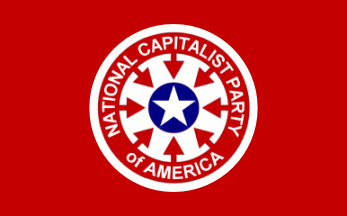 NCP Flag - Type #1 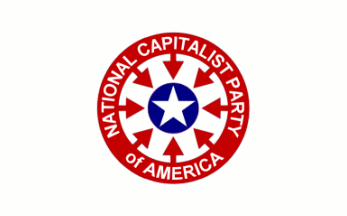 NCP Flag - Type #2 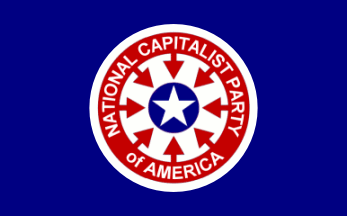 NCP Flag - Type #3 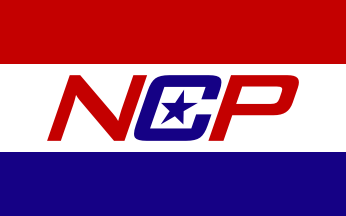 NCP Flag - Type #4 |
National Capitalist Party (USA) National Capitalist Party (NCP) was founded in 2008 by members of the Christian Falangist Party of America (CFPA), led by Patricio Cortes Bridges (a.k.a. Pat Bridges), founder and longtime National Director of the CFPA. The new party was meant to be the secular replacement of the old one, while most of the party goals remained the same. The NCP clearly did not have much success, because Bridges and part of his followers went to refound the CFPA as the Christian Phalange Organization in 2010, leaving the NCP to exist only via its website until late 2011, although the two organizations might have been originally intended to co-operate, for some of the NCP logos have been appearing at the Christian Phalange website since it was created. The NCP had previously tried to found a same-named Cuban party in exile, which seems to have died out even before its model. The main party flag has had three versions, with the field either in red, or white, or blue, and was charged with the main party logo in center. The logo was a white disc with red border, charged with what appears to be very similar to a 1942 military aircraft roundel in the center (a blue disc charged with a white star), and with eight white arrows emerging from the ring and pointing towards the central roundel; the ring was charged with the inscription "NATIONAL CAPITALIST PARTY of AMERICA", which might have been the official party name, although the territorial designation seems to have been rarely used, even in the logos. The roundel in center was meant to represent America herself, red border symbolized the blood shed in its defence, the arrows symbolized the cardinal and ordinal directions and therefore the unity of the country, while the complete red shape - ring with the arrows - was also meant to represent a wheel, symbolizing the progress and the Capitalism. On the flags with red or blue fields, the logo was surrounded with an additional white border. An Alternate party flag was a red-white-blue horizontal triband, with white field wider than the other two and charged with one of alternate party logos, which consisted of large oblique letters "NCP", letters "N" and "P" in red and letter "C" in blue; the letter "C" was enclosing an oblique blue five-pointed star. The typeface was almost identical to Bank Gothic in bold oblique form. Other logos, including a red-blue rhinoceros charged with three stars or letters "NCP" in white, clearly designed to resemble the Democratic donkey and Republican elephant, seem not to have been used on the flags. All these flags and logos might have been designed by party leader Pat Bridges, as seems to have been the case with those of his earlier and later political organizations. |
||||||||||||||||||||||||
 ND Flag |
National Democrats (Sweden) Nationaldemokraterna (ND) The National Democrats are a minor far-right nationalist party in Sweden, headquartered in Stockholm, and formed by a faction from the Sweden Democrats in 2001. The current party leader is Marc Abramsson. The party describes itself as a democratic nationalist and ethnopluralist party (ethnopluralism supports policies of forced regional ethnic and racial separatism). In General Elections the party has failed to receive anything near the 4% necessary for parliamentary representation, however, they do currently have representation in several city governments south of Stockholm. The ND supports a small newspaper called the Nationell Idag and is affiliated with both the Euronat and Alliance of European National Movements. In 2008, the party replaced its old logo (consisting of a blue and yellow sail) with an orange cloudberry flower. At demonstrations the ND uses a plain orange flag. |
||||||||||||||||||||||||
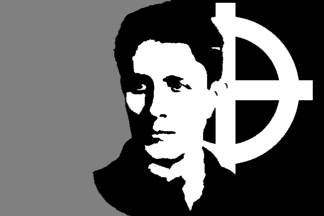 ND Flag Type #1 Corneliu Zelea Codreanu  ND Flag Type #2 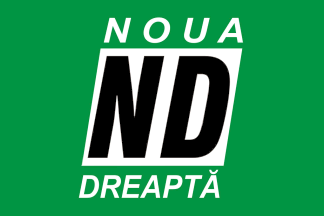 ND Flag Type #3 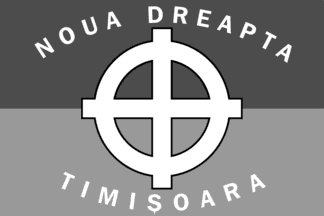 ND Flag Type #4 Timisoara branch |
New Right Party (Romania and Moldova) Noua Dreapta (ND) The New Right is a neo-fascist organization founded in 2000. It sees itself as successor to the Romanian fascist organization "Iron Guard" (Garda de Fier) led by Corneliu Zelea Codreanuo in the 1930s. The Noua Dreapta is an active member of the far-right European National Front, the coalition of neo-nazi political parties in Europe. The New Right's targets include sexual minorities, Catholics, abortion, communism, capitalism, globalization, the European Union, NATO, race-mixing, and all religious groups other than the Eastern Orthodox Church. As the Noua Dreapta reveres the historical leader of the Iron Guard, Corneliu Zelea Codreanu, they show a portrait of him together with the Celtic Cross on another flag Type #1.
ND Flag Type #2 with a black Celtic cross in centre of yellow field of the Romanian National Flag was used at a demonstration in Timisoara in 2011. The demonstration was held before the Consulate of Serbia as a protest against the "persecution" of ultra-rightists in that country. Apparently, a "football hooligan" was charged with the attempted murder of a policeman during riots which broke out at a national championship match and a group of those were charged with the murder of a French football fan before an international match in Belgrade. These are examples of ultra-rightists' attempts - unfortunately, often successful - of infiltration among the football (Soccer) fans with the ultimate goal of converting them to their ideology, typical not only in Romania and Serbia, but in other European countries as well. New Right Flag Type #3 uses the current logo of the ND, which is a white rhomboid charged with party initials in black and placed in centre of a larger green rhomboid, which also contains the party name inscribed in white above and below the central device. This logo is based on a common template used by other ultra-rightist movements which are the members of European National Front. This flag was used in Spain in 2011, at the celebration of 74th Anniversary of the Battle of Majadahonda, which was organized jointly by several Romanian and Spanish ultra-rightist parties, and also in Rome in 2011, during the celebration of anniversary of Nationalist victory in Spanish Civil War, which was organized by the National Association of Italian Fighters in Spain, with the participation of Spanish and Romanian ultra-rightists. The New Right was involved in these events as the self-designated successor of the Iron Guard, whose members fought in the Spanish Civil War on the Nationalist side, some of them having been killed at Majadahonda. The New Right Flag Type #4 is used by the New Right Timisoara Branch and ND Flag Types #5, #6, and #7, although generic extremist Celtic Cross flags, have also seen use by the Noua Dreapta at various demonstrations and rallies. |
||||||||||||||||||||||||
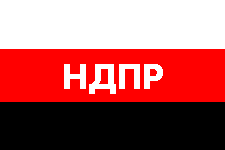 NDPR Flags 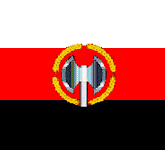 |
National Sovereignty Party of Russia (Russia) The National Sovereignty Party of Russia (NDPR), or National-State Party of Russia is a extremist Russian nationalist party established in 2002 under the leadership of Alexander Sevastyanov and Stanislav Terekhov. It is affiliated with the Russian National Movement, and the Movement Against Illegal Immigration (DPNI), Russian National Union (RONS) and other extremist nationalist organizations. The party leadership openly states "Our goal is power. We don't hide the fact that a party of nationalists will come to power. We should throw both democracy and Jews out of Russia." The NSPR is, perhaps, not neoNazi, but ultra-rightist extremist, for sure. Anti-Semitic and pro-Nazi sentiments are predominantly among the officers of the Russian army, Interior Ministry (police) and FSB. Among the 11,000 National-State Party members, 7,000 are acting or former officers. In 2002, the World Congress of Russian Jewry, published in the newspaper "The Jewish Word," accused the party of "inciting hatred of the peoples living in Russia, primarily the Jews." In response, representatives of the party filed a lawsuit for libel and demanded to recover from Berel Lazar 1.3 million rubles. In 2004, the court ordered Berel Lazar to apologize and pay damages of 100 rubles." In 2003, the Ministry of Justice of the Russian Federation issued a formal warning to the party of the inadmissibility of the implementation of extremist activities. In May of 2003, the NDPR was excluded from the unified state register of political parties. |
||||||||||||||||||||||||
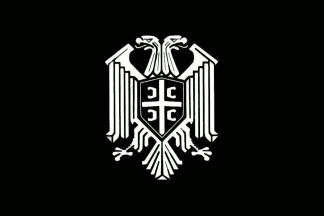 NF Flag |
National Formation (Serbia) Nacionalni stroj The National Formation was a Serbian neo-Nazi skinhead organization which gained nationwide attention in 2005 by physically assaulting participants of an anti-Fascist gathering at the Faculty of Philosophy in City of Novi Sad. Previously they had been responsible for racist and anti-Semitic graffiti in Belgrade, Novi Sad and other towns that glorified persons indicted before The Hague Tribunal. Their activities, included clashes with both participants and police at other anti-Nazi counter-rallies, and their blatant spreading of racist slogans at Serbian soccer matches, especial those aimed at players of African origin, resulted in fifteen NF members being arrested sentenced to prison in 2008. In 2011, the Constitutional Court of Serbia banned the NF completely, the first such case in Serbia. The leader of the NF was Goran Davidovic, nicknamed Führer, a history student from Novi Sad. In late 2008, many active members migrated to a new organization called the New Serbian Program (NSP) because of the police crackdowns. The flag of National Formation was black, charged with a simplified version of Serbian coat of arms in white. This emblem was copied from a banknote issued in 1942 by the puppet government which was installed in Serbia by German occupational forces. |
||||||||||||||||||||||||
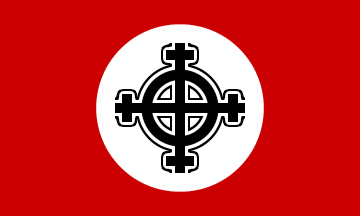 NFP Flag  NFP Flag Action Flag Type #1 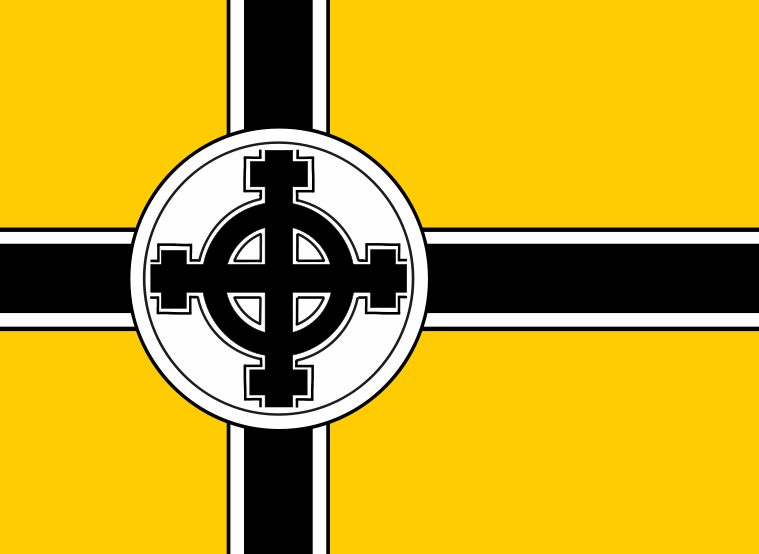 NFP Flag Action Flag Type #2 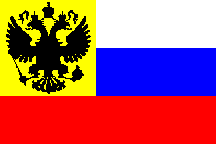 Imperial Russian State Flag 1914-1917 |
National Front Party (Russia)
These are flags used by a Russian neo-Nazi organization called the National Front. The National Front is led by Ilya Lazarenko. First formed in 1991 as the "Union of Russian Youth," then renamed the "Front of National-Revolutionary Action" in 1992, and finally named the "National Front Party" which it has remained since 1994. Its doctrine is racist and fascist envisioning a "Great National-Socialist Russian Empire" under a "national dictatorship," which explains their use of flags reminiscent of both Nazi Germany and Imperial Russia. When Lazarenko disbanded the FNRA in 1992, and founded the NFP, some of the members did not follow, but continued under the old name and it is assumed under old flag as well. The split was because some members insisted on following Orthodox Christianity in religious matters, while Lazarenko became follower of Russian neo-paganism and even formed a neo-pagan "church" together with the party. It is unclear what activities these that remained behind became involved with, or how long they lasted. The National Front Skinheads wear traditional black fascist uniforms and display their black Celtic crosses on their banners which they claim are based on the crosses of Novgorod and Jerusalem instead of the traditional swastika which is illegal in Russia. According to Lazarenko, his movement has contacts with the Russian National Unity (RNE) of Alexander Barkashov, but the relations are generally cool because they view the policy of the RNE as "absolutely erroneous."
At demonstrations the National Front Party has been seen displaying flags using the traditional neo-Nazi red and white, but also flags using the Romanov Imperial colors (such as the Front of National-Revolutionary Action Flags - Type #1, Type #2, Type #3, and Type #4), and even re-purposing and using the last Russian Imperial State Flag of 1914. It should be noted that the Front of National-Revolutionary Action Flag Type #4 has been reported as being used as a variant of the Front of National-Revolutionary Action Flag Type #3, but not well documented in photographs. |
||||||||||||||||||||||||
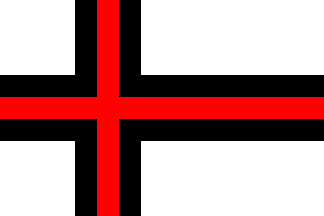 NKORP Flag |
National Corporativism (Czech Republic) Na'rodni' korporativismus The neo-Nazi National Corporativism (NKORP) was founded in 2004. Its policies were mixture of nationalism, neo-Fascism and neo-Nazism doctrune. The membership base overlapped with other extreme right-wing groups, so it formed a kind of bridge between a legal political party the "Workers’ Party" and the openly neo-Nazi "National Resistance." National Corporativism was gradually consumed by internal conflicts and in 2008 was shut down, and its leaders encouraged supporters to join the Workers’ Party. Its flag was charged with a narrow red off-centred "Scandinavian" cross, with wide black borders, on white field. The general design not only employs the usual Nazi colors, but also vaguely resembles the Imperial German War Ensign. |
||||||||||||||||||||||||
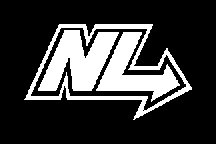 NL Flag |
National List Party (Germany) Nationale Liste (NL) In 1989, various far-right neo-Nazis from Hamburg, led by Christian Worch and Thomas Wulf, founded the Nationale Liste (NL). The National List used this black flag with white inscription "NL" at their rallies and meetings. During the 5½ years of its existance the National List published a magazine that contained a list of names and addresses of left-wing and anti-fascist activists and organizations which led to attacks on some of the people listed. In 1995, the NL was banned and its membership disappeared into other German extremist groups. |
||||||||||||||||||||||||
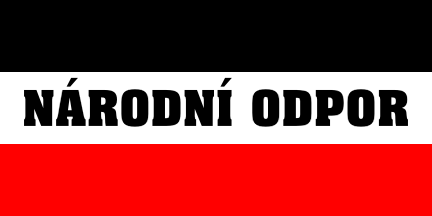 NO Flag 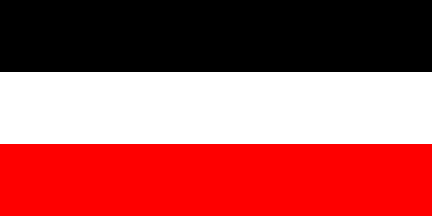 NO Flag (alternate flag) |
National Resistance (Czech Republic) Na'rodni' odpor Praha The National Resistance Prague (NO) was a short lived National Socialist group formed under the leadership of Filip Vavra and Jan Brcak in late 1998 who tried to organize public demonstrations against such things as broadcasting Radio Free Europe to Iran and Iraq, and free speech issues. In August of 1999, they organized a demonstration to pay tribute to the memory of Rudolf Hess, who they called the "last victim of World War II." In October of 1999, although NO announced a demonstration at Arbesovo Square in Prague, their action was banned by authorities, and they joined a demonstration at Vitkov organized by the "Vlastenecka Fronta" (Patriotic Front) and the "Narodni Aliance" (National Alliance) instead. The demonstration ended mostly in chaos and with a small clash with police. The old National Socialist elite of the "Bohemia Hammer Skins" and "Blood & Honour" don't recognize NO and encounters between the groups often end with physical conflicts. The NO flag was a black-white-red horizontal tricolor charged with the their name inscribed in black on the white field. The plain flag (without the inscription), was also used so frequently that it may be considered an alternate flag of the organization. |
||||||||||||||||||||||||
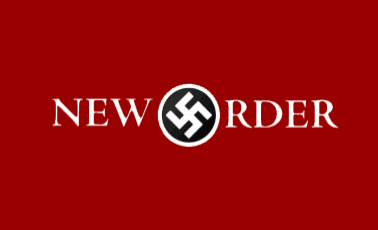 NO Flag (questionable) |
New Order (USA)
The New Order, founded by Matt Koehl in 1983, was the continuation of both the American Nazi Party (ANP) and the National Socialist White People's Party (NSWPP). It began when Koehl, George Lincoln Rockwell´s immediate successor, sold the ANP's real estate holdings in Virginia, and moved the NO headquarters to New Berlin, Wisconsin. Today the NO claims that they are not a neo-Nazi political party, but rather a religious order which holds the memory of Hitler "in trust until such time when whites are ready to accept National Socialism as the only possible way to ensure Aryan racial and spiritual survival." The undocumented flag shown here appears to be the NO logo placed on a red field. |
||||||||||||||||||||||||
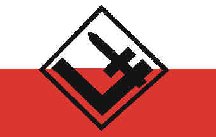 NOP Flag 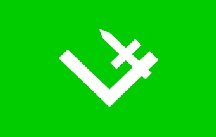 NOP Green Variant |
National Rebirth of Poland (Poland) Narodowe Odrodzenie Polski (NOP) The Narodowe Odrodzenie Polski (NOP) is a minor far-right, extremist nationalist political party in Poland. It is a member of European National Front. The NOP registered as a political party in 1992. It claims to be the reincarnation of National Radical Camp, the pre-war nationalist youth organization, which was banned in 1934. 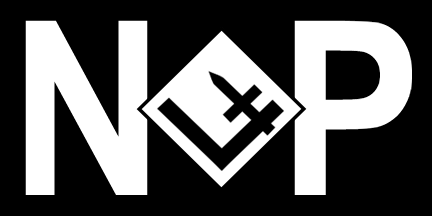 National Rebirth of Poland Variant In 2001, NOP membership in Poland was estimated at 500, consisting mainly of neo-Nazi skinheads. In 2006, it received only 0.6% of the popular vote in regional elections. |
||||||||||||||||||||||||
 NPD Flag 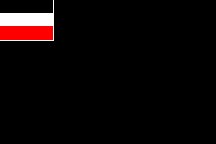 NPD Flag (Variant) 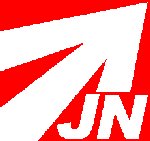 Young National Democrats Flag |
National Democratic Party of Germany (Germany) Nationaldemokratische Partei Deutschlands (NPD) The neo-Nazi Nationaldemokratische Partei Deutschlands (NPD) was formed in the early 1960s when several right-wing parties merged and was rather successful in the elections during the 1960s, but lost most of its support in the early 1970s. The NPD was founded in 1964 and has about 6,000 members making it the third largest right-extremist party in Germany. In 1969, it formed an youth organization called the Junge Nationaldemokraten (JN), or "Young National Democrats."
The German Imperial Flags are prominently displayed by the NPD. These Imperial flags are displayed at party conventions and during demonstrations. NPD demonstrators wave different versions of these black-white-red flags. There are other modern variants of black-white-red that are produced by flag makers for right extremists and used by them. Because of this, not only are flags from the Third Reich banned, but many from the Second Reich era are now becoming banned, most notably the Imperial Naval Ensign and the Imperial War Ensign shown above. |
||||||||||||||||||||||||
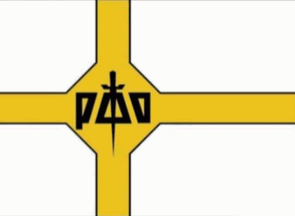 NPF Flag |
National Patriotic Front (Russia)
The National Patriotic Front, a splinter group from the Pamyat (Memory) Union, is a Russian ultra-nationalist organization sometimes identifying itself as the "People's National-Patriotic Orthodox Christian Movement." It has been accused of racism, xenophobia, and antisemitism. The groups most well-known leader, Dmitry Vassilyev (who died in 2003), made the Pamyat Union the most prominent organized group of Russian nationalists in the 1980s. After several splits and name changes, and the imminent dissolution of the USSR, the organization launched its own newspaper "The Pamyat" in 1991, with print runs of 100,000 copies, and started their own radio station. However, by the end of the 1990s, the original Pamyat had disappeared being replaced with smaller groups with names like "The National Patriotic Front" and "The Russian National Unity." The Russian National Unity promoted the cult of the swastika, a symbol which, they claimed acts on subconsciousness and paralyses, weakens and demoralizes non-believers." |
||||||||||||||||||||||||
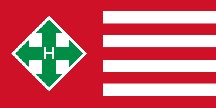 NPHM Flag 1935-1945 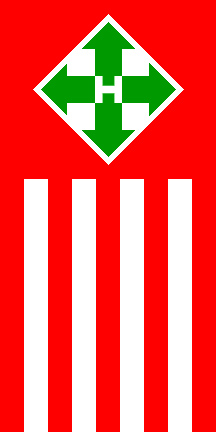 NPHM Vertical Banner |
Hungarian Arrow Cross Party (Hungary) Nyilaskeresztes Part-Hungarista Mozgalom The Arrow Cross, or Cross Star, was a symbol used by the Arrow Cross Party and Nyilaskeresztes Part-Hungarista Mozgalom (NPHM), a national socialist pro-Nazi party led by Ferenc Szálasi, which ruled Hungary from October of 1944 to January of 1945. During the short rule, ten to fifteen thousand Jews were murdered outright, and 80,000 Jews were deported from Hungary to the Auschwitz concentration camp. After the war, Szálasi and other Arrow Cross leaders were tried as war criminals by Hungarian courts. Some Arrow Cross officials, including Szálasi himself, were executed. However, many Arrow Cross supporters were never prosecuted, and it is rumored that some may have found a new home supporting the Stalinist Rákosi regime.
The ideology of the Arrow Cross has resurfaced occasionally in recent years, the Neo-Fascist Hungarian Welfare Association being an example, however, it is very much a fringe element of modern Hungarian politics. Today, you will still see the Hungarian Arrow and Cross symbol used by non-Hungarian White Supremacist groups (see the Nationalist Movement below) and it is still used by some modern Hungarian neo-Nazi skinheads. |
||||||||||||||||||||||||
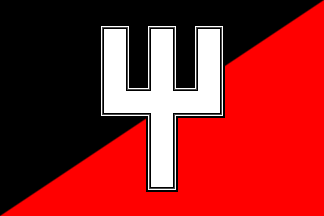 NR Flag |
Nation and Revolution (Spain) Nacio'n and Revolucio'n The Nacio'n and Revolucio'n (NR) is one of many small ultra-rightist political parties now existing in Spain. Nation and Revolution first appeared in the general elections in 2008 using a flag diagonally divided in black and red, with a white trident outlined (fimbriated) in black and white in the center. The trident symbol, although certainly not an excusive far-right symbol, has sometimes been used in various recognizable forms by other far-right groups in both Spain and Europe. A very similar example would be the current flag used by the Neo-Solidarist Alternative Movement in Belgium. |
||||||||||||||||||||||||
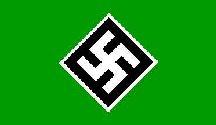 NSARL Flag |
National Socialist Animal Rights League (USA)
A disturbing development that has emerged in some animal and environmental activist circles is the use of Holocaust imagery to promote their causes. This strange flag is being sold as an Nazi Animal Rights League flag. Neo-nazi groups have also frequented animal rights demonstrations in an attempt to capitalize upon the tension and controversy generated by the issue. Many of them claim to subscribe to Adolf Hitler's original doctrine of a vegetarian, chemically untainted agrarian society in which vivisection is outlawed. |
||||||||||||||||||||||||
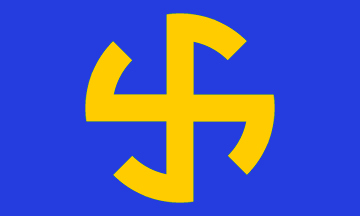 NSB (Sweden) Flag |
National Socialist Bloc (Sweden) Nationalsocialistiska Blocket The National Socialist Bloc (NSB) was founded in 1933, but it never managed to achieve a large support and gradually vanished in early 1940's. The Party leaders were Colonel Martin Ekström and Count Eric von Rosen. The party used a blue flag charged with a yellow curved swastika. The color shades were those of the Swedish national flag at the time. The same swastika was also used as the NSB party emblem on their publications and posters. The flag was probably created by Eric von Rosen, himself, who used the swastika as a personal logo and also promoted its use in neighboring Finland. He is also credited for creating the original Finnish Air Force roundel with a blue swastika on a white disc. |
||||||||||||||||||||||||
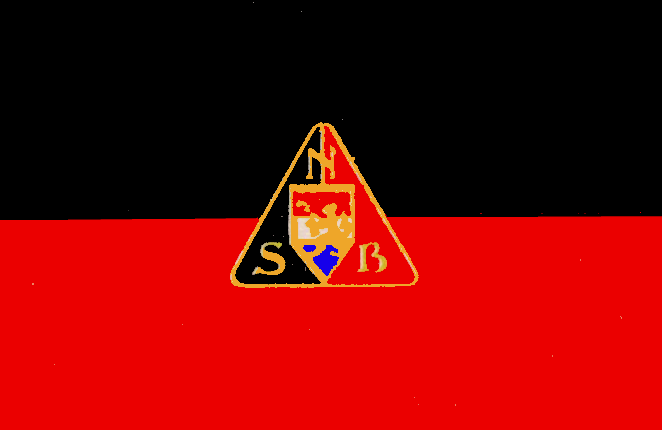 NSB (The Netherlands) Flag 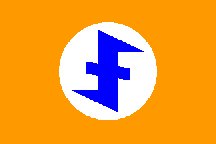 NSB Party Flag (Type #2) |
National Socialist Movement in the Netherlands (Netherlands) Nationaal-Socialistische Beweging in Nederland (NSB) The Nationaal-Socialistische Beweging in Nederland (NSB) was a Dutch fascist and later national socialist political party. In 1941, it absorbed the other Dutch Nazi parties (like the NSNAP) and became the only one. The NSB wanted to unite the Netherlands and Flanders into a single German controlled country called "Dietsland." The NSB was the only legal party in the Netherlands during most of the Second World War. The founder and leader of the "National Socialist Movement in the Netherlands" was Anton Mussert. The party based its program on Italian fascism and German National Socialism, however unlike the latter before 1936 the party was not anti-semitic and even had Jewish members. Beginning in the summer of 1943, many male members of the NSB were organized in the Landwacht, which helped the government control the population. In September of 1944, most of the NSB's leadership fled to Germany and the party's organization fell apart. After the German signing of surrender in 1945, the NSB was outlawed and many members of the NSB were arrested and convicted, including Mussert, who was executed in 1946. After the NSB was founded in 1931, one of their flags used the colors of the Dutch tricolor (the field was orange, with on a white disc and the blue rune sign of the wolfsangel [wolf hook] centered on it), and the other was a black-red horizontal bicolor charged with a triangular-shaped emblem featuring a red-white-blue shield with the Lion of Flanders centered upon it and surrounded by the party initials of "NSB." |
||||||||||||||||||||||||
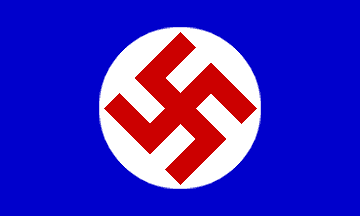 NSCP Flag 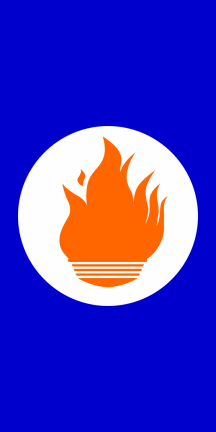 NUPC Vertical Banner |
National Socialist Christian Party (Canada) Parti National Social Chrétien (PNSC) The National Socialist Christian Party (NSCP), founded in Quebec, used a blue flag charged with a red swastika in a white disk between 1933 and 1938. Adrien Arcand (died 1967), the would be "fuehrer" of Canada, led various National Socialist movements during his lifetime, and he and his followers used a variety of similar flag designs over the years. The party platform supported anti-semitism, the doctrines of Adolf Hitler, and teachings of Nazism. Arcand's party eventually joined with other Canadian far-rightist groups to form the Parti unité socialiste nationale canadienne (Canadian National Socialist Unity Party), or more commonly known as the Parti de l'Unité nationale du Canada (National Unity Party of Canada or NUPC). 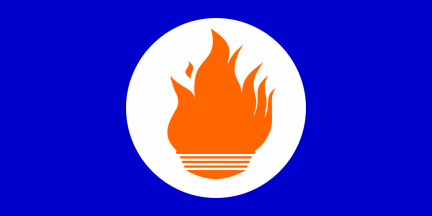 Canadian National Socialist Unity Party The National Unity Party of Canada, sometimes referred to as the 'Blue Shirts' after their paramilitary uniforms, commonly attacked immigrants, minorities and leftist groups. Although the NUPC boasted that it would seize national power in Canada, it had little support outside of Quebec, British Columbia, and Alberta. During World War II the party was banned under the War Measures Act, and Arcand and many of his followers were arrested and detained for the duration of the war. The NUPC still exists today and Arcand's disciples still lurk on the extreme right wing of Canadian society. Their original flag (and arm band) featured a red swastika in a white disk on a blue banner patterned after the German Nazi banner. Their later flags substituted an orange torch issuing from a striped bowl for the original swastika symbol. Their logo, not used on a flag, also featured the orange torch, but it is bordered by maple leaves and topped by a beaver in profile. |
||||||||||||||||||||||||
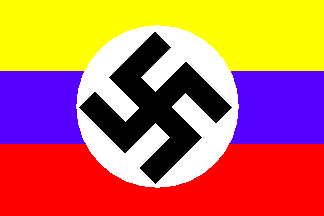 NSE Flag |
Ecuadorian National Socialism (Ecuador) Nacional Socialismo Ecuatoriano The National Socialism Ecuatoriano (NSE) is a neo-Nazi, racist, right-wing conservative group in Ecuador with possible ties to the Legión Blanca (White Legion), a shadowy right-wing organization in Ecuador that is responsible for numerous death threats since 2001 to politicians, human rights workers and left-wing activists in the country. In addition, the group claimed responsibility for a March 2003 arson attack on the Ecuadorian Congress building which caused a large amount of damage, but no casualties. No arrests were ever made in the arson. Further, the White Legion has not claimed responsibility for any attacks since the March 2003 arson, and reports of death threats from the group have all but ended since October of that year. |
||||||||||||||||||||||||
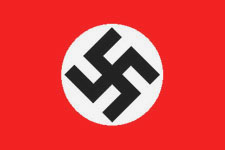 Original NSDAP Flag |
National Socialist German Workers Party (Germany) Nationalsozialistische Deutsche Arbeiterpartei (NSDAP) The Nationalsozialistische Deutsche Arbeiterpartei (NSDAP), commonly known in English as the Nazi Party, was a political party in Germany between 1919 and 1945. It was known as the Deutsche Arbeiterpartei (German Workers' Party - DAP) before the name was changed in 1920. The party policies included dictatorial powers for the party leadership, fanatical nationalism, and racial hatred. Nazi sponsored death camps resulted in over 12 million deaths. The party's last leader was Adolf Hitler. Neo-Nazis groups around the world have created many variations on the flags of Nazi Germany over the years, often because Nazi flags themselves are banned in a number of countries. Some variations involve modifying the swastika to some degree, while others replace the swastika with an alternate white supremacist symbol such as various runes used in Nazi Germany. |
||||||||||||||||||||||||
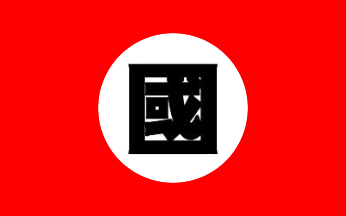 NSP-J Flag On their Nazi-like flag the symbol of the swastika was replaced with the Japanese character of kuni (country). |
National-Socialist Party of Greater Japan 1934-1937 (Japan) Dai Nippon Kokka Shakai Tou In 1932, Katsumaro Akamatsu founded the Japanese National-Socialist Party (Nippon Kokka Shakai Tou), which was merged into the National-Socialist Party of Greater Japan (Dai Nippon Kokka Shakai Tou) under the leadership of Junjuro Ishikawa in 1934. Ishikawa was the author of the book "Research on Hitler's Mein Kampf," which glorified the Nazi doctrine. Their general platform was typically racist, and against both the capitalism and communism of their time. However, the use of the term national socialism, in Japan, is difficult because it never remained a truly independent political philosophy, but instead became a collection of elitist, conservative and quasi-fascist ideals which were used by the Japanese political leadership for their own purposes. In 1936, young Japanese military officers influenced by their Japanese National Socialist leader Ikki Kita, attacked the Prime Minister's residence, and other governmental offices, killing the Minister of Finance, the Ministry of Home Affairs, the Superintendent General of Military Education, and other officials. They purposed to establish a National Socialist military regime to reform the state, instead, Kita was captured, sentenced to death, and executed in 1937, thus effectively ending this early national socialist movement. |
||||||||||||||||||||||||
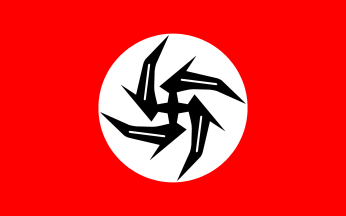 NSJWP Flag 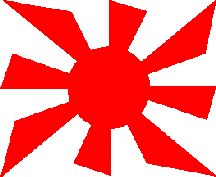 National Socialist Movement |
National Socialist Japanese Workers and Welfare Party (Japan) Nationalsozialistische Japanische Arbeiterpartei (NSJAP) The Nationalsozialistische Japanische Arbeiterpartei (NSJAP) is a far-right Japanese political party that campaigns on a platform of National Socialism. Founded in 1982, the party is also known as "New Axis Party." The party celebrates the empire of Japan and its alliance with the Third Reich. The party believes in a return to the Shogun system as an indigenous take on National Socialist principles of leadership. It is virulently anti-Semitic, and believes in an international Jewish conspiracy employing Freemasonry to control Japan. Today, it is known as the National Socialist Movement, and it is not a significant force in Japanese politics. The New Axis Flag uses a pinwheel type of swastika which is a variation on that used by many racists organizations and individuals. The National Socialist Japanese Workers and Welfare Party also has been known to use a variant of the old Tohokai Party Flag.
|
||||||||||||||||||||||||
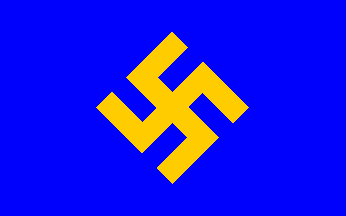 NSF 1994 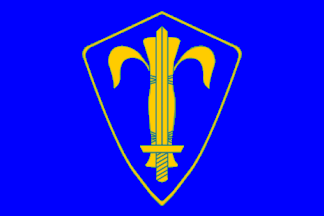 NSF 2006 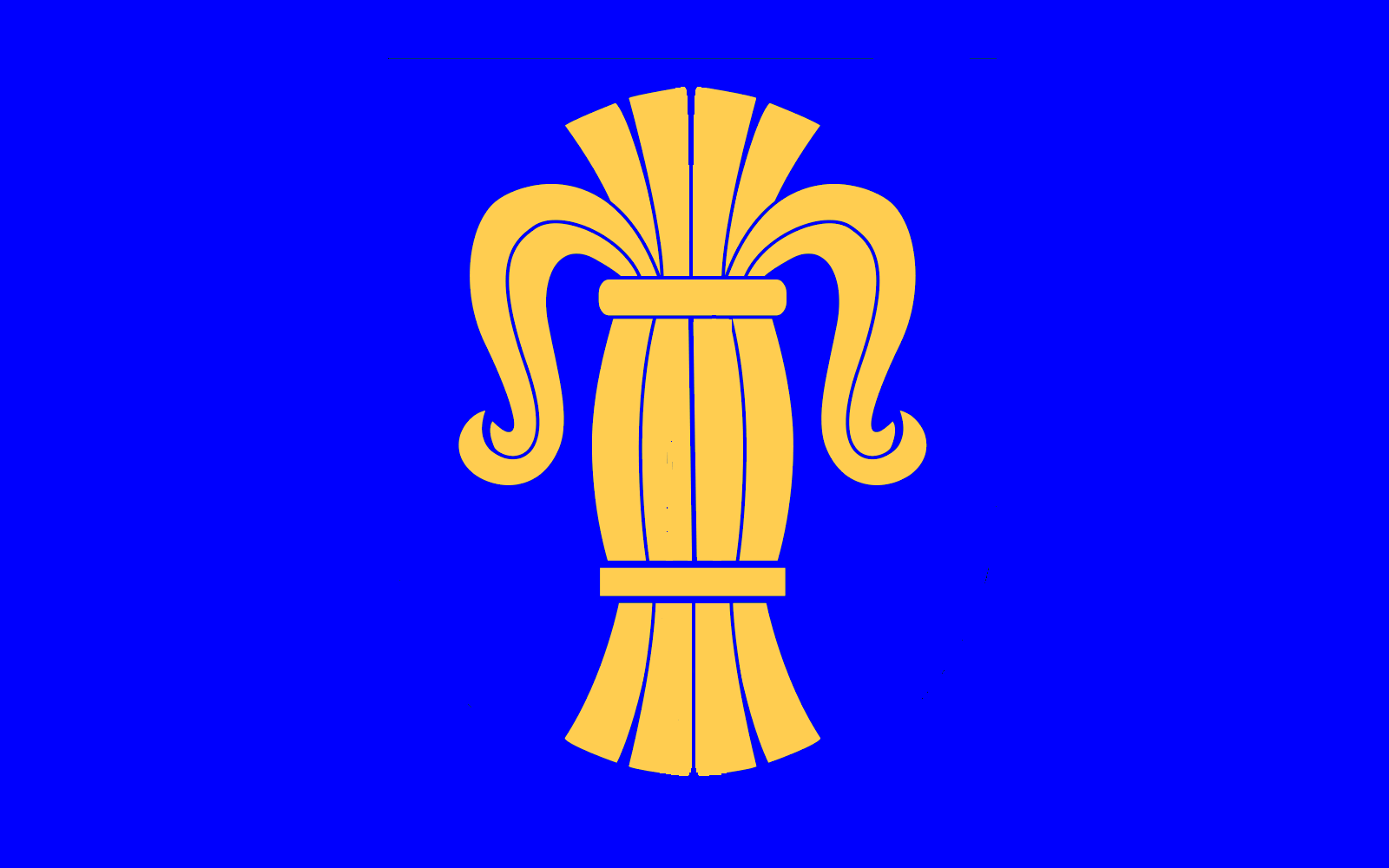 NSF 2008 (image not accurate) |
National Socialist Front 1994-2008 (Sweden) Nationalsocialistisk Front (NSF) The Nationalsocialistisk Front (NSF) was a Swedish neo-nazi political party. The organization was founded in 1994 in Karlskrona. On the birthday of Adolf Hitler, April 20, 1999, the NSF became a registered political party. In 2008, at the time of its dissolving, the NSF was the largest Neo-Nazi political party in Sweden. A new party was founded to replace it, the People's Front (Folkfronten) with the same people in charge. The party had as its main goals the abolition of democracy, the repatriation of immigrants, the implementation of scientific racism and cutting taxes for families with many genetically healthy children. The NSF traced its heritage back to a World War II era National Socialist party. The original World War II NSF flag had a red swastika on a gold circle on a blue flag. In the NSF's new reincarnation the red swastika was changed to gold. During political demonstrations the members wore a black combat shirt, black military-cap, boots, khaki-coloured combat pants, and wore the party's logo on a arm band. This uniform was outlawed by the police in 2006, it was considered a hate crime just to wear them during demonstrations. After that the members of the party often wore a simple blue t-shirt with the gold letters "NSF" on them. The swastika was replaced on their flag with a shield, charged with an upright sword superimposed on a stylized wheat sheaf. The sheaf emblem, originally the symbol of Vasa royal dynasty, was and still is used by many other Swedish ultra-rightist groups." In 2008, a new variant of the "wheat sheaf" flag was seen used by the National Socialist Front in their last demonstrations in Karlskrona before they disbanded and metamorphosed themselves into the People's Front. This new variant featured an enlarged "wheat sheaf" symbol and the removal of the inner sword and the outer shield outline. |
||||||||||||||||||||||||
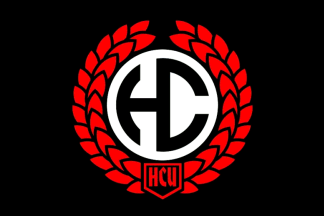 NSI Flag Type #1 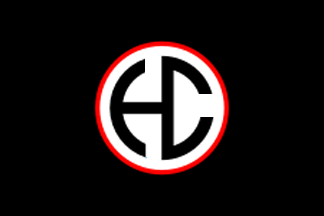 NSI Flag Type #2 |
National Socialist Initiative 2009 (Russia) Natsional'naya Sotsialisticheskaya Initsiativa The ultra-right National Socialist Initiative (NSI) was formed in St. Petersburg in 2009 by Dmitri Bobrov, nicknamed Shul'ts, but since then has spread to other locations such as the city of Cherepovets. Bobrov was originally the leader of an informal group of Nazi skinheads called Shul'ts-88, which were active in St Petersburg and the Leningrad Region (2001-2007) before the police suppressed them. Bobrov himself was arrested in December of 2005 and sentenced to six years in jail on a conviction of violence as the leader of the Schulz 88, but was released in 2009. After that, he founded the National Socialist Initiative. In 2010, the National Socialist Initiative Group in the City of Cherepovets, in the Vologda region, was deemed extremist by the Vologda City Court in May of 2010. The NSI appeared first in the city in the beginning of 2010 as a regional branch of the movement of St. Petersburg. The group, following the lead of Dmitry Bobrov, has taken part in mass brawls and committed violent crimes. Recently, the NSI has attempted to join public, non-nationalist actions organized by other movements, with the goal of bursting onto the field of public politics by demonstrating that a "unified nationalist front" exists that supports the concept of "Russia for the Russians." The sunwheel-like device used in the center of the NSI flag is based on the Cyrillic monogram "NS." The abbreviation "NSI" appears on small shield in bottom part of the whole device on flag type #1. The initials of the National Socialist Initiative (NSI) are the same in Russian and English. |
||||||||||||||||||||||||
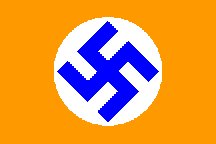 NSNAP Party Flag |
National Socialist Dutch Workers Party (Netherlands) Nationaal-Socialistische Nederlandsche Arbeiderspartij (NSNAP) The Nationaal-Socialistische Nederlandsche Arbeiderspartij (NSNAP) was a minor Dutch national socialist party founded in 1931 and led by Ernst Herman van Rappard. Seeking to copy the fascism of others, notably Adolf Hitler, the group failed to achieve success and was accused by rivals of being too moderate for a fascist movement. It was absorbed by the more aggressive NSB in 1941. The group looked to the National Socialist German Workers Party for its inspiration, setting up its own Storm Trooper battalion in imitation of the Sturmabteilung and its own Holland Youth like the Hitler Youth. The NSNAP sought full incorporation of the Netherlands into the Third Reich. |
||||||||||||||||||||||||
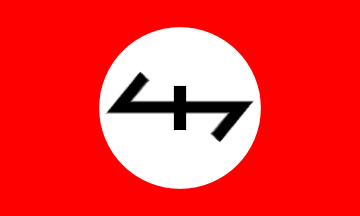 NSM88 Flag |
National Socialist Movement - Russian Division (Russia) Natsional-sotsialisticheskoye Dvizheniye-Russkiy Divizion Other than this flag of the "National Socialist Movement - Russian Division," little else is known, which indicates a very small organization. They did have a website, all in Russian, and were affiliated with the National Socialist Movement (USA). The Russian Division used this red flag with a large white disc, charged with a variant of the wolfsangel symbol in black. The image of this flag could be seen at the movement website which, as mentioned, is no longer available online. We suspect the movement probably disbanded itself, the members leaving to join other similar organizations, of which, there seem to be no shortage of presently in Russia. |
||||||||||||||||||||||||
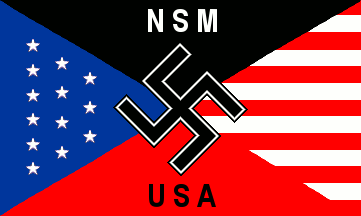 NSM Flag with Text 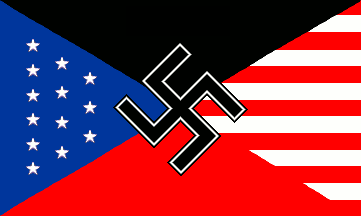 NSM Flag without Text |
National Socialist Movement Flag (USA)
The National Socialist Movement (NSM) is currently one of the largest neo-Nazi group in the United States. The NSM promotes its anti-Semitic and racist ideology at rallies throughout the country, particularly in the Midwest, and through the group's website, internet-based radio programs, white power music companies and video games. Members wear Nazi uniforms and openly display swastikas to a degree unusual even among white supremacists. Prior to the introduction of a special flag for the NSM, the group commonly used the traditional National Socialist German Workers Party (NSDAP) flag. However, with the adoption of the name "National Socialist Movement" its leaders apparently felt a new and unique "Americanized" flag was necessary. There seems to be two variants of this new National Socialist Movement Flag in use. The most common variant has the letters "NSM" above the swastika on the black background area and "USA" below it on the red background area. However, a variant also has seen use without the lettering. It was reported in use in Leith, North Dakota, where the NSM was trying to establish a "white homeland". |
||||||||||||||||||||||||
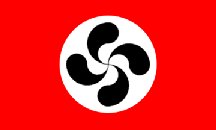 MNSE Flag Fictitious Flag 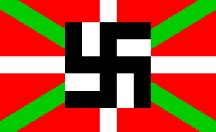 Swastika National Socialist Flag Fictitious Flag |
National Socialist Movement of the Basque Country (Spain) Movimiento Nacionalsocialista de Euskalherria A series of flags were posted on websites to apparently bring into disrepute legiment Basque nationalists movements by attempting to connect them to the Nazi National Socialist movement. The Basque National Socialist Party of the Basque Country doesn't exist. The Lauburu symbol is, however, among the traditional symbols used by the Basque people. The non-existant Movimiento Nacionalsocialista de Euskalherria (National Socialist Movement of the Basque Country) claimed this flag, that uses the Lauburu in lieu of the Nazi swastika, as their flag. They called it the "lauburu o esvástica vasca" (Lauburu or Basque swastika), and say it represents their National Socialist movement in Spain. Other fictitious flags claiming to be the flags of the National-Socialist Movement of the Basque Country have also been placed on the internet. As far as can be determined none of these flags or a National Socialist Party actually exists in the Basque Country.
The "arrano beltza" (black eagle) is also usually shown on Basque independentist flags, but has nothing to do with the National Socialist Movement. |
||||||||||||||||||||||||
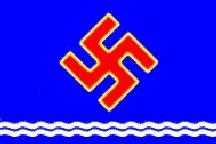 NSPC Flag |
National Socialist Party of Canada (Canada)
The National-Socialist Party of Canada (NSPC) is a small neo-Nazi group that claims to "support Canada as an independent and indesoluable nation of white citizens sovereign in its own living space." They hope "to implement what they call the "Seven Points of National Socialism" in Canada and to implement a proposed National Socialist Constitution for Canada. The NSPC was founded in 2006, is organized in secret semi-autonomous cells, but claims 250 members. Terrence Cecil Tremaine is the NSPC founder and national director. They admit to being a racialist organization, and claim that many of their members are also active in Stormfront-Canada. Their flag shows a red swastika rising over ocean waves, which they claim represents the "radiant Sun of National-Socialism" rising over the "Ocean of the People" bringing energy, light, idealism and racial health. |
||||||||||||||||||||||||
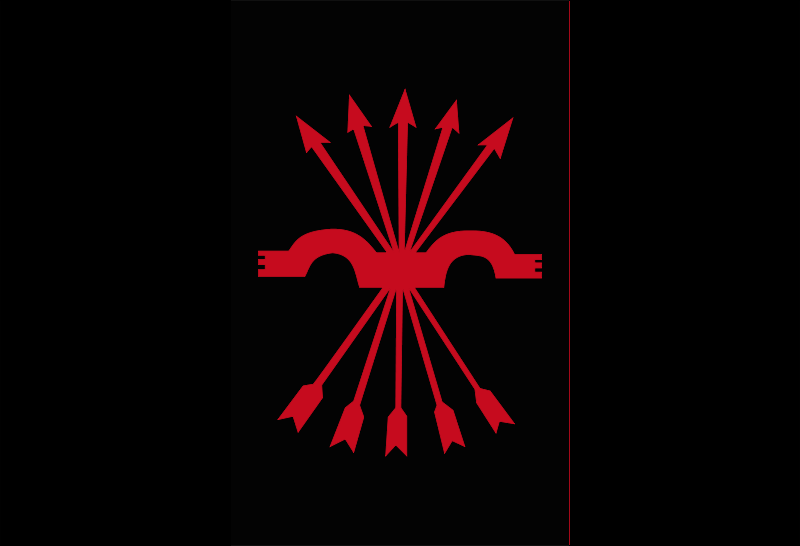 NSAFP Flag |
National Syndical American Falangist Party Flag (USA)
The National Syndical American Falangist Party (NSAFP), also called simply "The American Falange," was founded in 1985, seemed to share most of the beliefs of the original Spanish Falangist (Fascist) Party, although some of the party's beliefs, like the right of every citizen to own "fully automatic assault weapons" could only have been born in America. The Falangists believed in the power of the worker, but also had strong bias against Muslims and homosexuals. The NSAFP disbanded in 2000, but their website is kept up for "historical purposes," and many of their former members went on to join the Christian Falangist Party of America. (Note: The flag of the Venezuelan Phalanx is almost identical to that of the NSAFP.) |
||||||||||||||||||||||||
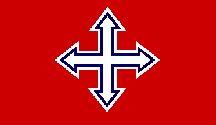 NSM Flag |
Nationalist Movement Flag (USA)
The Nationalist Movement is a Mississippi-based, white supremacist organization that advocates what it calls a "pro-majority" position. It has been called white supremacist by the Associated Press and Anti-Defamation League, among others. Its leader is Richard Barrett and its Secretary is Barry Hackney. Its activities include its Warrior-Training Camp, Unixandria Library, the Crosstar website, Prisoner Pen-Pal Club, "All The Way" newspaper, Free-Tip news-service, Crosstar Forum, Airlink television-studios and Nationalist Legal-Defense Fund. The symbol of the movement is called the "Crosstar," which originated in Hungary. |
||||||||||||||||||||||||
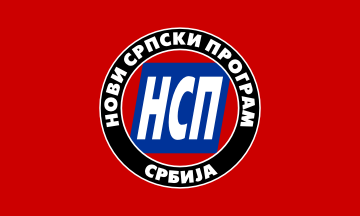 NSP Flag |
The New Serbian Program (Serbia) Novi srpski program The New Serbian Program was founded in June of 2008 as an attempt to establish a legal ultra-rightist organization in Serbia. Successfully registered, it was meant to be a legal cover for the activities of the National Formation (NF), which was under legal sanctions at the time. Although NF leader Goran Davidovic, and many of his closest followers, joined the NSP, it engaged in less violent actives than its direct predecessor in its attempts to appear more legitimate. In 2010, an internal conflict over a member who, according to the NSP website, "betrayed his race" by having a close relationship with a "non-Aryan" looking woman (photographed together at a music festival), divided the membership to such an extent, that the NSP was disbanded. The flag of NSP was red with the emblem in center, consisting of white Cyrillic initials NSP on a blue rhomboid which is surrounded, and partly covered, with a black ring fimbriated white and charged with names of the organization and the country, also in white. |
||||||||||||||||||||||||
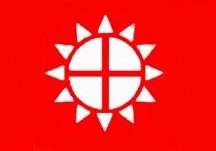 NPC Flag (unverified) |
Nationalist Party of Canada (Canada)
The Nationalist Party of Canada (NPC) is a white supremacist political party that was founded by Don Andrews in 1977 in Toronto. The goal of the party is "the promotion and maintenance of European Heritage and Culture in Canada." The Nationalist Party evolved from another white supremacist organization, the Western Guard, as a result of Andrews being legally barred from the Western Guard. From 1977 to 1985, the party published the "Nationalist Report," which ceased publication when Don Andrews and Party Secretary Robert Smith were both charged and convicted under the Criminal Code of Canada for promoting hatred. Still based in Toronto, the NPC continues to further its goals through supporting such projects as European Heritage Week, a shortwave radio program, and running for office in local elections. Don Andrews has run for Mayor of Toronto several times, including in 2003 when he won 0.17% of the vote. In that year, two other party members ran unsuccessfully for the Toronto City Council. |
||||||||||||||||||||||||
 NBPP Flag |
New Black Panther Party (USA) The New Black Panther Party (NBPP), whose formal name is the New Black Panther Party for Self-Defense, is a black political organization founded in Dallas, Texas, in 1989. Despite its name, NBPP does not appear to be an official successor to the original Black Panther Party. Both the Anti-Defamation League and the Southern Poverty Law Center have classified the New Black Panthers as a hate group.
The New Black Panther Party commonly makes use of the red-black-green tricolor flag of the Black Liberation Movement of the 1920s. The flag was also used by the original Black Panther's Party during the 1960s. See the "Black Liberation Flag" on "Modern American Protest and Message Flags" page for more information on the original flag. |
||||||||||||||||||||||||
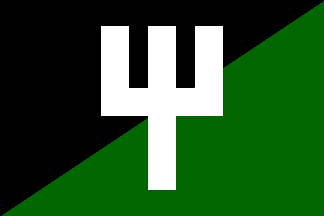 N-SA Flag |
Neo-Solidarist Alternative Movement (Belgium) Nieuw-Solidaristisch Alternatief (N-SA) The Nieuw-Solidaristisch Alternatief (N-SA) is an ultra-rightist movement founded on the model of the German NPD, aiming at attracting the various Flemish ultra-rightist movements currently not represented in the Parliament. The leader of the party, Edouard Hermy, has a long political history linked to the Flemish extreme-rightist movements. In 1999, he was expelled from the ultra-nationalist party Vlaams Blok (VB) for his extreme racist beliefs. Since that time a number of members of the VB have left it, deeming it "not radical enough," to join the N-SA. The leaders of the VB have not actually forbidden their members to join N-SA, but have advised them not to do it. |
||||||||||||||||||||||||
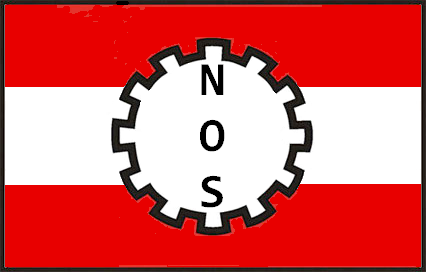 NOS Flags 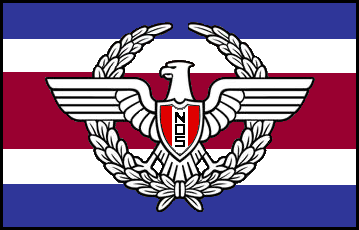 |
New Social Order Flag (Costa Rica) Nuevo Orden Social (NOS) The Nuevo Orden Social (NOS) is a self proclaimed militant group of Costa Rican working and middle class socialists whose aims are "...to preserve and restore the essence of the nationalist spirit in our country, erected in practical example of our socialism ideas" and are "opposed to the current political system which has been ruling to us for decades with its familiar pathological corruption and incompetence." According to the New Social Order the red color on their flag represents all those who have died for Costa Rica, the white represents the peace which they feel has been gradually lost. The gear-shaped Social Symbol stands for work and progress. They claim the "New Eagle" on the second flag, with its New Order "Social Shield," protects and enforces the peace and freedom of the Costa Ricans by remaining vigilant to any threat. The new Eagle was placed on the Costa Rican national flag to represent the New Order's aspiration to forge in Costa Rica a small, but great empire, a homeland of respect, order, discipline and socialist values. The New Order remains an extremely nationalistic movement whose goal is to overthrow the current government and see themselves as the leaders of a future Costa Rican empire. |
||||||||||||||||||||||||
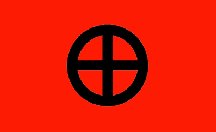 NRP Flag (Sun Wheel variant) |
Nordic Reich Party Flag (Sweden) Nordiska rikspartiet (NRP) The Nordiska rikspartiet (NRP) is a Neo-Nazi political party in Sweden, founded in 1956 as the Sveriges nationalsocialistiska kampförbund (National Socialist Struggle League of Sweden) by Göran Assar Oredsson. Oredsson was the also the party leader except for a few years during the 1970s when he wrote his autobiography "Prisat vare allt som gjort mig hårdare" ("Blessed be everything that has made me harder"). During that time, his wife Vera Oredsson took on the role as party leader and became Sweden's first woman who ever been a party leader. In 1973, NRP ran for the Swedish parliament but only obtained a few hundred votes. |
||||||||||||||||||||||||
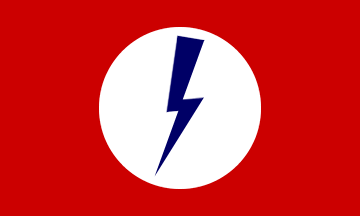 NRP Flag 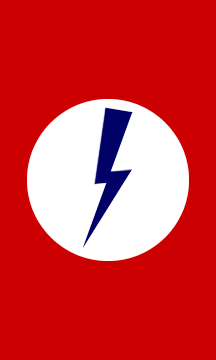 NRP Flag (vertical variant) |
National Renaissance Party 1949-c1980 (USA)
In 1949, the National Renaissance Party was founded in Yorkville, a part of New York City, and soon was under the control of a fanatical public accountant named James Hartung Madole. The original party membership seems to have transferred from older nationalist groups such as the Christian Front, German-American Bund, Citizens Protective League, and the Nationalist Action League. The NRP activities remained fairly localized to the New York City area, though occasionally reaching out to the Reading and Philadelphia areas of Pennsylvania. The NRP communicated its beliefs through a party publication named the National Renaissance Bulletin, which was edited by Fred Weiss. The NRP party membership was normally about 50 and never exceeded 200. In 1953, the party added a uniformed "Elite Guard" (EG) to its organization under the leadership of Matt Koehl and Hans Schmidt. The Elite Guard members wore black pants and gray shirts, with a red lightning bolt armband (blue bolt on white circle). Normally, the EG had only about fifteen or twenty active members. In the 1960s and 1970s the party seems to have became occult oriented and involved in mysticism; developing ties with Anton LaVey and the Church of Satan. Madole died of cancer in 1979, and the party disbanded soon after. The NRP used as a symbol a thunderbolt. Their flag, as well as their armbands, had a solid-red field with a blue thunderbolt on a white circle. The flags existed in both horizontal and vertical formats. |
||||||||||||||||||||||||
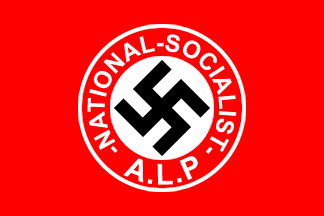 NSALP Flag |
National Socialist American Labor Party (USA)
The National Socialist American Labor Party split off from the National Socialist Movement of America. They describe themselves as "an orthodox National Socialist Political Party designed to move National Socialism into the active political process." They claimed to demand "commitment and devotion to the principals of the National Socialist American Labor Party and to the National Socialist World View as set forth by Adolf Hitler." The NSALP flag was a simple red flag with the party's logo centered on it. |
||||||||||||||||||||||||
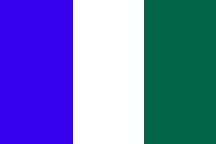 NWHL Flag |
Northwest Homeland (Northwestern Front) Flag (USA)
This is the flag of a very small far-right group calling themselves the Northwest Homeland. They are also known as the Northwest Migration project, and more recently the Northwestern Front. They want all pure white people to migrate to the Pacific Northwest of the United States. They do this to resist what they call "ethnic cleansing," encourage their members to obtain firearms and learn to use them, and feel that within a century white people will become extinct worldwide unless they consolidate in the Pacific Northwest homeland. This flag is a good example of how harmful racial meanings can be hidden in fairly harmless looking flags that can be displayed openly without causing comment. Most uninformed people would not notice this tricolored flag, or read anything sinister into it. |
||||||||||||||||||||||||
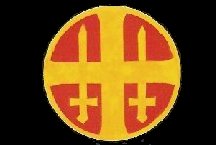 NS Rikshird Flag 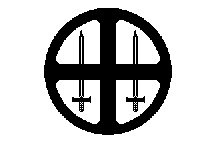 NS Rikshird Flag (black & white variant) |
Norwegian National Union Party (Norway) Nasjonal Samling In the same year that Adolf Hitler came to power in Germany (1933), Vidkun Abraham Lauritz Quisling formed the Nasjonal Samling, or National Union (Unity) Party in Norway. This party was styled after the German National Socialists under Hitler, and after the Germans invaded Norway became the only Norwegian party to be supported the Germans. Quisling assumed power as the new leader of Norway. The Hird, or Rikshird, was a Norwegian form of the German SA or Storm Troopers. A loose translation of the ancient Norse hird would be "national or state follower." This black flag with a gold and red sun cross with upward pointing swords upon the two horizontal branches of the sun cross, was used by Rikshird collaboration forces during World War II, and is also in use today as a Neo-nazi symbol. During the German occupation, each regiment in the Rikshird that used a flag would also have a specific emblem or the location of the regiment on the upper right quarter of the flag. |
||||||||||||||||||||||||
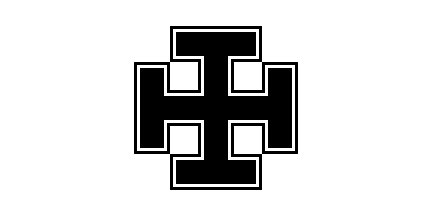 NNP Flag |
People's National Party (Russia) Narodnaya Natsional’naya Partiya (NNP) The Narodnaya Natsional’naya Partiya (NNP) is a small far-right neo-Nazi political party. Their ideology, called Russism, is a "localized" form of Nazism that believes in the creation of an all-white Russia, and eventually a Russian-led white Europe. Its leader is Aleksandr Ivanov-Sukharevsky, who founded the party in 1994, and racist skinhead leader Semyon Tokmakov has served as deputy leader of the party. The party flag is white with a large black cross in the center (two swastikas, one right-facing and one left-facing). The People's National Party consists largely of white power skinhead youths, whose members wear a white shirt with a black armband bearing their black cross. |
||||||||||||||||||||||||
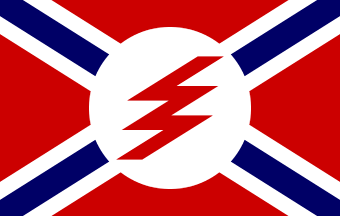 NSRP Flag |
National States Rights Party 1958-1987 (USA)
The National States´ Rights Party was a far right, white supremacist party that was founded in 1958 in Knoxville, Tennessee. The party preached antisemitism, racism and opposed the American civil rights movement. The national chairman of the party was J. B. Stoner, who served three years in prison for bombing a Baptist Church in Birmingham, Alabama. The party produced a newspaper, The Thunderbolt, which was edited by Edward Reed Fields, and claimed a circulation of 15,000 in the late 1960s. The party began wearing Nazi inspired party uniforms with white shirts, black pants and tie, and an arm band bearing a red thunderbolt version of the Wolfsangel. They were soon connected to bombings, violence, and inciting riots. In the 1980s the Federal Bureau of Investigation labeled the NSRP as a hate organization, and by 1987 it had ceased to exist altogether. Although the NSRP flags varied slightly since most of them were hand-made, the flag design was clearly based on that of the Confederate Naval Jack, but the saltire was narrower and its borders were wider. The white Confederate stars were removed and the white disc charged with a red thunderbolt was added. |
||||||||||||||||||||||||
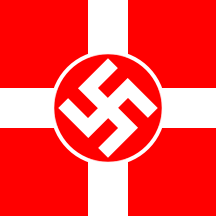 NSSAP Flag c.1933-1938 (also used by NSSB) 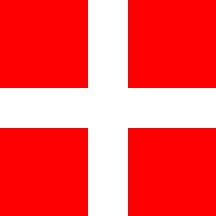 SNF Flag 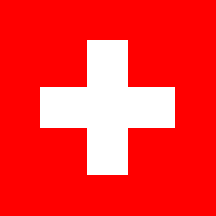 Swiss National Flag |
National Socialist Swiss Workers' Party (Switzerland) Nationalsozialistische Schweizerische Arbeiterpartei (NSSAP) National Socialist Swiss Workers' Party is one of the Front Movement (Frontenbewegung) parties. It was founded in 1933 as the People's League (Volksbund) by the breakaway members of National Front under the leadership of Major Ernst Leonhardt, to be renamed in 1935, which was followed by Leonhardt's dismissal from the Army same year due to his Nazi attitudes. In 1938, party was forbidden to hold the rallies and publish its newspaper. Shortly afterwards, Leonhardt disbanded the party and replaced it same year with the Swiss Society of the Friends of Authoritarian Democracy (Schweizerische Gesellschaft der Freunde einer autoritären Demokratie). In late 1939, after a campaign against the Swiss government, followed by a series of trials of his party members, Leonhardt fled to Germany and Swiss Society of Friends of Authoritarian Democracy was banned in 1940 due to its subversive activities. In 1944, Leonhardt was sentenced to prison in absentia and was killed in Germany next year in an air raid. The flag of the National Socialist Swiss Workers Party is derived from that of the Swiss National Front (SNF), by superimposing a red disk charged with a white swastika and fimbriated white. It s use was made illegal in 1938, when the Swiss government banned the use of "non-Swiss" political symbols by Swiss political parties, which was primarily aimed at the use of swastika. National Socialist Swiss League (Switzerland)Nationalsozialistischer Schweizerbund (NSSB) National Socialist Swiss League was founded in 1941 by Franz Burri, a Nazi activist. Most of its members were Swiss people living in Germany, although it operated in Switzerland as well. This group was dissolved in June same year, after a number of Swiss Nazi activists were arrested and a number of others, including Burri, fled to Germany, continuing their activities from there, mainly calling for another Anschluss - that of Switzerland. After the war, Burri returned to Switzerland, where he was sentenced to 20 years imprisonment in 1948 for speaking against the independence of the country, but was freed in 1959 and lived until 1987. While only circular badges of National Socialist Swiss League are currently known which repeat the same general design, it is possible that the National Socialist Swiss League reused the flag of the National Socialist Swiss Workers' Party, knowing that Ernst Leonhardt assisted in its founding and took part in its activities. |
||||||||||||||||||||||||
 NSWP Flag - Type #1 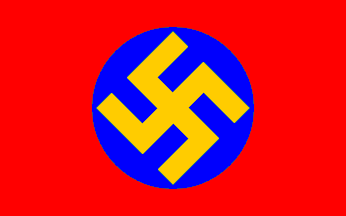 NSWP Flag - Type #2 |
National Socialist Workers Party 1933-1950 (Sweden)
National Socialist Workers Party was formed in 1933 as the breakaway group from the Swedish National Socialist Party (SNSP). Its leader Sven Olov Lindholm was originally the second-in-command in the SNSP. The party differed from other Swedish Nazi parties by insisting on anti-Capitalist nature of its ideology, which led to them being labelled as Strasserites (left-wing Nazis), especially after their name was changed to Swedish Socialist Coalition (Svensk Socialistisk Samling) in 1938 and use of swastika was abandoned along with most references to Nazism. The party, once a leading ultra-rightist group in Sweden, lost most of the support during the World War II, to be eventually disbanded in 1950. Along with the blue flag (Type #1) charged with gold swastika, the party also used a red flag (Type #2) charged with gold swastika on blue disk. The Blue Type #1 would be adopted by the National Socialist Front (Nationalsocialistisk - NSF) in the 1990s. The Red fielded variant (Type #2) was originally used by the Swedish National Socialist Party (Svenska Nationalsocialistiska Partiet). The use of both flags ceased with the NSWP renaming in 1938 and abandoning of swastika in favor of stylized wheat sheaf , originally the symbol of Vasa royal dynasty, which was already previously used in combination with swastika as one of the party emblems. (see the National Socialist Front 1994-2008 - NSF 2006 for an example) |
||||||||||||||||||||||||
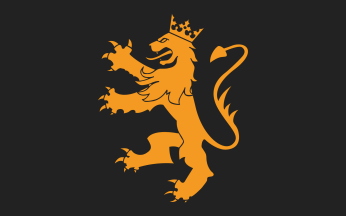 Current NU Flag 2013 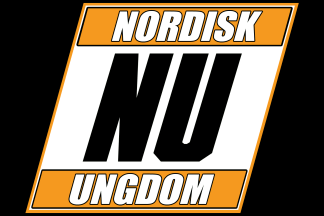 Old NU Flag |
Nordic Youth (Sweden) Nordisk Ungdom The Nordic Youth was founded in 2010 by former members on National Democratic Youth (Nationaldemokratisk Ungdom), the youth wing of the far-right party National Democrats (Nationaldemokraterna). Its name had already been used by the youth wing of the National Socialist Workers Party/Swedish Socialist Coalition (1933-1950), but the two organizations are otherwise unrelated. Nordic Youth describes itself as an ethnopluralist movement claiming that it is not a white racist group and co-operates with radical Islamists as well, finding the common ground with these in the anti-Zionism and support for a free Palestine and claiming that it is "a good thing to work with groups who want to live according to their own culture, religion and tradition". The current flag of Nordic Youth is black, charged with a crowned rampant lion in orange. Its first use was in 2013 at the Independence March in Warsaw, a yearly demonstration organized by Polish ultra-rightists. Lions appear on the coats-of-arms of all three Scandinavian countries, although this one mostly resembles the one from the Swedish coat of arms, which is in accordance with their insistence on both the Swedish nationalism and the Scandinavism, the latter being further emphasized by the use of a "Scandinavian" flag with red cross on yellow field, originally introduced sometime between 1979 and 1985 and attributed to the Union of Kalmar, the entity which grouped the whole Scandinavia under one ruler from 1397 to 1523. An older black NU flag, still in use, contains a white "rhomboid" fimbriated orange, charged with large initials NU in black and then the full Nordisk Ungdom name inscribed in fimbriated white letters on two smaller orange rhomboids placed above and below the initials. This logo resembles those used by the European National Front member groups like the New Force of Italy and New Right of Romania and Moldova. |
||||||||||||||||||||||||
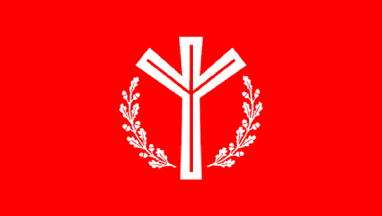 NV Flag 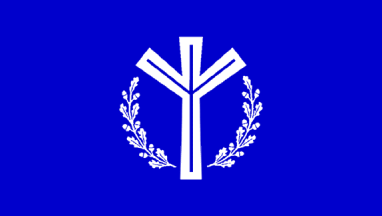 NV Michigan Division Flag |
National Vanguard (USA)
The National Vanguard is an American White Supremacist organization based in Charlottesville, Virginia, that gained brief national notoriety when they dispatched a first response team after Hurricane Katrina with instructions to only help "white" families in Alabama and Mississippi. The NV was founded in 2005 by Kevin Alfred Strom and former members of the National Alliance. The next year, in 2006, several units of National Vanguard split off and left the NV to form a new White Supremacist organization called the Nationalist Coalition (still active in the St. Petersburg area of Florida), but a reduced NA continued to operate in the Charlottesville area after the split. In 2007, Strom was arrested for child pornography, and in 2008 he was sentenced to a two year sentence in prison. Until recently, however, the NV still continued to maintained a website featuring typical White Supremacist and hate articles. The National Vanguard flag is charged with the same white "life" rune and oak branches used by the National Alliance, but has a plain red field. A version of the NV flag with blue field instead of red, was also reported in use by the now-defunct Michigan Division. It remains unclear whether this flag was only used in Michigan and whether the color change was related to the blue field of the Michigan state flag. |
||||||||||||||||||||||||
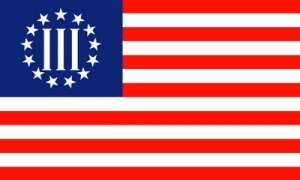 Gun Rights Flag |
Nyberg Battle Flag of the Three Percent (USA) 2008
Based on the belief that during the American Revolution, the active forces in the field against the King's tyranny never amounted to more than 3% of the colonists, militia groups calling themselves by such names as the "Three Percenters," (Threepers), the "Sipsey Street Irregulars," and the "Oath Keepers" (led by Nevada lawyer Stewart Rhodes, a former staffer of Congressman Ron Paul), have sprung up expressing anti-government (current administration) and anti-gun control sentiments, during President Obama's first year in office. They claim to be the ones who "the Founders counted on to save the Republic when everyone else abandoned it." Basically, they are extremist groups of American gun owners who are preparing to "defend" themselves and "their right to bare arms" against "enemies, foreign and domestic," and warn those they call "collectivists" (those who favor gun control), and who they feel control the government, to leave them and their guns alone. |
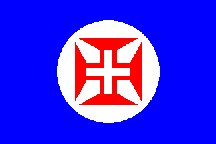 ON Flag |
New Order Flag (Portugal) Ordem Nova (ON) The Portuguese traditional seafaring symbol, the cross of the Order of Christ, did not escape the practice of "National Socialist" type groups to use historical or cultural symbols to falsely represent their organizations, although the Order of Christ cross was originally black on a red background. The Ordem Nova (New Order), a National Socialist movement operating in Portugal in 1978-1982 used this blue flag with a red cross on a white disc. |
||||||||||||
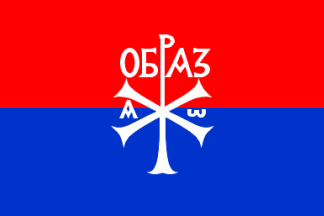 OPO Flag |
Obraz Fatherland Movement 2002-2012 (Serbia) Otacastveni pokret Obraz (OPO) The Obraz Fatherland Movement, founded in 2000, is an ultra-nationalist and extremist Orthodox Christian movement originally led by Nebojša Krstic, a sociologist and theologist. The founding group originally published a magazine called "Obraz" since 1994. The word obraz (cheek) is frequently used as the synonym for "honor." The OPO quickly gained notoriety with its aggressive, and often violent activities against religious and ethnic minorities, as well as anybody else who publicly disapproved of their actions, while simultaneously giving public support to "persecuted patriots" (neo-Nazi skinheads and football hooligans convicted for violence, and persons indicted before The Hague Tribunal). In 2001, Krstic died in a traffic accident (which OPO quickly labeled an assasination), and Mladen Obradovic, a historian, became the new leader. In 2003, a Russian group inspired by Obraz Fatherland Movement, calling themselves Russian Obraz (RO) was started. The OPO's continuing violent activities eventually led to the Constitutional Court of Serbia declaring Obraz illegal in June of 2012, thus making it one of a few such organizations actually banned in Serbia. Obradovic and a few others were convicted independently for LGBT (Lesbian, Gay, Bisexual and Transsexual) bashing during the Pride Parades in 2009 and 2010 (Pride 2009 was actually cancelled, so only passersby were attacked). The OPO was reorganized and re-registered some time afterwards under a slightly different name - Srbski Obraz (Serbian Obraz). Its members contested the parliamentary election of March 2014, were placed on the list of Serbian Radical Partys (no elected representation gained), and are still using the same flag, which was seen during the campaign. The flag of OPO is red-blue horizontal bicolor with a white emblem composed of the Chi-Rho christogram and word "Obraz" in Cyrillic script, the same symbol serving both as the Rho of the christogram and the "R" in the movement name. The field was borrowed from a modern reconstruction of a 13th Century flag of Serbia which is sometimes used at the events commemorating medieval Serbian history. |
||||||||||||
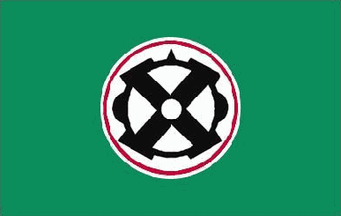 OVN/MNF Flag |
Organization for National Will / Mexican Nationalist Front (Mexico) Organización por la Voluntad Nacíonal / Frente nacionalista mexicano The Organización por la Voluntad Nacíonal (OVN) is a racist national-socialist organization formed in 2007 in Mexico. In 2014, the OVN changed its name to the Mexican Nationalist Front (MNF). They claim to promote a healthy awareness of the Mexican nationality, wish to protect their biological identity, and to lead the fight against those "defeatist historical visions that have left a permanent complex of conquest and resentment." They are against the "nefarious Masonic heritage of liberalism which left us a republic mediocre and decadent." They also are against ecclesiastical supremacy, international Zionism, Marxism, anarchism, communism, global capitalism, and wish to lead a "peaceful" fight against the U.S. invaders who have seized and occupied more than half their national territory. They look back to the Mexican monarchies of Iturbide and Maximilian, regarding Maximilian's empire as a sincere effort to protect Mexico from Anglo-American influences. The Organization for National Will flag has their quincunx-like logo within a white circle surrounded by a red and white and green. Besides being the colors of the Mexican national flag, these represent nature (green), spirituality (white) and blood (red). |
||||||||||||
 PCE(r) Flag 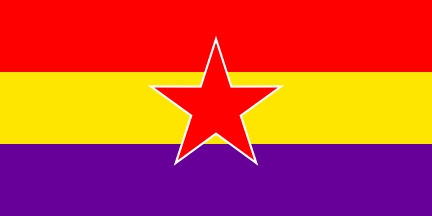 GRAPO Flag |
Communist Party of Spain - Reconstituted (Spain) Partido Comunista de España - Reconstituido The Communist Party of Spain (Reconstituted) was founded in 1975 after the Maoist Organization of Spanish Marxist-Leninists (OMLE Organización de Marxistas Leninistas Españoles) broken away from the old Communist party of Spain in 1968. Its violent armed wing, the First of October Anti-Fascist Resistance Group (GRAPO - Grupos de Resistencia Antifascista Primero de Octubre), was founded on October 1st of the next year - the day which also saw the murder of four Spanish policemen by the group. It also marks the beginning of the revolution against the Francoist Regime. The country's transition to democracy did not seem to stop GRAPO's violence, in fact, terrorist actions intensified. As a result, support for PCE(r) and GRAPO has decreased and during the 1980s, the police successfully neutralize the GRAPO. The party was banned in 2003 due to its support for terrorist activities and GRAPO is currently inactive, although both nominally still exist. The Flag of the Communist Party of Spain (Reconstituted) is red, with a fist holding both hammer and sickle, accompanied with a five-pointed star, all in gold, placed in the canton. It's terrorist arm GRAPO uses a Spanish Republican tricolor with a red (fimbriated white) star in the center. |
||||||||||||
 PNC Flag |
National Christian Party 1935-1938 (Romania) Partidul Nat'ional Cres'tin - PNC The National Christian Party (Partidul Nat'ional Cres'tin), a pre-World War II Romanian Fascist Party, was founded in 1935 by the merger of Alexandru Cuza's National Christian Defense League (Liga Apararii National Crestine, LANC) and Octavian Goga's National Agrarian Party (Partidul Nat'ional Agrar). Strangely enough, the PNC seemed to have been modeled after the rival Iron Guard, the main difference being in their shirts, which were blue instead of green. The PNC party banner was the flag of Romania with a swastika in the center. It was associated with extreme anti-Semitism, calling for a gradual withdrawal of rights for Jews and a gradual policy of reapportionment of Jewish land and businesses. The National Christian Party never received more than about 10% of the vote, but was chosen in December of 1937 by King Carol II to form a government, which lasted only 45 days and was supplanted by the royal dictatorship. During these years, relations between the PNC and the Iron Guard were those of extreme hostility and violence, both groups accusing each other for being used by the Jews in order to suppress the other one. When the PNC was banned in 1938, it is suspected that most of the membership simply joined the National Renaissance Front (Frontul Renasterii Nationale, FRN) founded by the king. It is noted that Cuza served as a member of the Crown Council after the banning and this suggests that he also had migrated into the ruling FRN. |
||||||||||||
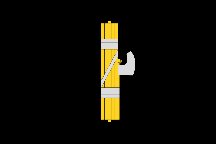 PNF Party Flag |
Italian National Fascist Party 1922-1943 (Italy) Partito Nazionale Fascista The Partito Nazionale Fascista (PNF) was a far-right Italian political party, created by Benito Mussolini as the political expression of fascism. The party ruled Italy from 1922 to 1943 under an authoritarian system. Fascism advocates the creation of a single-party state. Fascists believe that nations and races are in perpetual conflict whereby only the strong can survive by being healthy, vital, and by asserting themselves in combat against the weak. Fascist governments forbid and suppress criticism and opposition to the government and the fascist movement. Fascist blame capitalist liberal democracies for creation of class conflict which they oppose, and communists for exploiting the concept. The symbol on the flag is a fasces, a bundle of sticks used as a symbol of authority by officials in Ancient Rome. The sticks represented the power of individuals. By binding them together and inserting an ax, they could not be broken easily. They represented the united power of many working together as one. The fasces is not just a Fascist symbol and is used world-wide, including on the back of the U.S. Mercury dime. |
||||||||||||
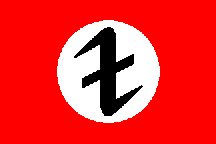 PNN Flag |
Italian Neo-Fascist Party (Italy) Partito Nazionale neoFascista This National Socialist flag features the "Wolfsangel" rune. In a Neo-Nazi demonstration in Vicenza, Italy, they flew this flag. It has the classic Nazi scheme (red background with white circle and a black doppelhaken symbol. The ancient German rune wolfsangel was a magical means to frighten away wolves. It is also known as the doppelhaken or "Wolf's Hook." The upright variant is known as the donnerkeil" (thunderbolt) and the horizontal variant as the "werewolf." Due to its use by Nazi Germany, along with continuing use by neo-Nazi organizations, the symbol is now associated with Nazism as are many of the old folk symbols of the Germanic peoples, most notably, the swastika. |
||||||||||||
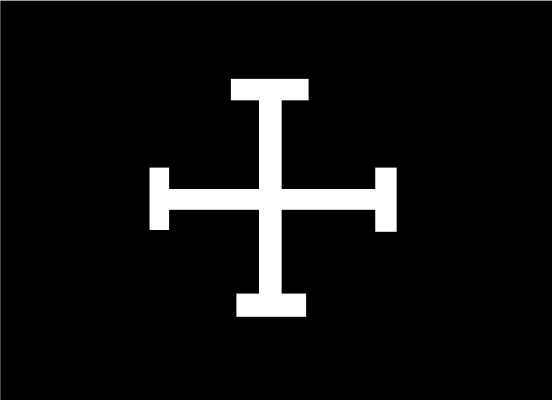 PNPR Cadet Corps Flag |
Puerto Rican Nationalist Party (Puerto Rico) El Partido Nationalista de Puerto Rico The Puerto Rican Nationalist Party (PNPR), founded in 1922, was a violent extremist group whose main goal was Puerto Rican Independence. In 1930, Dr. Pedro Albizu Campos was elected president of the Puerto Rican Nationalist Party, and under his leadership, especially during the years of the Great Depression, the party became the largest independence movement in Puerto Rico. The PR flag was forbidden in the island from 1898 until 1952, but was flown in defiance by the black-shirted Cadet Corps of the Puerto Rico Nationalist Party. They also had a Cadet Corps' flag all in black with a white Jerusalem Cross in the middle. The Puerto Rican Nationalist Party of New York (El Partido Nationalista de Puerto Rico, Junta de Nueva York) claims to be an American Branch of the PNPR. |
||||||||||||
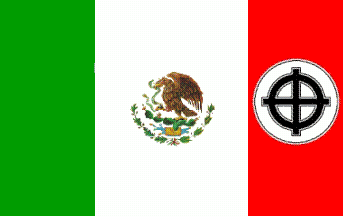 PNSM Flag 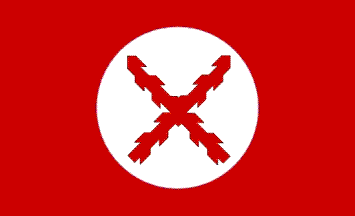 Creole Pride Flag |
Mexican National-Socialist Party (Mexico) Partido Nacional Socialista de México The National Socialist Party of Mexico (PNSM), is not a legally registered political party and seems to be mostly active on the internet. Its platform is based on 14 principles referring both to racial supremacy and its ethical and economic foundations. According to PNSM sources the group has a membership or 35,000 members throughout Mexico. The PNSM claims to have members in Mexico City and the states of Baja California, Jalisco, Nuevo León, Quintana Roo and Chiapas. The flag most commonly attributed to the PNSM is the Mexican National Flag with the Celtic Cross defacing the red stripe of the flag. The Mexican National-Socialist Party (PNSM) claims to have a membership that consists of many Mexican Creoles. An Orgullo Criollo (Creole Pride) flag has been seen in use by the PNSM. According to the official PNSM website the flag symbolize the Creole people of Mexico who gained independence during the 19th Century, but strangely enough, although the flag consist of the usual National Socialist design - red background with white circle, the Cross of Burgundy replaces the swastika. The Cross of Burgundy was used by the Spanish in "New Spain" between 1506–1701, when the Conquistadores were busy conquering and killing much of the native population. |
||||||||||||
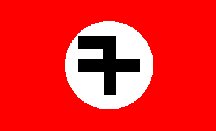 PNT Flag |
New Triumph Party (Argentina) Partido Nuevo Triunfo The Argentine group Partido Nuevo Triunfo (PNT) is presently banned in Argentina, but its flag is still widely used by other racist groups. It was founded in 1990 by Alejandro Biondini, evolving from an internet publication. Biondini ran for president in the 2003 election with little impact. Their flag has the standard red field, white circle, and black emblem of such groups. The swastika-like emblem looks like a crossed number 7. The party explanation is that it represents Saint Cajetan. Saint Cajetan Day is August 7, and he is the protector of workers, unemployed people and work seekers. |
||||||||||||
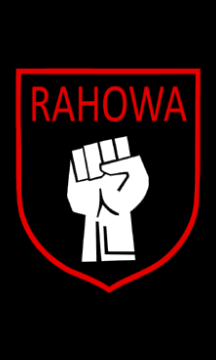 RaHoWa Flag |
Racial Holy War Flag (USA)
The concept of a Racial Holy War, or RaHoWa, was first suggested by Ben Klassen, the founder of the Church of the Creator. The Church of the RaHoWa, sometimes refered to as the "White Crusaders of the RaHoWa", are a break-away group from the Creativity Movement. The movement beleives that White people should unite and undertake a holy war against Jews and non-Whites. The term "RaHoWa" has become a popular war cry for many White nationalist groups, and flags, stickers, and buttons like this shown are quite popular amongst them. RahoWa was also the name of a Canadian white power rock band that formed in 1989. The lead vocalist George Eric Hawthorne (his real name was George Burdi) was a white supremacist and the owner of the recording company (named Resistance Records) which published the band's music. Burdi was also at one time the Canadian leader of the World Church of the Creator, and not suprisingly the songs on their first album "Declaration of War" were racist with very violent lyrics. Following a RaHoWa concert in Ottawa in 1993, Burdi kicked a fallen female Anti-Racist Action member in the face during the riot, for which he was arrested, convicted, and served a jail sentence. He later publicly renounced racism. |
||||||||||||
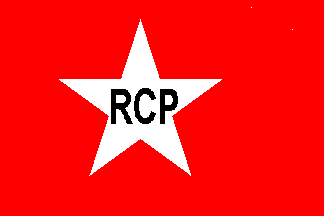 RCP-USA Flag (black lettering variant) 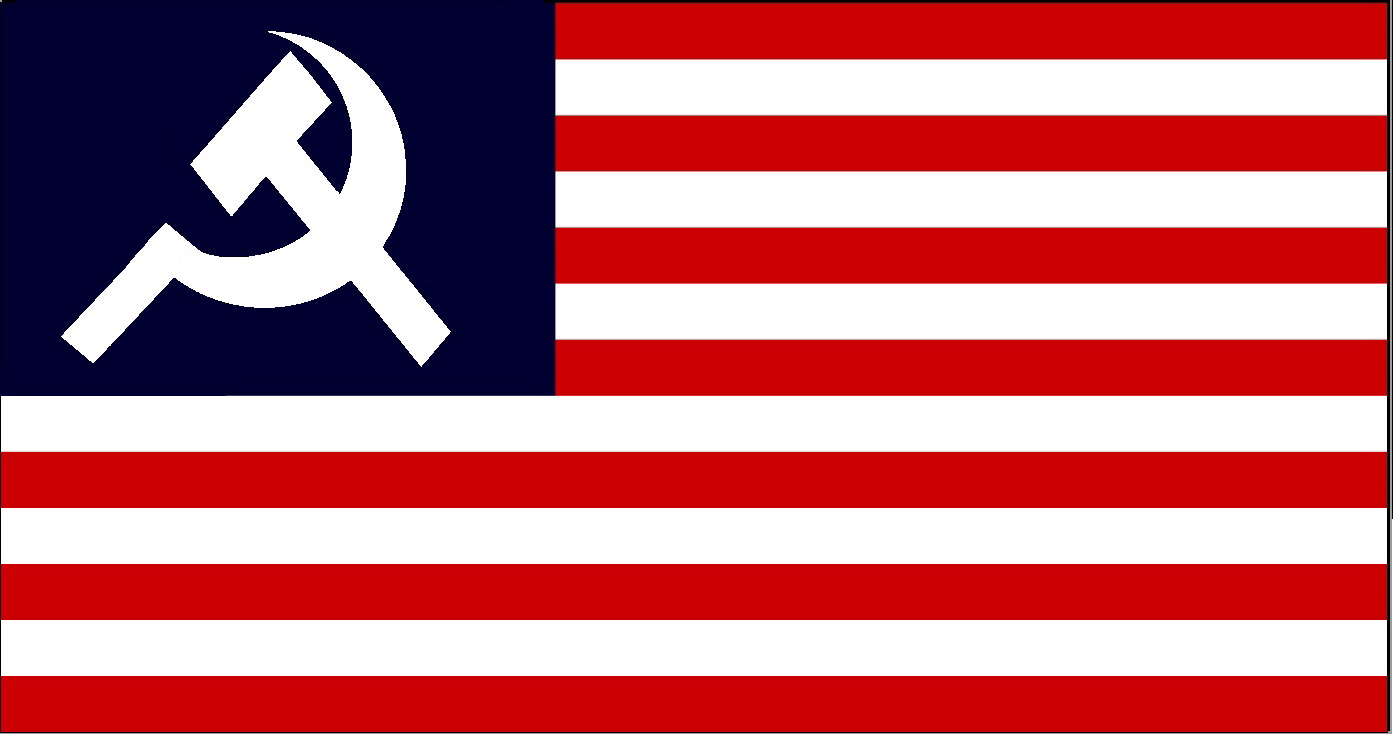 RCP-USA Flag (un-documented variant) |
Revolutionary Communist Party, USA (USA)
The Revolutionary Communist Party, USA (RCP-USA), known originally as the Revolutionary Union, is a Maoist Communist party formed in 1975 in the United States. The RCP states that U.S. imperialism will never peacefully end, and that the only way for people to liberate themselves is through revolution. The RCP enthusiastically supported the 1992 violent Los Angeles social unrest in the aftermath of the Rodney King verdicts as a "rebellion," and then-LAPD chief Daryl Gates went so far as to allege that the RCP was explicitly involved in the riots. The party was led by its elected National Chairman and primary theoretical spokesperson, Bob Avakian. It is one of the few surviving direct descendants of the New Left of the 1960s and 70s. As a result of criminal indictments stemming from a protest against Deng Xiaoping at the White House in 1979, Bob Avakian fled the United States. Because of this, the RCP is active in both the United States and Western Europe. In recent years the party has suffered several splinter groups and power struggles over leadership positions which has further weaken the group. The RCP-USA generally used a red flag with a white star either centered or off-set slightly to the left as shown here. The letters "RCP" in either black or red are superimposed on the star. Recently, a stars and striped variant has also been reported being used by the group, but this is currently undocumented. |
||||||||||||
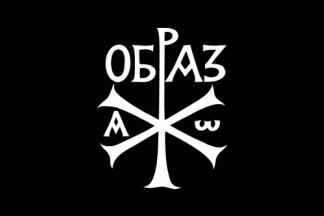 RO Flag Type #1 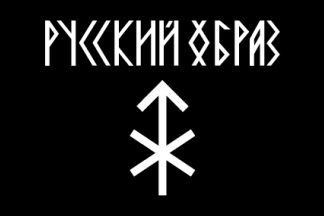 RO Flag Type #2 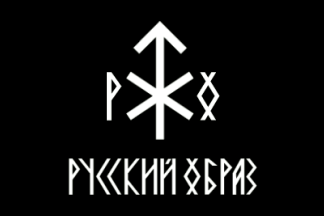 RO Flag Type #3 |
Russian Obraz 2003 (Russia) Russkiy Obraz (RO) The Russian Obraz is an ultra-nationalist organization modelled after the Obraz Fatherland Movement, a similar organization from Serbia. Although modelled after the Obraz of Serbia, the Russian organization is somewhat closer to the neo-Nazis, mostly in their tolerance for Russian neo-paganism, for many members are followers of such cults. It should also be pointed out that the name obraz was just copied from Serbian by the Russian RO and that the word has a completely different meaning in Russian, that of "picture" or "image." The RO proclaim they "are determined to end political correctness and stop the flow of illegal immigrants to our countries – the phenomenon which has created dangerous criminal and social problems" and "Russia should obtain a Russian Mind. We will succeed or Russia will not exist." The main RO flag (Type #1) is derived from that of its Serbian counterpart by changing the field color - plain black instead of bicolor red-blue. An alternate RO flag (Type #2) displays a different emblem - runes Tyr and Gebo placed one over the other, which in Russian pre-Christian religion were representing spear and shield of god Perun according to their website. The name of the RO organization is inscribed above the emblem, in a typeface with letter shapes modelled after the runes. Another RO flag (Type #3) used by the movement has the name of the organization inscribed beneath the emblem, which is amended with the initials "R" and "O", inscribed in the same typeface as the full name. |
||||||||||||
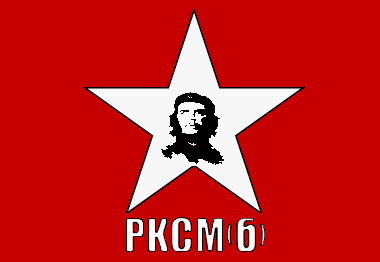 RCYL(b) Flag 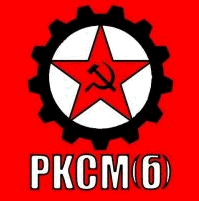 RCYL(b) Banner 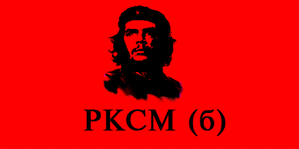 RCYL(b) Flag (variant) |
Revolutionary Communist Youth League - Bolsheviks (Russia) The extreme leftist Revolutionary Communist Youth League (Bolsheviks) was originally founded in Moscow in 1996 by Alexander Batov. It formed after the split of RYCL and considers itself the heir of the most progressive and communist part of the Komsomol (Kommunisticheskii Soyuz Molodyozhi) (All-Union Leninist Young Communist League - AULYCL). In 2000, the RCYL(b) was linked with a plot to place a bomb near the Federal Security Service building and three of its members were arrested in that plot. In 2005, the RCYL(b) cell in Leningrad formed a union with the Lenin Komsomol of Leningrad (LYCLL), and since then RCYL(b) cells have been formed in many regions of Russia and also in several foreign countries. The activities of the RCYL(b) includes (in their own words): "fighting for the release of political prisoners including RCYL(B) members); helping the Russian Communist Workers' Party (the Revolutionary Party of Communists to set up trade unions independent from the state); fighting for the youth's right to education; supporting the general struggle for social rights; taking part in direct action against the bourgeois regime; training the membership base in ideology and publishing the Revolyutsiya theoretical journal; taking part in the annual National Russian anticapitalism youth march; running youth camps to strengthen discipline and to train members in guerrilla warfare; publishing a bi-monthly newspaper, the Bumbarash; demonstrating solidarity with the working class and anti-imperialist struggles throughout the world." Unfortunately, many of these activities have turned violent. On their flag is a portrait of the Cuban revolutionary Che Guevara and beneath him the abbreviation (in Russian) for the Young Bolsheviks "PKCM(b)." There are two different typefaces used, often Times Roman, sometimes with chopped fonts. Ernesto "Che" Guevara was an Argentine-born Cuban revolutionary, Castro's aide who left Cuba after the revolution had been won, to launch other revolutions in other Latin American countries (It seems that he had previously had serious disagreements with the rest of Cuban leadership, although nothing is precisely known about that, nor will be as long as Cuba is a Communist country), and was eventually killed in Bolivia. The photo which is used on many leftist flags throughout the world may have been shot in Bolivia. The photo has became almost an icon for leftists throughout the world. |
||||||||||||
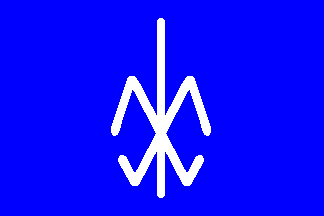 RF Flag 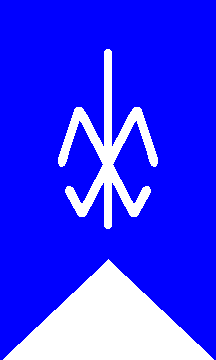 RF Processional Banner 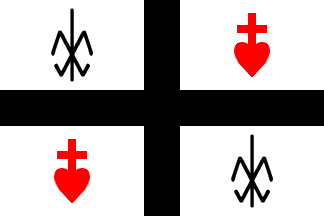 French Renewal Finistère Department Section |
The French Renewal (France) Renouveau Français The French Renewal (RF) is a French ultra-rightist organization, founded in 2005, and affiliated with the European National Front. The RF claims to be nationalist, Catholic and "counterrevolutionary," i.e. - against the principles of the French Revolution of 1789. The most common symbol on the RF street literature is a black and white celtic cross and their swastika-like, stylized fleur-de-lys emblem. Their self-proclaimed goal is to defend and free the "French nation" from the parliamentary system, lobbyist organizations, and what they see as "the fundamentally Masonic, secular, and cosmopolitan Republic." Besides rejecting Freemasonry, they target "Marxism" and what they call "Classical Liberalism." In the 1980s, the RF more or less "incorporated" with the French National Front and carried their symbols in the FN parades and demonstrations. However, as Marine Le Pen succeeded her father as FN leader and attempted to clean-up the FN party's image, they established a policy of only displaying the French national tricolor at their demonstrations. The result is a split and, accordingly, the RF has re-emerge as a completely separate movement again.
The flag of Renouveau Français is blue with the white stylized fleur-de-lis emblem of the movement centered in the middle. It is most often seen in the nationalist demonstrations scheduled every year in May in Paris. The movement also uses a "processional banner," made of a vertical, swallow-tailed version of their flag.
Other flags reported being used by the RF during their demonstrations include a French tricolor defaced with the symbol of the Sacred-Heart-of-Jesus, a Sacred Heart centered on a plain white field (both borrowed from the Traditionalist Catholics), the traditional provincial Île-de-France heraldic banner with three golden fleur-de-lys on blue, and a white heraldic banner defaced with a red sacred-heart on multiple golden fleur-de-lys. |
||||||||||||
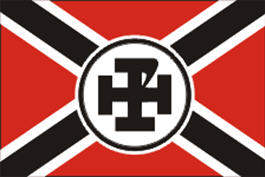 RNS Flag |
Russian National Union (Russia) Russkiy Natsional’niy Soyuz (RNS) The Russkiy Natsional’niy Soyuz (RNS) is a neo-Nazi party based in Russia. The party grew out of the followers of Konstantin Kasimovsky, a leading member of Pamyat in the immediate aftermath of the collapse of the Soviet Union. He split from the Pamyat-led National Patriotic Front in 1992 and formed his own party, the Russian National Union, the following year. This party re-emerged as the "Russian National Socialist Party" (RNSP) in 1998. The party bases itself on four principles i.e. Orthodox Christianity, a strong state, aggressive Russian nationalism and non-Marxist socialism. The party symbol is the Labarum of Constantine the Great and since 1999 have published a newspaper "Right Resistance," itself a successor to the earlier journal "Stormtrooper." |
||||||||||||
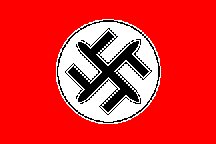 RNU Flag 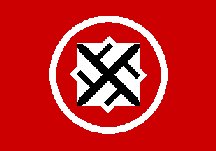 National Unity Flag (Type 2) |
National Unity of Russia (Russia) Rossiyskoye Natsional’noye Yedinstvo (RNU) The Rossiyskoye Natsional’noye Yedinstvo (RNU) is a far right, ultra-nationalist political party and paramilitary organization based in Russia and operating in states with Russian-speaking populations. It was founded by the ultra-nationalist Alexander Barkashov and claims to have 20,000 members, making the National Unity the largest extremist organization in Russia. There are reportedly 120 nationalist organizations displaying fascist and neo-Nazi symbols in Russia, the most prominent are the Russian National Union, Russian National Council and the Russian National Unity. All these groups are xenophobic (distrust of strangers), antisemitic (hate Jewish people), and blame all of Russia's problems on a imagined "Jewish and Zionist Conspiracy." 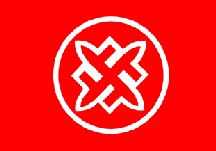 National Unity Flag (Type 3) |
||||||||||||
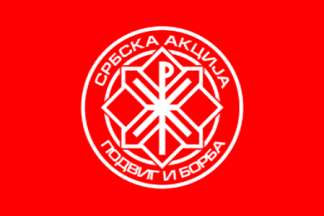 SA Flag (Type #1) 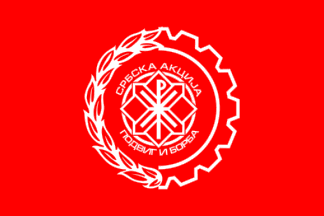 SA Flag (Type #2) 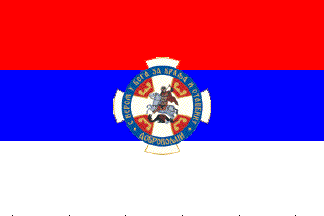 Serbian Volunteer Corps (World War II Zbor Flag) |
Serbian Action Srbska Akcija (SA) Serbian Action (SA) is a Serbian ultra-nationalist organization founded in 2009-2010, which draws its inspiration from the Serbian People's Movement "Zbor", originally a pre-World War II ultra-rightist movement, but briefly resurrected in the early 2000s. The SA might even be considered the successor to this "reanimated" movement of the 2000s, because they have adopted some of the Zbor symbols and propaganda. The SA also has ties with other extremist groups such as the New Right of Romania and the Golden Dawn of Greece, having incorporated similar racist ideas and some of their symbolism into its ideology.
The flag of Serbian Action is red, charged with its emblem in white, colors shared with the Zbor of 2000s. The original emblem consists of a Chi-Rho christogram superimposed over the outline of an eight-pointed star, all superimposed over a smaller ring and surrounded with a larger one. Between the two rings are the name of the organization at the top and the motto "Valiance and struggle" (Podvig i borba) at the bottom. A newer variant replaces the larger ring with combined outlines of wheat-ear, borrowed from the symbols of original Zbor, and cogwheel. They also use the traditional Celtic Cross flags, common to many extremist groups worldwide, and the flag of Serbian Volunteer Corps, the World War II military formation founded by the original Zbor. |
||||||||||||
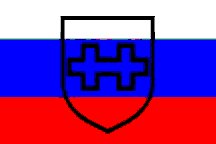 SA Flag 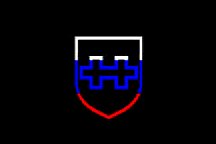 SA Flag Variant |
Northern Alliance Party Flag (Russia) Sevyerniy Alliyans The Russian Sevyerniy Alliyans (SA) is the third largest neo-Nazi party in Russia, after the RNSP and the RNU.
The Northern Alliance uses four different flags: The two double cross shield versions, the Russian tricolor with swastika, and the old ROA flag of General Vlasov's army, which collaborated with the German Army and Reich during World War II (also known as the Flag of Russia and Russian Naval Ensign). |
||||||||||||
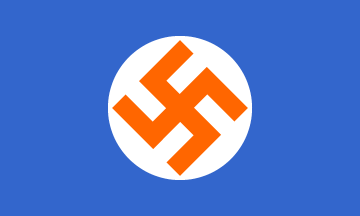 SANP Flag 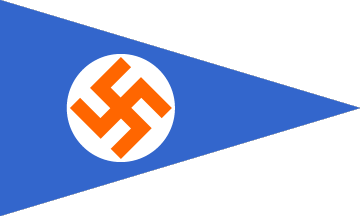 SANP Pennant |
South African Nazi Party (South Africa) South African Gentile National Socialist Movement Greyshirts - Gryshemde In the 1930's a number of groups sympathetic to Nazism emerged in South Africa, but perhaps the best known was the South African Nazi Party (SANP), known more simply as the Gryshemde (Greyshirts) because of their paramilitary Sturmabteilung-like uniforms. Their official names of the "South African Gentile National Socialist Movement," and the "South African Christian National Socialist Movement," was rarely used. The group, which remained active during the 1930s and 1940s, was started by Louis Weichardt. Its platform was the basic Nazi hate and anti-Semitic propaganda. Headquarter in Capetown and Pretoria, the Greyshirts published a newsletter called simply the "Bulletin" where they attempted to justify the actions of the national socialists both in Germany and South Africa. What was unusual about this particular South African extremist group was that they sought to work with both the Afrikaans and the English-speaking populations at the same time. As the Jews fled Nazi Germany during the mid-1930s, many relocated in the Cape Town area of South Africa and the Greyshirts organized large street rallies protesting this Jewish immigration. The government closely monitored these Greyshirts activities, especially during World War II, and by 1949, the Greyshirts, now calling themselves the White Workers Party, gradually faded from South African political life. |
||||||||||||
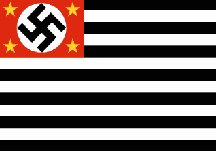 São Paulo neo-Nazi Flag |
São Paulo Neo-Nazi Movement Flag (Brazil)
The largest concentration of Brazilian neo-Nazi are in São Paulo, an industrial city of more than 10 million people. Today, an estimated 1,000 neo-Nazis live in the city. Their policies still contain hatred of Jews, blacks, and homosexuals. They also advocate the secession of the more prosperous southern Brazil from the rest of the country. A new major theme of Brazilian neo-Nazis is hatred of Nordestinos (Northeasterners), people from the impoverished Northeastern states who have migrated in increasing numbers to the large cities in search of a better life. The issue parallels immigration problems in Europe and the United States, stimulating the same popular fears of job loss and insecurity. Brazil's neo-Nazi, like their counterparts elsewhere, thrive on such fears. |
||||||||||||
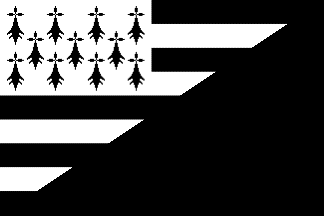 Scream! Flag (Type #1) 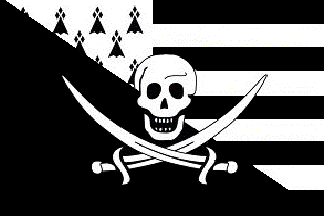 Scream! Flag (Type #2) |
Scream! (Brittany, France) Disuj! Scream! is a Breton far-left nationalist anarcho-independentist organization which, founded first in 2001 as the Coordination Bretagne Indépendante et Libertaire (CBIL), was renamed Scream! (Disuj!) in 2012. Scream has consolidated several local movements, such as Huch! (in Rennes), Treger Disuj (Tregor), Ti an Dispac'h (Pontivy), Kailh Du (Lorient) and Strollad Lochu (Brest) into a larger regional organization. They publish a newsletter called "The Megaphone" (Le Huchoèr). Although nationalism in the province of Brittany in France can almost be considered a traditional pastime since medieval times, the blending of traditional Breton nationalism with the extremist beliefs of anarchism can be considered an explosive combination. 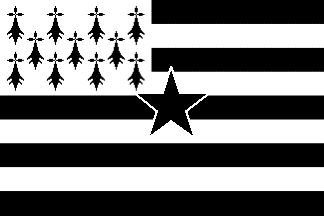 Scream! Flag (Type #3) Disuj! uses two flags based on a blend of the traditional province flag of Brittany and the black anarchist flag (Type #1 and Type #2). A third flag has been used in "The Megaphone," published in eastern Brittany, and superimposes a black Anarchist star centered on the traditional Gwenn-ha-Du Brittany flag. |
||||||||||||
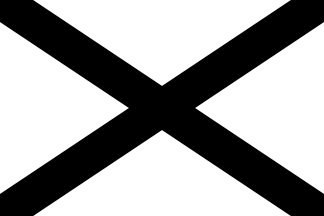 SNN Flag |
Southern Nationalist Network (USA)
The Southern Nationalist Network (SNN) was created in 2010 by a group of modern day Southern separatist whose goal seems to be, once again, the establishment of Southern independence. This neo-Confederate extremist group views the South as an occupied nation, and feel themselves to be "at odds with anything that comes out of Washington, DC, and with the tone of the general culture across the US as a whole." The Southern Nationalist flag, a black saltire on white field, was introduced as the "symbol of neo-Confederate extremists in the USA" in 2013 by the Southern Nationalist Network. The white is said to stand for "European heritage, hierarchy, tradition," and black symbolizes "Southern nationalism." Besides being featured on the SNN website, the League of the South, a Neo-Confederate organization, use the SNN Flag at its demonstrations in the towns of Uvalda and Vidalia, Georgia, in 2013. |
||||||||||||
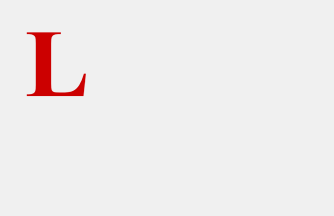 SLA Flag |
The Silver Legion of America 1933-1942 (USA)
The Silver Legion of America, or Silver Shirts, were an American fascist organization founded by a Hollywood screenwriter named William Dudley Pelley in 1933. The paramilitary Silver Shirts wore silver colored shirts with a dark blue tie and military riding pants as their uniform. The shirt had a large red letter "L" over the left pocket. Their flag had a silver field with the red "L" in the canton. By 1934, the Silver Legion could claim about 15,000 members. The main headquarters of the SLA was in Asheville, North Carolina, but in 1935, they began construction of a fortified bunker compound in a remote 55 acres in the Los Angeles hills which was designed to serve as their world headquarters after a Fascist global conquest. After the Japanese attack on Pearl Harbor in December of 1941, and the US entry into World War II, Los Angeles police raided the "world headquarters" bunker compound and detained the 50 SLA troopers "stationed" there. Pelley went into hiding, was eventually arrested at his new base of operations in Noblesville, Indiana, and charged with high treason and sedition in 1942. The treason and sedition charges were dropped, but he was convicted on lesser crimes and sentenced to 15 years imprisonment. He was paroled in 1952. |
||||||||||||
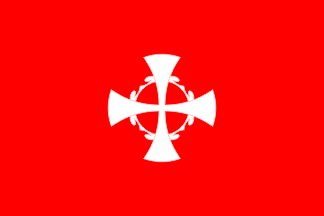 SNP "Zbor" Flag c2000s 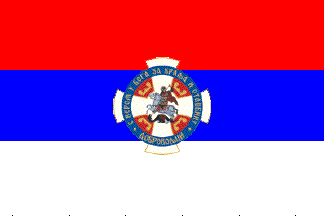 SVC Flag 1941-1945 |
Serbian People's Movement "Zbor" (Serbia) Srbski narodni pokret "Zbor" This group claims claims to be the successor of the Yugoslav People's Movement "Zbor" (Jugoslovenski narodni pokret "Zbor"), which was founded in 1935 by a fusion of several pro-Fascist groups from various parts of Yugoslavia. Zbor (rally) is also an acronym for Združena borbena organizacija rada (United Combative Organization of Labour). The Zbor was founded by Dimitrije Ljotic, who preached a strange blend of authoritarianism, corporatism, monarchism, anti-Communism, anti-freemasonry, Orthodox Christian fundamentalism and anti-Semitism, plus encouraging an alliance with the Third Reich and Fascist Italy. By 1940, when a hostile Yugoslav government banned the SNP, it evolved from an all-Yugoslav into a Serbian-only organization. However, after the occupation in 1941, the Zbor re-organized as the Serbian Volunteer Corps (Srpski dobrovoljacki korpus - SVC), and actively assisted the occupational forces in the persecution of Jews in present-day Serbia, as well as in the repression against other Serbians (a policy of 100 executed civilians for one killed German soldier). In 1945, Ljotic was killed in a car accident while fleeing and many of his followers were later extradited, tried and executed. Those who successfully escaped to Germany maintained their exiled organization for years, although they have been generally rejected by the mainstream Serbian diaspora. After the collapse of Communism, there were constant efforts to re-introduce the ideas of Zbor in Serbia, but with very limited success. The original Zbor used a number of emblems, but seemed to have had no flag of their own. The only related flag was that of the Serbian Volunteer Corps, which is now sometimes used by modern ultra-rightists, and adds the unit badge to the national tricolor: a "Kosovo Cross" between four fire-steels which are taken from the national coat of arms, over all the image of St George slaying the dragon and inscriptions S verom u Boga za Kralja i Otadžbinu (With Faith in God, For King and Fatherland) and Dobrovoljci (Volunteers). The re-founded group uses a red flag with white "Kosovo Cross" between four fire-steels, arranged so as to resemble both the Serbian Volunteer Corps badge and a Celtic cross. |
||||||||||||
 SS Flag (Type #1) 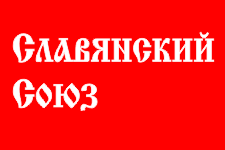 Slavic Union Party Flag (Type #2) |
Slavic Union Skinheads (Russia) Славянский Союз The far-right Slavic Union, claiming to be Russia's National Socialist Movement, is led by Dmitry Demushkin, and is one of a number of Russian nationalist groups with neo-Nazi tendencies. The group’s Russian initials spell SS (CC), its members give Nazi-style salutes, and its main flag features a reworked swastika. The group has claimed responsibility for several murders and attacks on Jewish organizations, websites, and groups. They claim kinship to the Russian Nation Union and other Russian extremist organizations such as the National Patriotic Front.
The Slavic Union was recognized as an extremist organization and banned by the Moscow City Court in 2010, and by the Supreme Court of the Russians the next year. After the Slavic Union was banned, the Slavic Force (Slavyanskaya sila) was founded by Dmitry Demushkin to replace it. The organization uses either red or black flags with the name of the organization in white, inscribed in two lines in a medieval-looking typeface, following the previous practice of the Slavic Union. |
||||||||||||
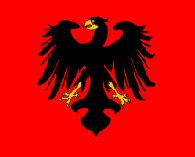 SRP Flag |
Socialist Reich Party of Germany (Germany) Sozialistische Reichspartei Deutschlands (SRP) The Sozialistische Reichspartei Deutschlands (SRP) was a West German political party founded in the aftermath of the Second World War, in 1949 as an openly National Socialist and Hitler-admiring split from the German Empire Party. Leading figures included Otto Ernst Remer and Fritz Dorls. It denied the existence of the Holocaust, claimed that the USA built the gas ovens of the Dachau concentration camp after the War and that films of concentration camps were faked. The SRP also advocated a reunited Europe, led by a German Reich, as a "third force" against both capitalism and communism. The SRP had its own paramilitary organization, the Reichsfront, and the youth wing, Reich Youth (Reichsjugend). The SRP was banned in 1952 by the Federal Constitutional Court of Germany. |
||||||||||||
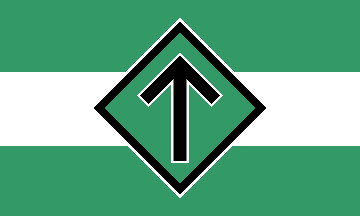 SMR Flag (type #1) 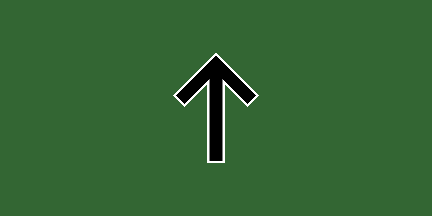 SMR Flag (Type #2) 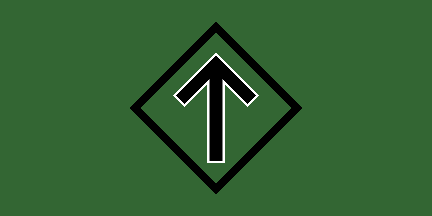 SMR Flag (Type #3) |
Swedish Resistance Movement (Switzerland) Svenska Motståndsrörelsen The Swedish Resistance Movement (SMR) is a Swedish, militant Neo-Nazi organization that exists in Stockholm, Göteborg, Malmö and Linköping. The Leader is Klas Lund, former member of White Aryan Resistance (VAM), and convicted of manslaughter. The aims of Swedish Resistance Movement is to establish a Nordic government by revolution. The organization says their fight will require bloodshed. Like many neo-Nazis and white nationalists groups, they call themselves the resistance, because they consider themselves to be fighting Jewish-Marxist tyranny. The organization is mainly known for their links to heavy criminality. According to the Swedish Security Service, the SMR is the Neo-Nazi Group which is the biggest threat against Sweden's inner security. Their main tactic is handing out leaflets about crimes committed by foreigners and immigrants in Sweden, arranging public rallies and training their members in martial arts and other physical activities such as marches and paintball. Their camps in the Swedish woods have left some people to believe they are training for a civil war or a revolution. In November 2003, the Swedish Security Service raided homes of leading members, among them Klas Lund, who was later sentenced to prison for illegally possessing a firearm. In 2008, these flags "transplanted" themselves to Finland and the Finnish Resistance Movement (SVL - Suomen Vastarintaliike), another neo-Nazi group, started by Henrik Holappa, a former member of the Finnish "True Finns" (Perussuomalaiset) Party. Their activities seem to mirror those of the Swedish group. |
||||||||||||
 SNF Flag 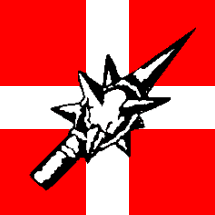 PNOS Flag  Swiss National Flag |
Swiss National Front (Switzerland) Schweizer Nationale Front The Swiss National Front (Front Nationale) was founded in 1933 in Zurich as a merger of different right wing groups. The SNF began among the debating clubs of the University of Zurich, where anti-Semitism, Swiss nationalism, and support for the racial policies of Nazi Germany was popular. Its anti-semitic message was published in the student party newspaper, Der Eiserne Besen (The Iron Broom), became widely read. The party, under the leadership of Rolf Henne, supported a national referendum in 1935 that sought to change the Swiss government into a nationalist, racial, and authoritarian state, but was it was soundly defeated. Henne lost the party leadership in 1938 to Robert Tobler and his followers left to form the Nationale Bewegung der Schweiz (National Movement of Switzerland or NBS). In 1940, the SNF was temporarily dissolved and reformed as the Eidgenössiche Sammlung (Swiss Federal Collection/Gathering/Assembly) after Tobler was imprisoned for espionage, but two years later, in 1943, the party was completely disbanded. Swiss Nationalist Party/Party of Swiss Nationalists (Switzerland)Partei National Orientierter Schweizer In 2000, a far-right völkisch political party calling itself the Partei National Orientierter Schweizer (Party National of Orienting Swiss or PNOS), but commonly referred to in English as simply the "Swiss Nationalist Party" or "Party of Swiss Nationalists", was founded by Jonas Gysin and Sacha Kunz, who claimed it to be the successor of the old National Front. Its activities seem to be centered in the Swiss-German parts of the western Swiss plateau. The "total" or "throughout" Swiss cross (extended to meet the edges of the flag) was present on many far-right Swiss flags during the 1930s and was meant to look more like the ancient Swiss banners. These flags were also used after World War II by such groups, although in recent years the official Swiss national flag (and cantonal flags) have been more commonly used. The PNOS also uses a variant of the National Front flag, but defaced with its logo. |
||||||||||||
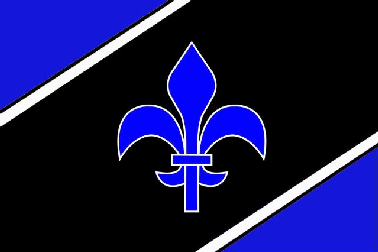 Blue Solutrean Flag 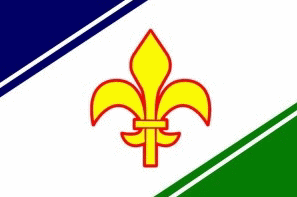 Gold Solutrean Flag |
Solutreans (USA)
John de Nugent, a white racist and nationalist who ran for sheriff in Armstrong County in Pennsylvania under the motto of "For God, Guns, Guts and Glory" has designed several flags alluding to the idea the Solutreans, a prehistoric culture in France who he claims are the true ancestors of all white North Americans. According to de Nugent the Solutreans crossed the Atlantic in the Ice Age, but were later massacred by the ancestors of the "Asiatic" Indians who arrived later. He also believes in aliens who "are good, bad and neutral and form alliances like earthly nations." He also claims Barack Obama's real father was Franklin Marshall Davis, a black Communist, and that the Jews and Arabs are descended from the Neanderthals. The first of his two Solutrean Flags has a blue fleur-de-lys with a white border on a black diagonal stripe, fimbriated in white, running from the lower hoist to the upper fly on a blue filed. The Second variant features a black diagonal center stripe (also fimbriated in white) with a gold fleur-de-lys with red border, a blue upper diagonal field and a green lower diagonal field. It is unclear if these flags actually exist or are simply graphic images used on his website. |
||||||||||||
 SNSP Flag |
Swedish National Socialist Party 1930-1936 (Sweden) Svenska Nationalsocialistiska Partiet The Swedish National Socialist Party was founded in 1930 by combining several smaller Nazi groups into the New Swedish National Socialist League (Nysvenska Nationalsocialistiska Förbundet) which was renamed the Swedish National Socialist Party the next year. At that time, its leader Birger Furugard saw himself as the future riksledare (fuehrer or leader) of Sweden, but the party suffered from a serious split in 1933, when large number of members broke away under the leadership of Sven Olov Lindholm, Furugard's deputy, and formed the National Socialist Workers Party, which quickly became the strongest Nazi movement in Sweden. In 1936, following a meagre performance in the national elections, the party was disbanded. The SNSP used a red flag, charged with a gold swastika on blue disk. This flag was later one of the flags adopted and used by the National Socialist Workers Party. |
||||||||||||
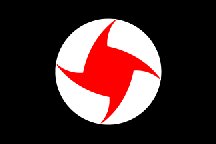 SSNP Flag |
Syrian Social Nationalist Party (Syria) al-Hizb as-Suri al-Qawmi al-Ijtima`i, or Parti Populaire Syrien The Syrian Social Nationalist Party (SSNP) is a far-right political party in Syria and Lebanon. The party policies have been heavily influenced by Italian and German fascist ideology, which was reinforced by its imitation of the external symbols of the Nazi Party. It advocates the establishment of a Greater Syrian nation-state spanning the ancient Fertile Crescent, including present Syria, Lebanon, Iraq, Jordan, Israel, the Palestinian territories, Cyprus, Kuwait, Turkey and the Sinai Peninsula of Egypt. SSNP was first founded in Beirut in 1932, became a major Syrian political force in the early 1950s, but was outlawed in 1955. In 2005, SSNP was again organized and joined the Baath Party-led National Progressive Front (prior to that, it had been the greatest rival to the Ba'ath Party). In the 2007 election, SSNP won 2 out of 250 seats in the Syrian parliament. |
||||||||||||
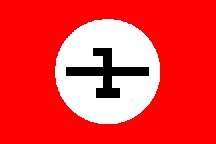 Simorq Bird Party Flag 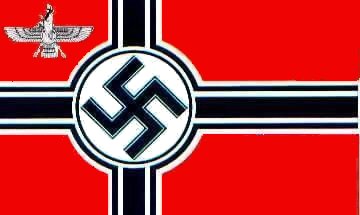 NASKA Party Flag 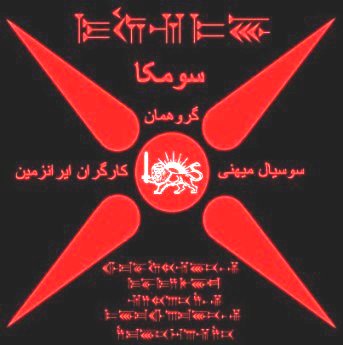 SUMKA Party Flag |
Iranian National Socialist Workers Party (Iran) Hezb-e Sosialist-e Melli-ye Kargaran-e Iran (SUMKA) Hezb-e Nasional Sosialist-e Kargaran-e Iran (NASKA) The Hezb-e Nasional Sosialist-e Kargaran-e Iran (NASKA) was an Iranian neo-Nazi party, also refered to as the Iran National-Socialist Workers group, was opposed to Mosadegh's democratic government (1950-1953) and expressed a strong neo-Nazi ideology. It was a very small organization and disappeared very quickly during the early 1950s. However, recently a new group calling itself Hezb-e Sosialist-e Melli-ye Kargaran-e Iran (SUMKA), claiming to be direct heirs of the original group, has become active in Iranian politics. The original group was formed in 1952 by Davud Monshizadeh (an Iranian Azeri), a professor at Ludwig Maximilians University of Munich, who served with the SS and been injured fighting in Berlin. Before this the name had been used informally to refer to those in Iran who supported Adolf Hitler during the Second World War. Today, SUMKA runs a few wandering websites (quickly opened, then quickly closed), still teaching their versions of the fundamental beliefs of the Iranian National Socialist ideology to a new generation, although they have never regained their past popularity. Membership has dropped to basically a few members. Their ideology is still based on Anti-Semitism (against Jews) and Anti-Hemitism (against Arabs) and glorifying the "Aryan Identity," but they have drastically modified their views about racialism, World War II, and Nazism. The original flag of SUMKA had the emblem of a stylized Simorq Bird from Shanameh Ferdowsi at the center. An interesting variant occasionally used by SUMKA was combining a World War II Nazi German War Ensign with the Persian Eagle in the canton. The new style for the SUMKA flag has Lion, Sun, and a straight edge Persian sword at the center of the Derafsh Kaviyani (ancient Persian banner) symbol, with both Persian Spike Alphabet (Khat Mikhi) and Modern Persian Alphabet writings around the logo. |
||||||||||||
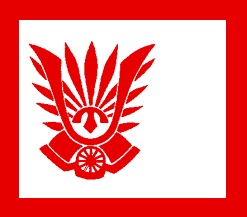 Tate no Kai Flag |
Shield Society 1968-1970 (Japan) Tatenokai/Tate no Kai The Tatenokai (Shield Society) was a short-lived militia claiming their goal was to defend traditional Japanese values and restore imperial power to the Emperor. It was founded in 1968 by Yukio Mishima, who was a writer for an obscure right-wing college newspaper called the Ronso Journal. With a total membership of less than 100, the Tatenokai still managed to briefly train with the Japanese Self-Defense Forces. In 1970, Mishima and Masakatsu Morita, a Tatenokai student leader, managed to seize control of the Self-Defense Force's headquarters and attempted to rally the soldiers to seize power and restore imperial rule. It failed after Mishima and Morita committed seppuku (ritual suicide). The remaining Tatenokai, were apparently not involved, but the society disbanded. In 1977, two former members of the Tatenokai, Yoshio Ito and Shunichi Nishio, made the news when they led a small group of Japanese nationalists seizing 12 hostages at the headquarters of Keidanren (Japan Federation of Economic Organizations). All hostages were safely released after an eleven-hour standoff, thanks to an intervention by Mishima's widow, Yoko. |
||||||||||||
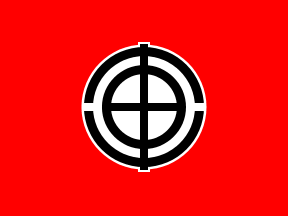 Japanese Fascist Flag 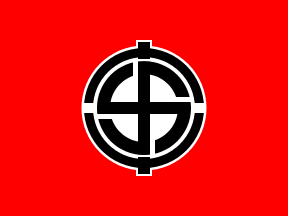 Japanese Fascist Flag (Swastika variant) |
Tohokai 1936-1945 (Japan)
The Tohokai (Far East Society) was founded in 1936 by Seigo Nakano who advocated a fascist Japan. Their flag design was based on the Japanese letter meaning "east" and on the swastika. The ultranationalist Tohokai party supported the Imperial Japanese Navy and pressured the government to halt what they considered the Imperial Army's overly-ambitious aim of conquering all of Asia. This brought them in conflict with the pro-Imperialist faction led by General Hideki Tojo, who supported the interests of the Japanese Army and the continued conquest of the rest of Asia. After Tojo's appointment as Prime Minister, Nakano unwisely continued to be verbally critical of the Tojo regime. He eventually was forbidden to publish articles or make public speeches. He committed seppuku (ritual suicide) in 1943 after being placed under house arrest. The Tohohai Swastika Flag is based on the original flag of Tohokai with the addition of the swastika in the center replacing the stylized "Sun Wheel" design. It must be remembered that the swastika is very popular in Japan because it has been used as the symbol in Japanese temples for hundreds of years before the adoption of it by the National Socialist German Workers Party in the late 1920s. The modern National Socialist Japanese Workers Party (Nationalsozialistische Japanische Arbeiterpartei), also called the New Axis, have been known to use versions of these flags. |
||||||||||||
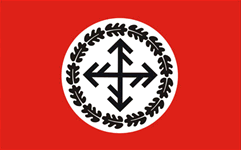 TF Flag #1 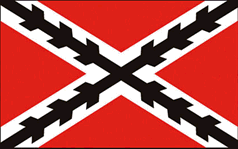 TF Flag #2 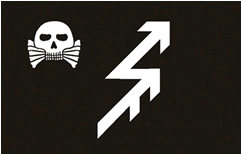 TF Flag #3 |
Third Force (Columbia) Tercera Fuerza The Third Force (Tercera Fuerza), calling themselves a "cultural association," spread the usual distorted neo-Nazi version of the National Socialist world viewpoint. This small group, centered in the City of Pereira, operates a website openly under the protection of Article 20 of the Constitution of the Republic of Colombia, which guarantees full freedom of expression. They trace their origins back to 1956 and the original Third Force movement, whose main goal was to preserve their "pure" Hispanic Heritage.
Claiming that their flags and banners represent the "expression, tradition, and respect for the ideals and legacy of their heritage," they seem to spend a great deal of their time designing flags, seven examples of which are shown here. |
||||||||||||
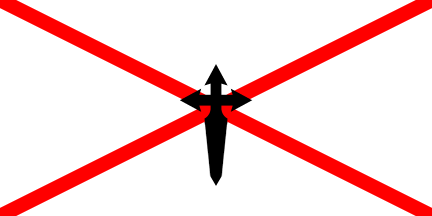 TNSNC Flag |
National Socialist Tercios of New Castile (Peru) Tercios Nacional Socialistas de Nueva Castilla This National Socialist group was active in Peru in the early 2000s and one of the founding organizations of the Peruvian National Socialist Union in 2008. The Tercios, translated as "Spanish Third", or "Spanish Square", was a famous Spanish infantry formation introduced in the 15th Century, and New Castile was the original name of Peru after the Spanish conquest in 16th Century. The TNSNC, like many other neo-Nazi movements, maintained a lightly armed, brown-shirted private militia in the "stormtrooper" tradition, under a white flag with a simplified red "Cross of Burgundy" defaced with a stylized black cross "dagger," which combines the neo-Nazi Arrow Cross and the Spanish Cross of Saint James. |
||||||||||||
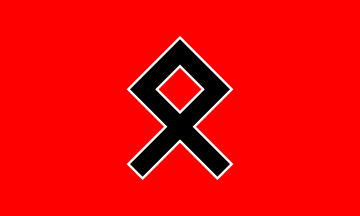 UNSP Flag |
Peruvian National Socialist Union 2008-2009 (Peru) Unio'n Nacional Socialista Peruana The short-lived Peruvian National Socialist Union was founded in 2008 on Hitler's 119th birthday. Their two founding groups were the National Socialist Movement "Peru Awake" (Movimiento Nacional Socialista Despierta Peru) and National Socialist Tercios of New Castile (Tercios Nacional Socialistas de Nueva Castilla). UNSP members wore almost identical uniforms as worn by the MNSDP and the TNSNC, and they derived their insignia and flag from those of the previous founding groups: a simple black odal rune, fimbriated in white, on a plain red field. |
||||||||||||
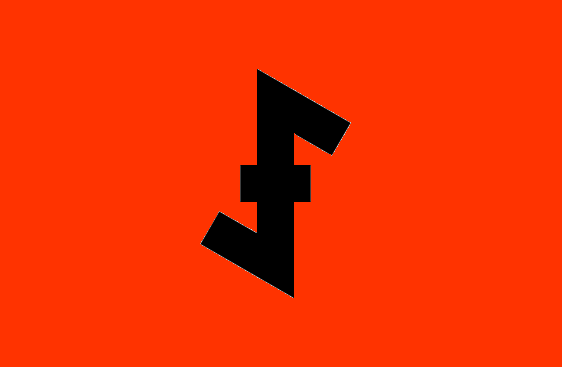 VAM Flag 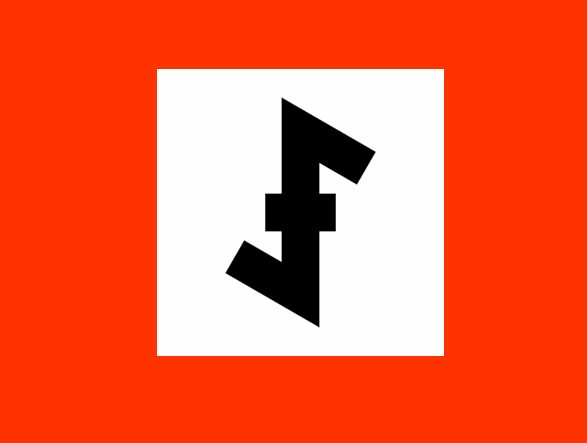 VAM Flag (suspect variant) |
Swedish White Aryan Resistance Movement 1991-1993 (Sweden) Vitt Ariskt Motstånd The Swedish White Aryan Resistance Movement (VAM) was a short-lived Swedish, militant Neo-Nazi organization active between 1991 and 1993. The group was styled on the defunct US White supremacist group "The Order," led by Robert Matthews. VAM was founded by Klas Lund, Torulf Magnusson and Peter Melander, editor of the group's magazine "Storm." The organization's symbol was the "Wolfsangel." In its short existance, VAM was implicated in many serious crimes in Sweden, including the infamous Police-murders in Malexander, car bombings of political journalists and murders of perceived opponents. According to a report prepared and jointly published in November 1999 by Sweden's four largest daily newspapers, Aftonbladet, Expressen, Dagens Nyheter and Svenska Dagbladet, many former members of this violent organization are now members of present-day neo-Nazi organizations. After VAM, Klas Lund went on to organize the Swedish Resistance Movement. Another VAM off-shoot is the Swedish National Socialist Front which was formed in 1994 by VAM sympathisers in Karlskrona. |
||||||||||||
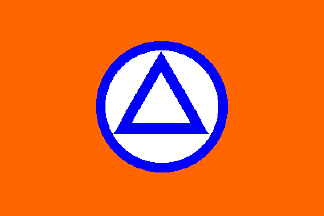 VNV Flag (type #1) 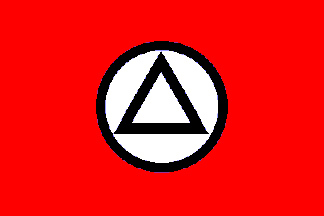 VNV Flag (type #2) |
Flemish National Union 1933-1945 (Belgium) Vlaamsch Nationaal Verbond The Vlaamsch Nationaal Verbond (VNV) was a Flemish Nationalist Socialist political party in Belgium, founded by Staf de Clerq in 1933. De Clerq became known as "den Leider" (The Leader). The VNV was tied to the idea of uniting the many Flemish parties in Belgium into a single movement, and the creation of a pan-Dutch state, called Dietsland, to include both Flanders and the Netherlands. Its slogan was "Authority, discipline and Dietsland." De Clerq died suddenly in 1942, and was succeeded by Hendrik Elias. Elias continued the collaboration with the Germans, but also tried to prevent the installation of a civilian government, which would be composed of Nazis. Elias failed, as Hitler installed the new body and declared the annexation of Flanders by Germany in 1944. Seven weeks later, Belgium had was liberated by the Allies. The VNV was outlawed after the war, and Elias was put in prison. The flag of the VNV is orange with a white disc bordered blue and charged with a blue voided triangle. Blue, white and orange are the colours of the (united) Netherlands. The blue triangle is the delta symbol, the Netherlands being the delta of major European rivers: Rhine, Meuse and Scheldt. There was also a red/black/white version that was widely used. This one was based directly on the swastika flag of Nazi Germany, using the exact same colors. |
||||||||||||
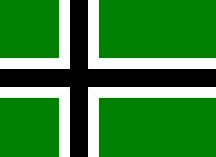 Vinland Flag |
Vinland Flag (USA)
The Vinland flag is a contemporary flag first used by the musical group Type O Negative to encompass a variety of leader Peter Steele's interests and political beliefs, including his own Icelandic heritage. The flag is designed in the style of a Nordic Cross flag, with a green field and a black cross with white fimbriation, the green and black being a common color scheme for Type O Negative. The Vinland flag is used by white racialists worldwide to represent a unified homeland containing North America, Greenland, Iceland and northern Europe. Vinland flags are also sold by Stormfront.org, a neo-Nazi website. |
||||||||||||
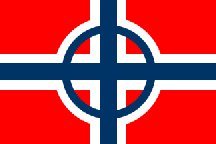 Vargsmal "Vigrid" Flag 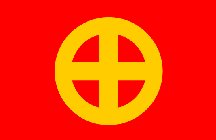 Nasjonal Samling 1933-1945 |
The Vigrid Party (Norway)
Vigrid is a Norwegian neo-Nazi organization which combines racial teachings with the imagery of Norse mythology. Vigrid was founded in 1998, and in 2009 they ran for the parliamentary elections, but received less than 200 votes. The group has been known to display versions of the flag of the World Church of the Creator, as well as a flag displaying a fimbriated sun disc centered on the national flag. Vigrid claims that non-Aryans are guilty of all the turmoil and problems around the world. They argue that the white race needs protection against extinction because of increased immigration of non-Aryans. They consider Adolf Hitler as a "savior," and deny the Jewish Holocaust claiming that the Jews were killed in the Allied bombings. They believe that the Jews now exploit the Holocaust for political and financial support. They are also appear to oppose Christianity, Islam, blacks and gays, but claim to distance themselves as a group from the use of all "offensive" violence. The Vargsmal "Vigrid" flag design shown here is taken from a book called Vargsmal. It was written by Varg Vikernes, a Norwegian black metal musician, convicted murderer, arsonist, and religious, political and nationalist activist. The second flag shown is that of the Norwegian Nazi party Nasjonal Samling, which used this golden sun cross on a red background as its official symbol from 1933 until 1945. The cross within a circle was ascribed to Saint Olaf, the patron saint of Norway, and the colors were those of the coat of arms of Norway. |
||||||||||||
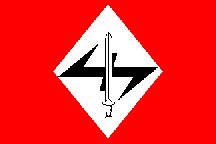 VAM Flag 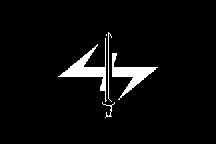 VAM Flag (black variant) |
White Aryan Resistance (Sweden)
The White Aryan Resistance (Vitt Ariskt Motstånd - VAM), was a militant neo-nazi group active in Sweden in the years 1991-1993. The name of the group was taken from the US White supremacist organization WAR. VAM was founded by Klas Lund, who later went on to organise the Swedish Resistance Movement (Svenska Motståndsrörelsen) and the National Socialist Front (Nationalsocialistisk Front, NSF) which was formed in 1994. The symbol behind the sword is the ancient german rune for "Wolf's Angel," or werewolf. In the past this rune was a magical means to frighten away werewolves. According to ancient superstitions men were sometimes transformed into beings, half men, half wolves, that were extremely blood-thirsty and ferocious. These beings were called werewolves. In World War II, this sign was used by the Division Waffen SS Das Reich. This National Socialist flag features the "Wolf's Angel" sign, and was used in Sweden in the 1990s. Two variants of the flag are shown to the left, but the one with the red field was used the most. It is interesting to note that "Werewolves" was the name chosen for the guerrilla fighters Hitler and the Nazi planned to use to continue the fight against the invading Allies when Germany’s Wehrmacht was defeated and the German territory was occupied. |
||||||||||||
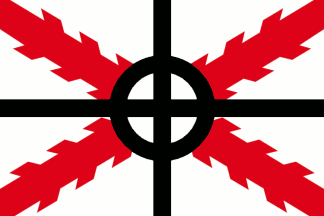 VB Flag |
White Vision (Mexico) Visio'n Blanca The White Vision is a Mexican neo-Nazi group which claims to be the only true follower of National Socialism in the country and declares its goal to be the "protection of white race", which would eventually be achieved by creation of a separate country for Mexican people of European origin. These, according to them, should not be considered Mexicans any longer, but a separate nation, called simply the Creoles (El Criollos). The flag of White Vision is derived from the Cross of Burgundy flag, which symbolizes the Spanish origin of Creoles, by superimposing a black Celtic cross with arms extended up to the flag edges, thus employing the complete set of Nazi colors. |
||||||||||||
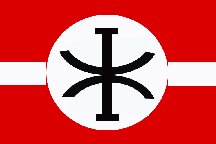 Vlajka Flag |
The Flag Movement 1928-1942 (Czech Republic/Slovakia) Vlajka Vlajka, which means in Czech "The Flag," was the name of a Czechoslovakian fascist and nationalist movement which became politically active in the 1930s. Their leader was Jan Rys-Rozsévac, a journalist and politician. The group publication, also called "Vlajka," was founded in 1928, its first editor was Miloš Maixner. During 1939-1940 Vlajka organized mass meetings against politicians of the First Republic of Czechoslovakia. Vlajka was disbanded at the end of 1942 after it lost the support of the German occupational forces and the Vlajka leadership, including Rys-Rozsévac, were sent as "privileged" prisoners to the Dachau and kept here until the end of the war. After the war Rys-Rozsévac, and three of his coworkers (Josef Burda, Jaroslav Cermák and Otakar Polívka), were sentenced to death by Czech authorities. |
||||||||||||
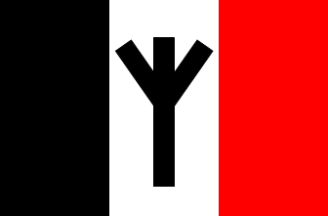 Volksfront Flag |
Volksfront Flag (USA)
The American neo-Nazi organization Volksfront, headquartered in Oregon, wants a white homeland in the Pacific Northwest. The group was founded in 1994 in the Oregon State Penitentiary by Randall Krager. Although, since its formation, the group claims to have chapters in Oregon, Massachusetts, Arizona, California, New York, Pennsylvania, North Carolina, South Carolina, Washington State, Illinois, and Missouri, they only had approximately 100 members in 2007. The Southern Poverty Law Center (SPLC) has added Volksfront to its list of hate groups. The Anti-Defamation League has called the group "one of the most active skinhead groups in the United States." The flag of Volksfront is a vertical tricolor of black-white-red with a black life rune centered on the white stripe, and while it seems to be based on an earlier design used by the National Alliance in the 1970s, no actual connection between the two extremist groups is known. |
||||||||||||
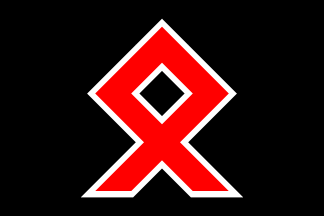 WJ Flag |
The Viking Youth (Germany) Wiking-Jugend The Viking Youth was modeled after the Hitler Youth and named after the Viking League (Bund Wiking), a far-right movement from the 1920s, as well as the SS Division "Wiking." It was founded in 1952, after the Socialist Reich Party and its youth wing, the Reich Youth, were banned. Originally led by Walter Matthaei, former leader of the Reich Youth who emigration to Spain, it was taken over by Raoul Nahrath, who was succeeded first by his son Wolfgang and then by his grandson Wolfram, thus founding an informal dynasty of Nazi leaders. It was registered in 1974 in Stolberg, North Rhine-Westphalia, and in Berlin since 1991. The attempt to register its branch in Austria was rejected in 1980, the decision confirmed by the Constitutional Court the next year. In 1994, the main body was banned by the Federal Ministry of the Interior, which was confirmed by the Federal Administrative Court in 1999. It was the largest neo-Nazi youth movement at the time, with 400 to 500 members. The Viking Youth used a black flag with large red odal rune, fimbriated white. This symbol was banned along with the party. |
||||||||||||
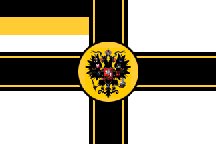 White Legion 88 Flag |
White Legion 88 Flag (Russia)
This flag is, of course, a variation of the Imperial German War Ensign, undoubtedly inspired by German World War I and World War II flags, and used by the Russian neo-Nazi organization White Legion 88. Eighty-eight is used as code among Neo-Nazis to identify each other. H is the 8th letter of the alphabet, so 88 is taken to stand for HH which in turn means Heil Hitler. For example, the number is used in the song "88 rock'n'roll band" by the neo-Nazi group Landser. The late convicted Order terrorist David Lane wrote "Fourteen Words" and 88 Precepts, and the numbers are often found in combination (1488, 14/88, etc.). This form of the number has inspired the naming of the groups Column 88, Unit 88, and White Legion 88. |
||||||||||||
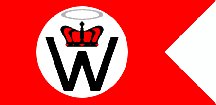 WCOTC Flag (Swallow-tailed variant, filled halo) 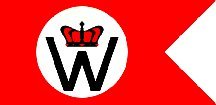 WCOTC Flag Rectangular-shaped variant (Mock white swallow-tail, no halo)  Creativity Movement Flag (Swallow-tailed with hollowed halo) |
World Church of the Creator Flag (USA)
One of the fastest-growing hate groups in the 1990s was the World Church of the Creator (WCOTC), based in East Peoria, Illinois, whose stated goal is "making this an all-white nation and ultimately an all-white world." The current group sometimes calls itself "The Creativity Movement" and is an often violent white separatist organization that advocates a whites-only religion, Creativity. They consider Jews and nonwhites, whom they refer to as "mud races," to be the "natural enemies" of the white race. The movement's use of the term creator, however, does not refer to a deity, but rather to themselves, and despite the formal use of the word Church in its name, the movement is atheistic. 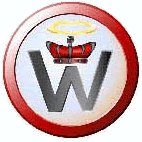 Current Creativity Movement Logo (with gold hollowed halo) Throughout the years there have been a series of slightly different variants of the WC flags and emblems reported and seen. The halos have been either gold or silver, hollow or not hollow, present or not present, and the flags themselves have been both swallow-tailed or mock swallow-tailed (with a white filled triangular shape on the fly instead of an actual swallow-tailed cut away). Currently the mock-swallowed tailed version seems most prevalent. |
